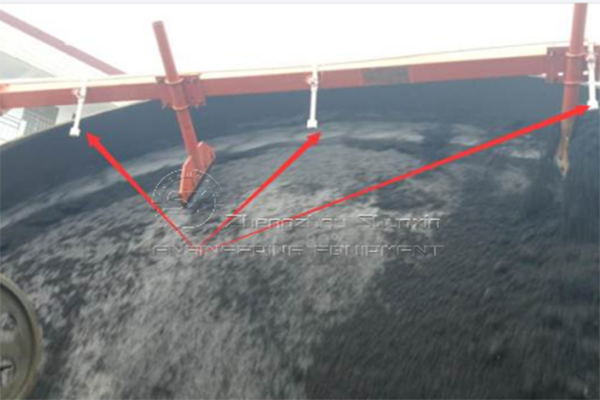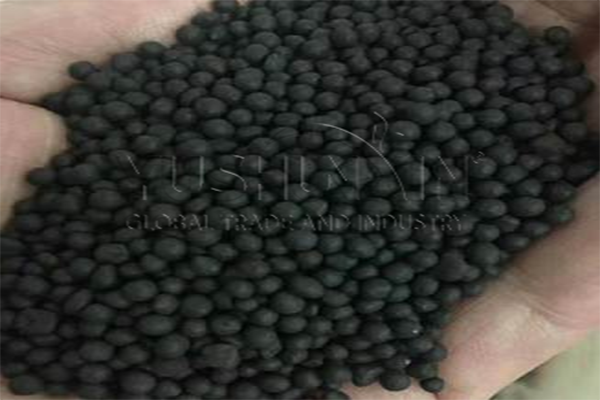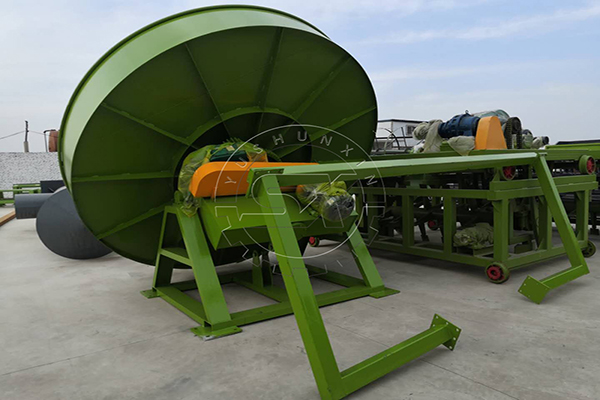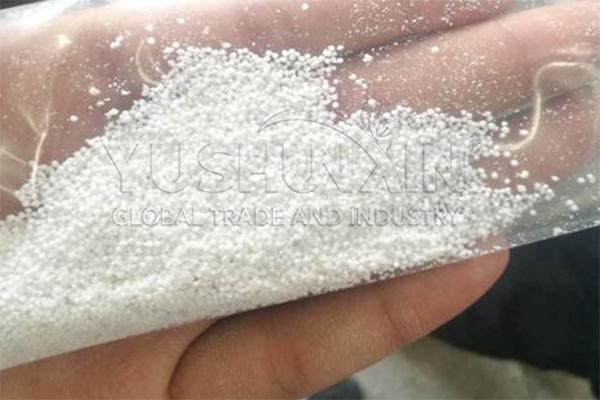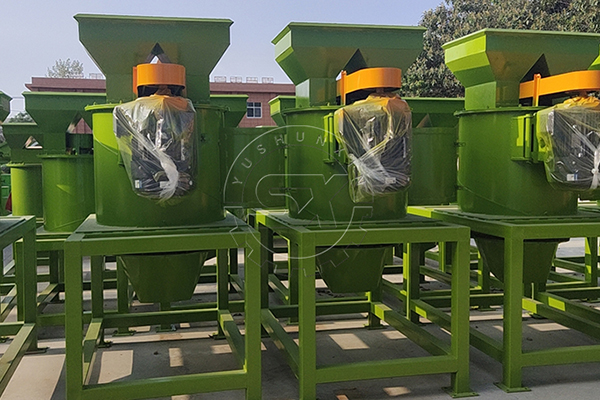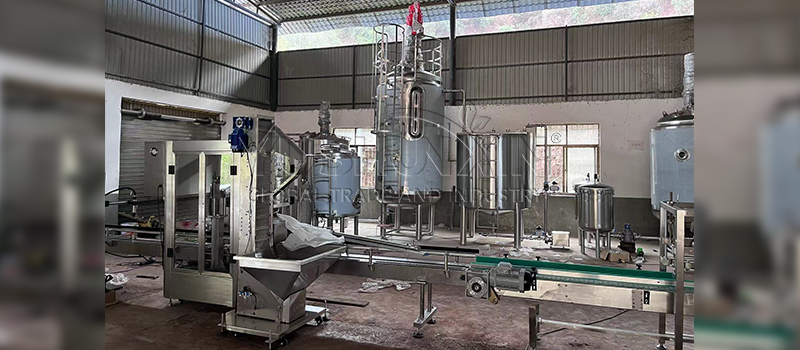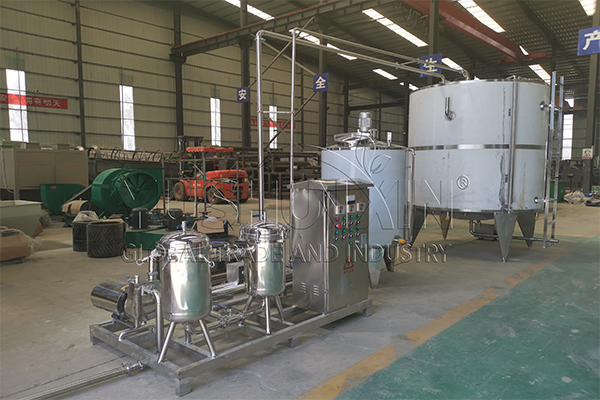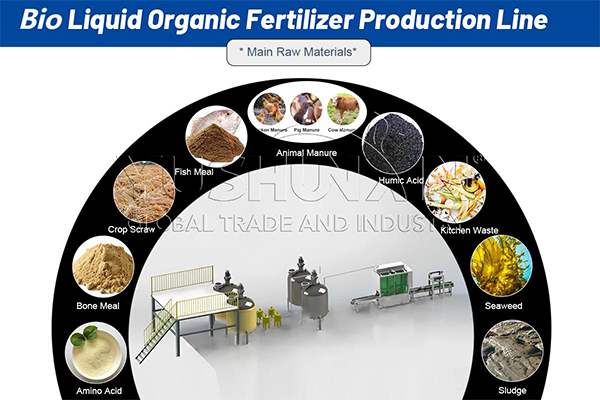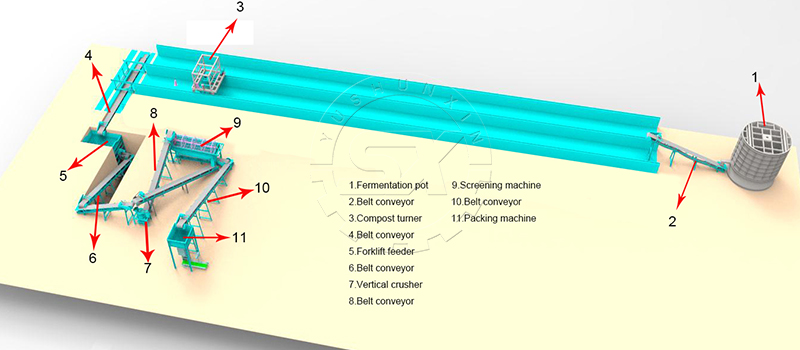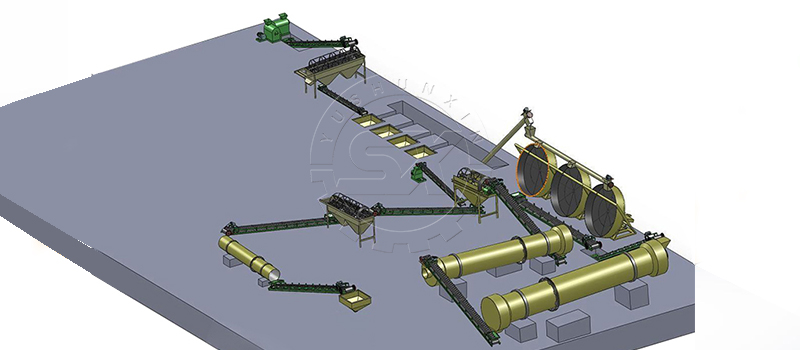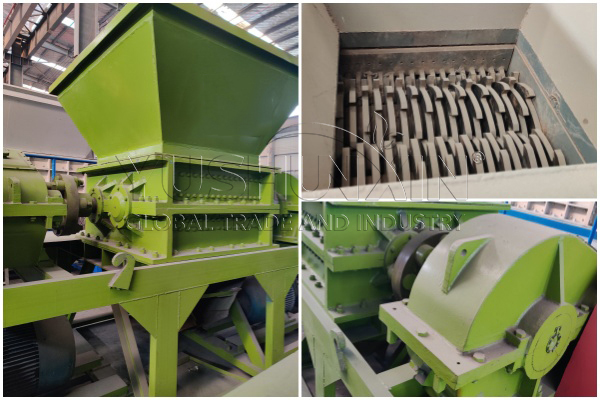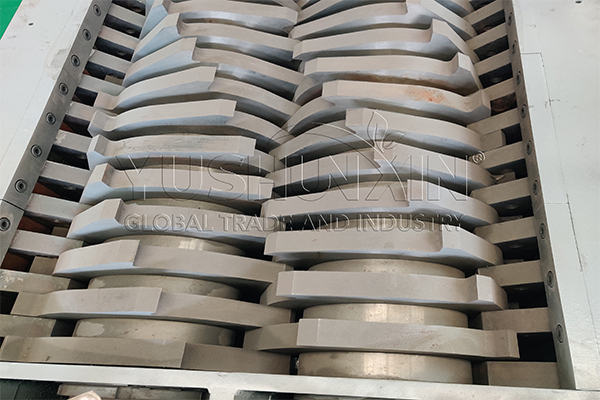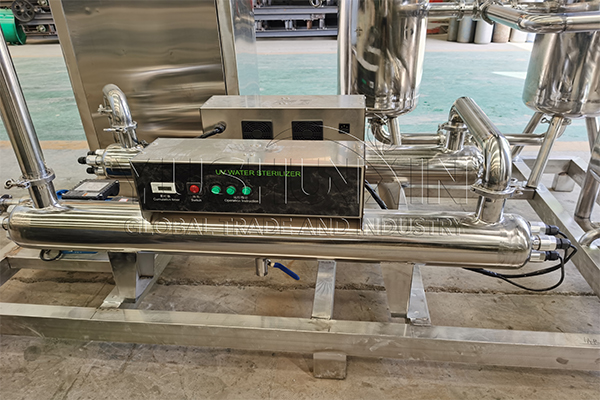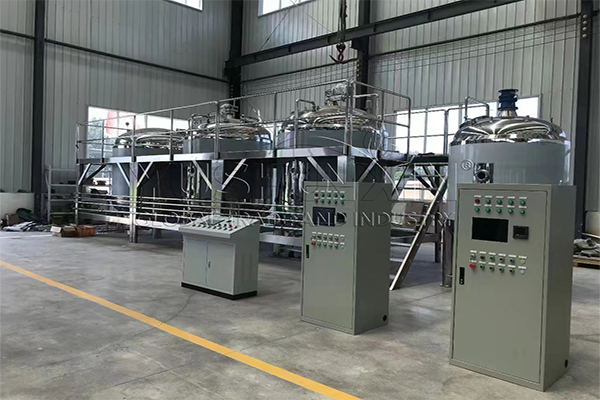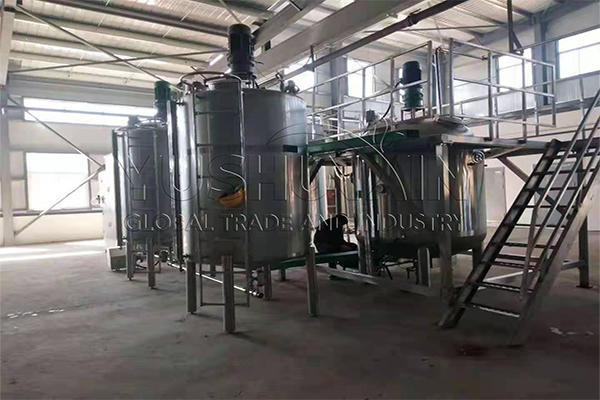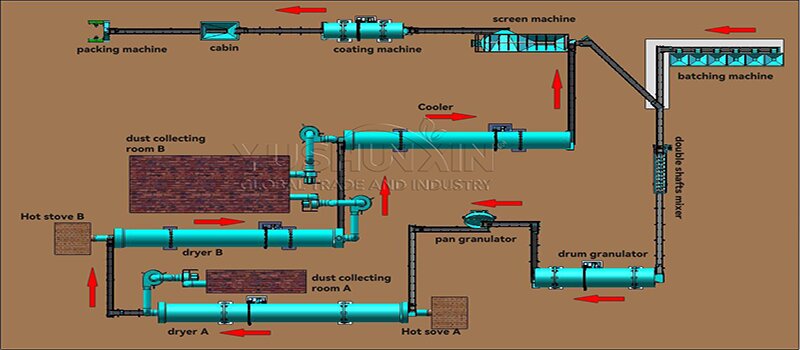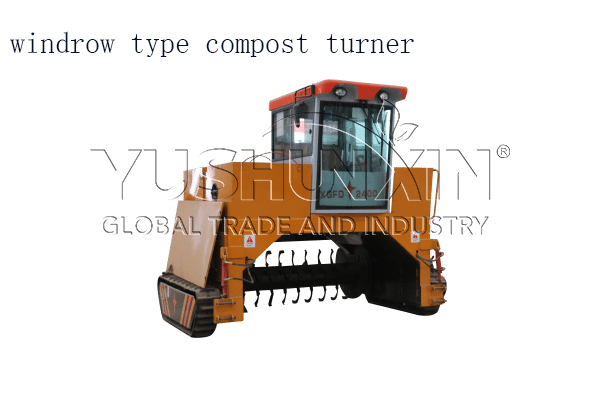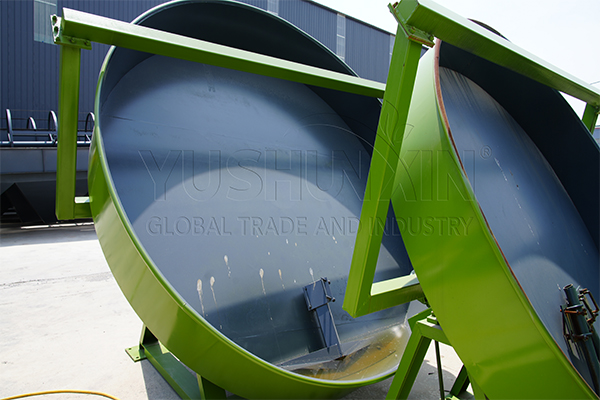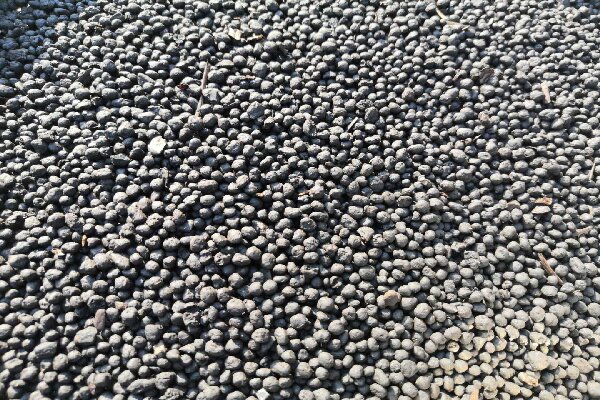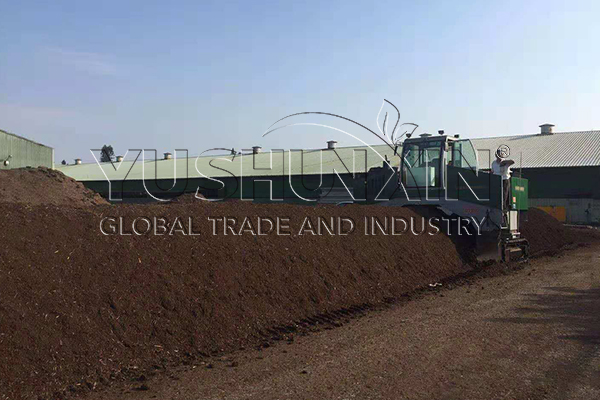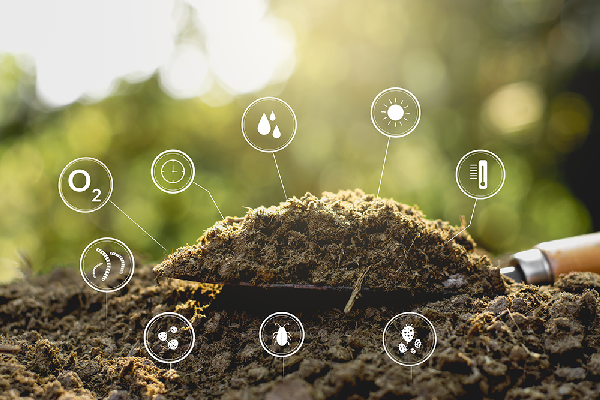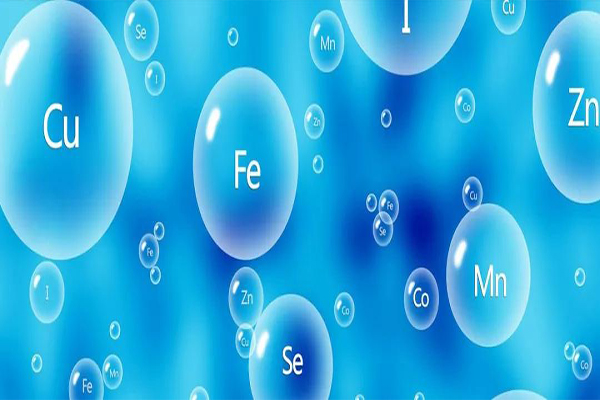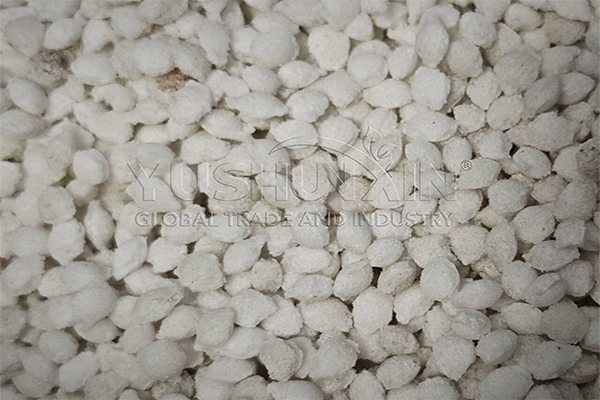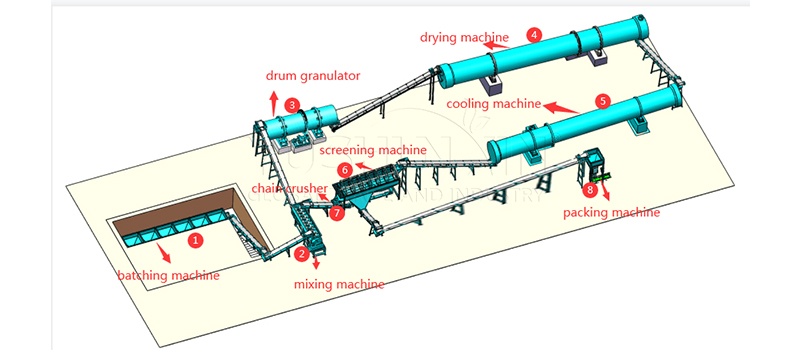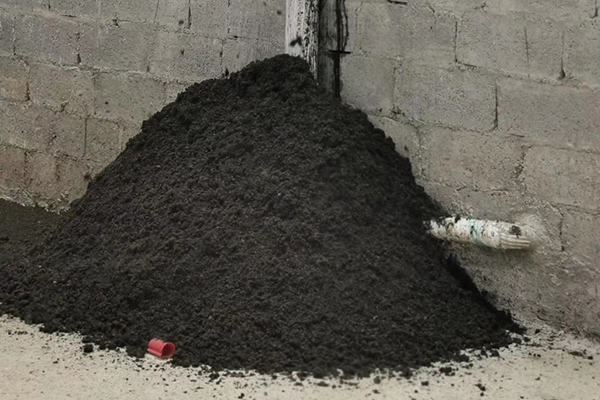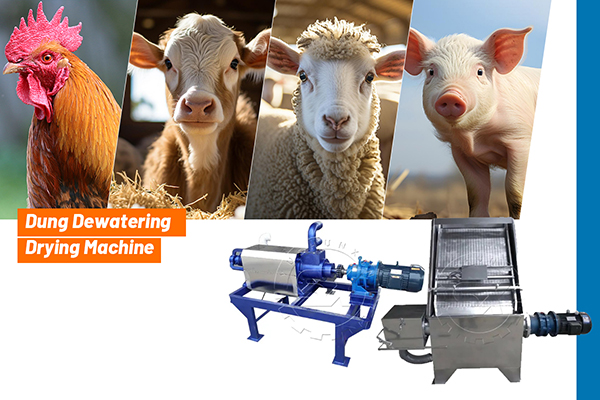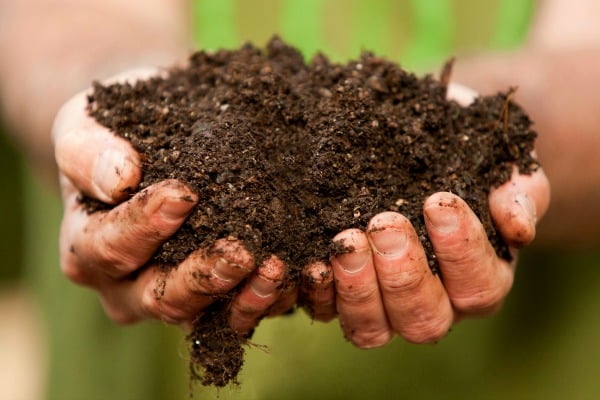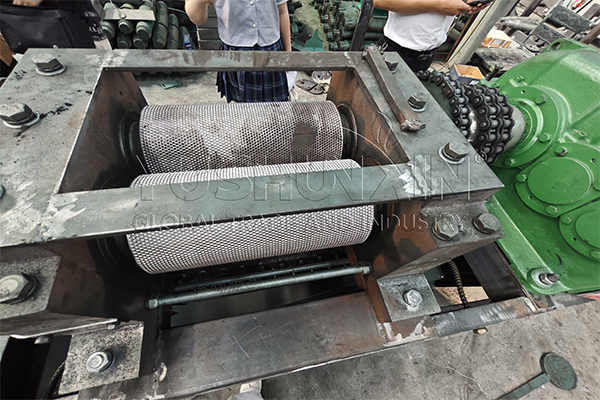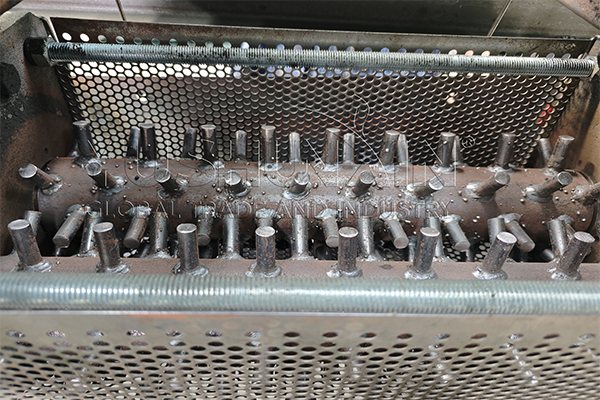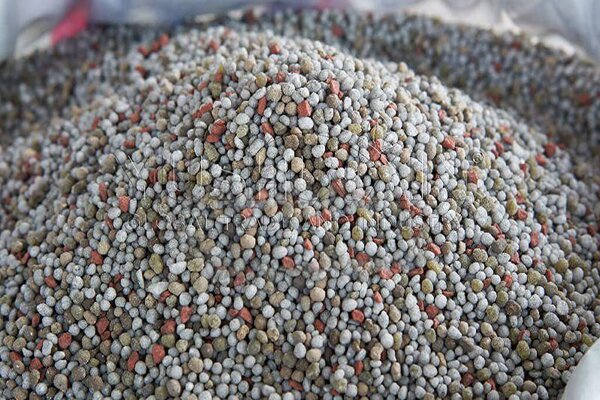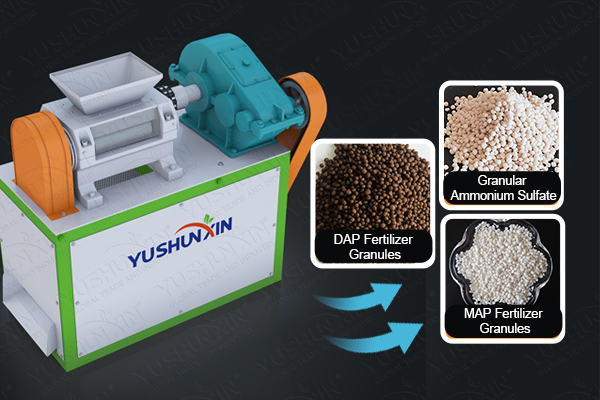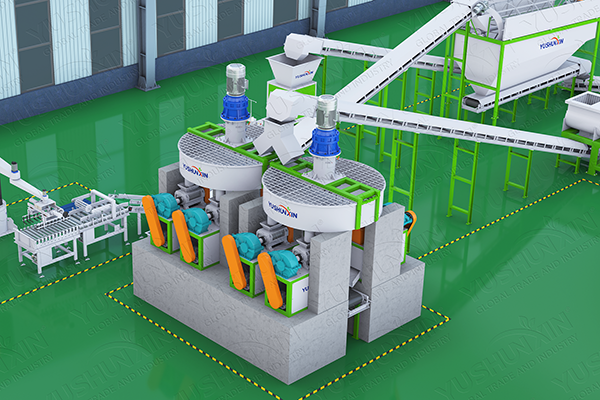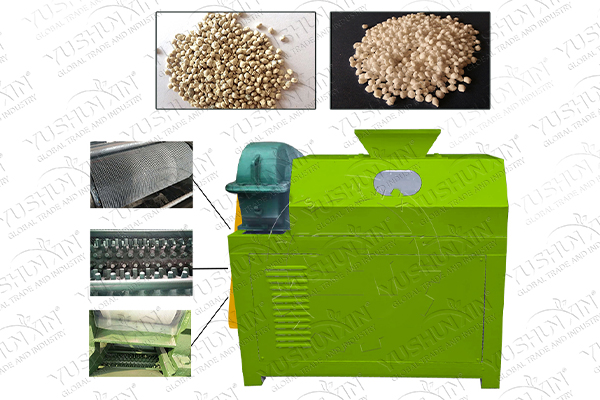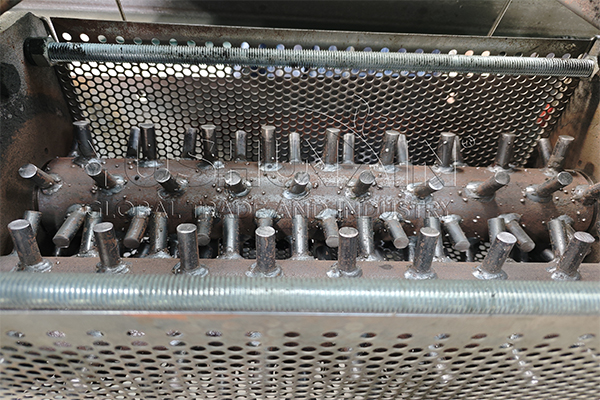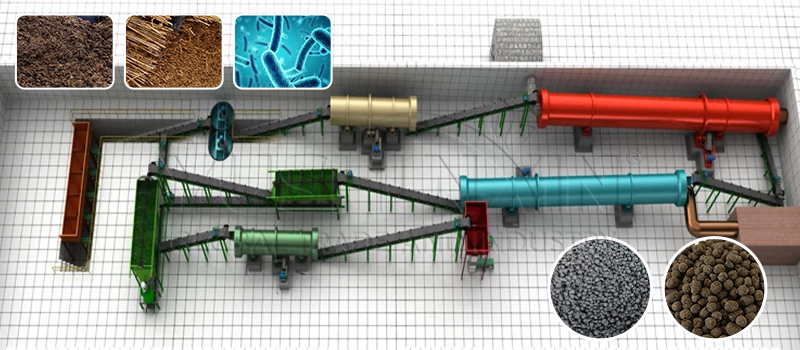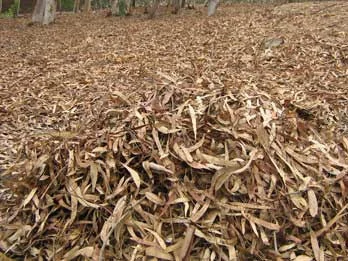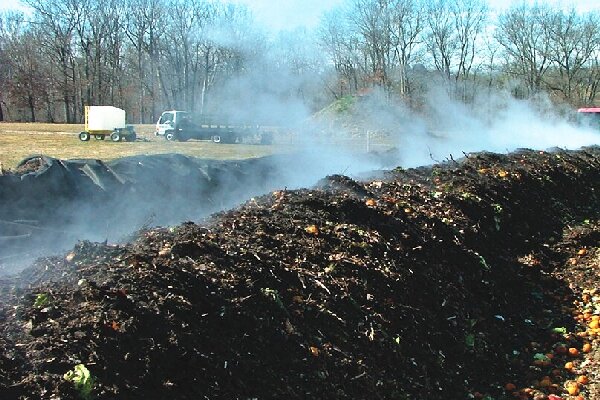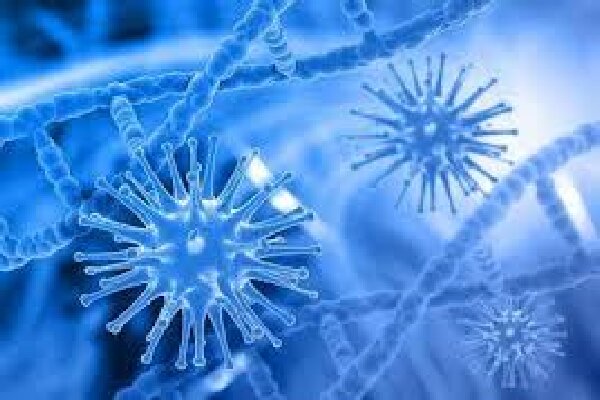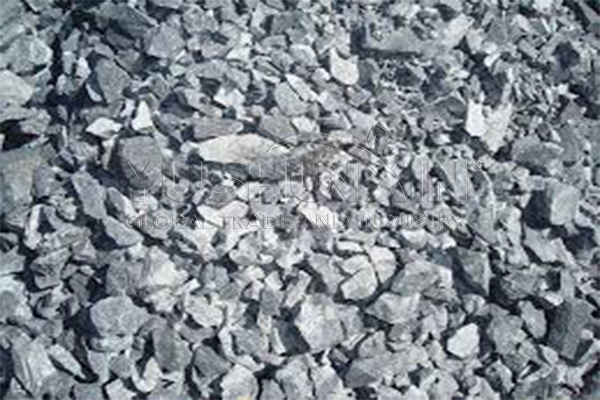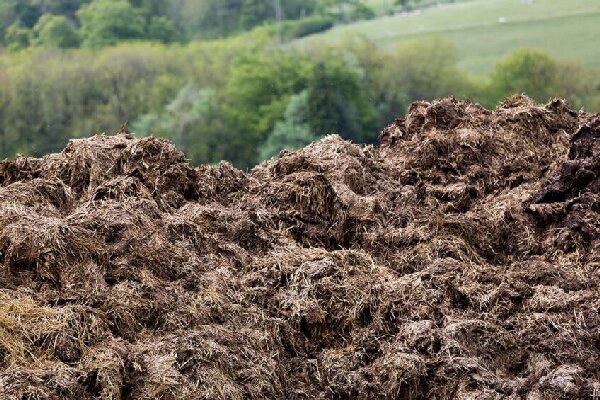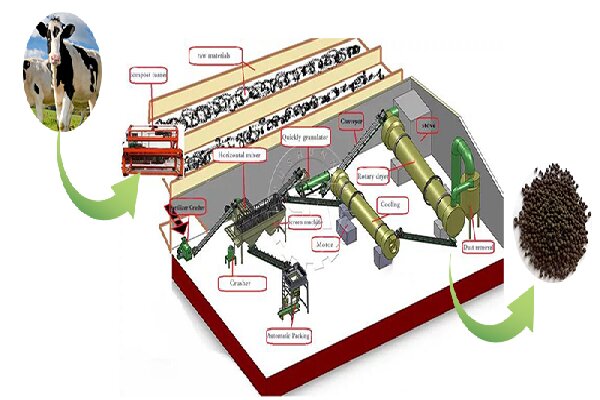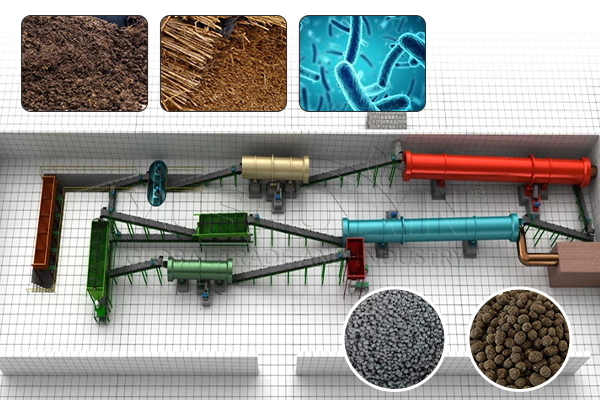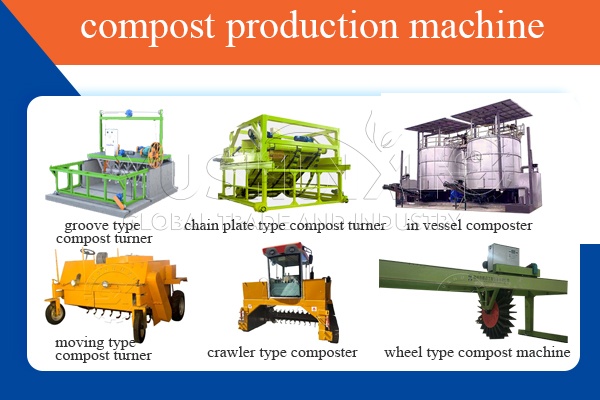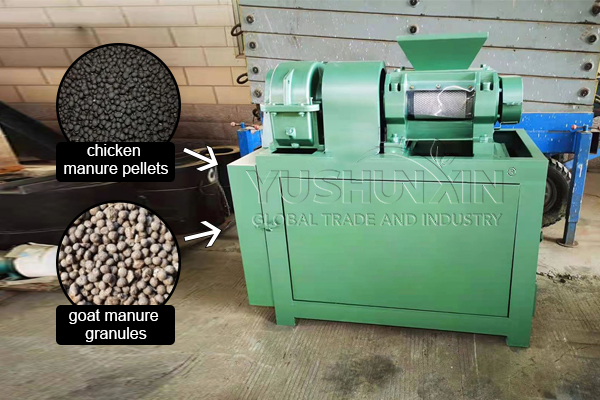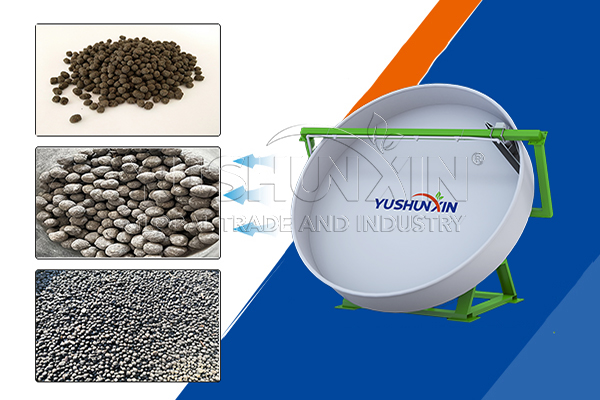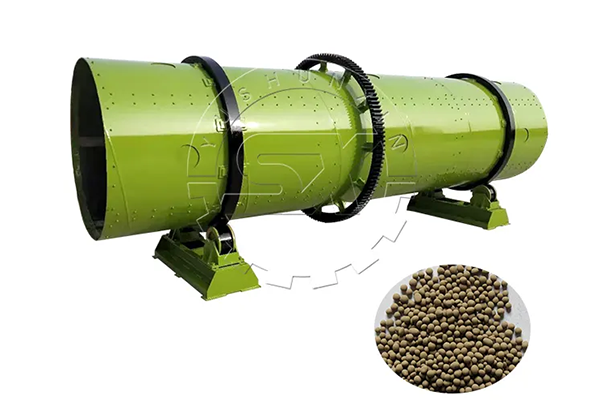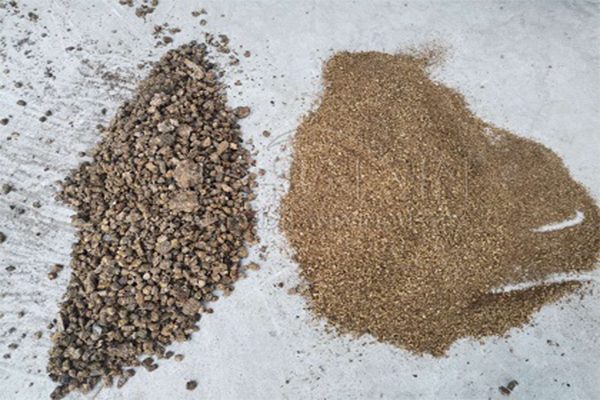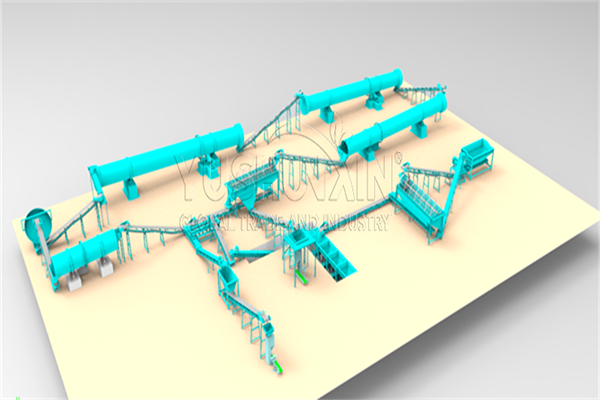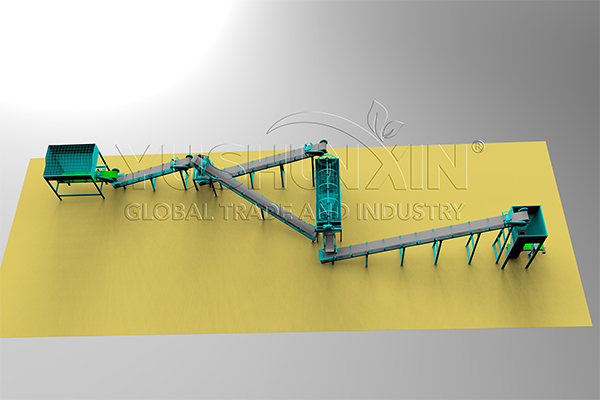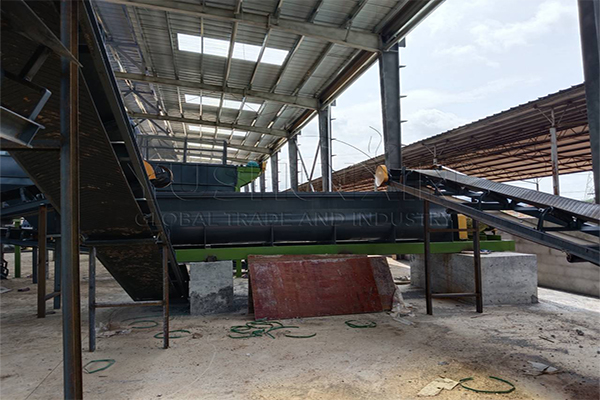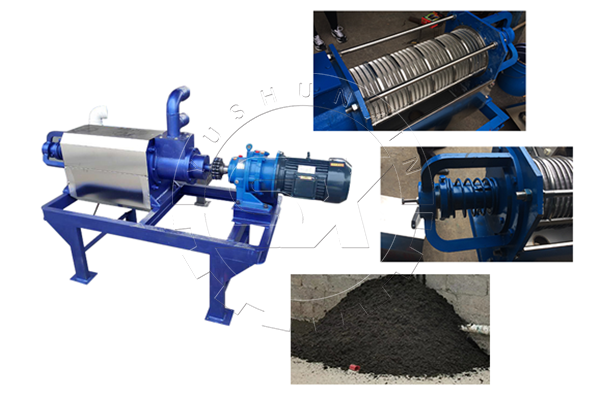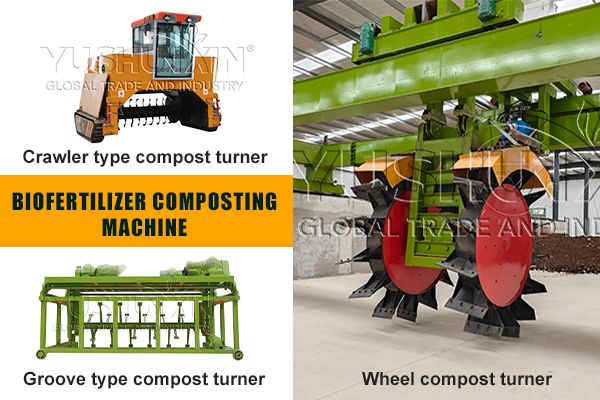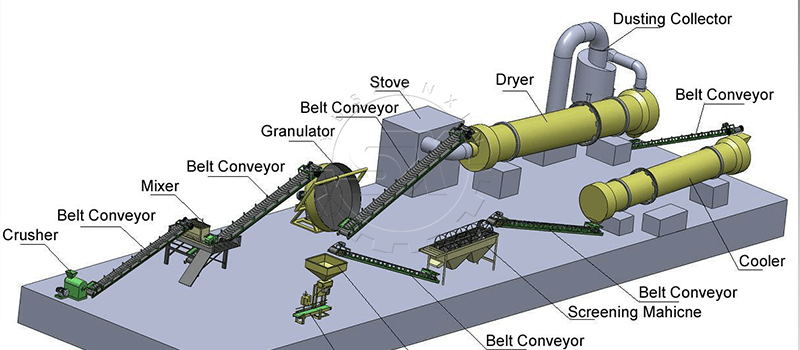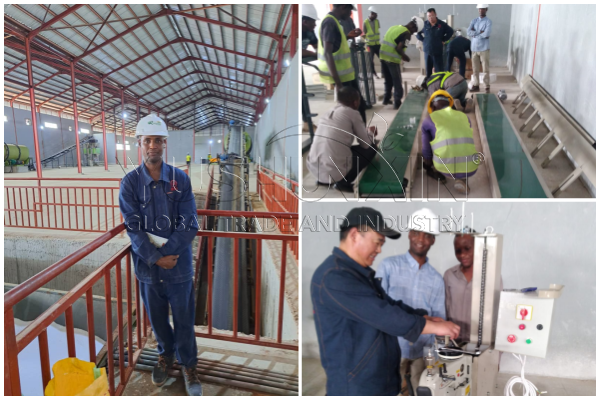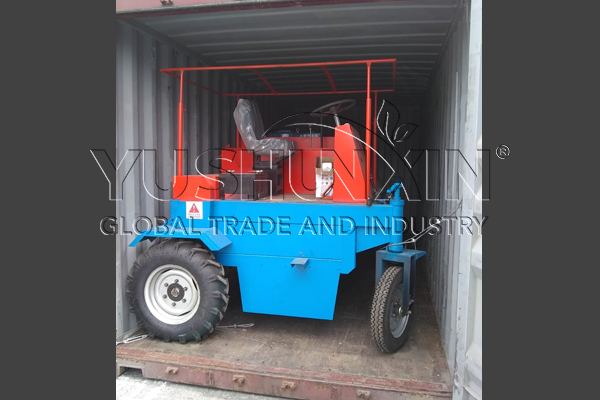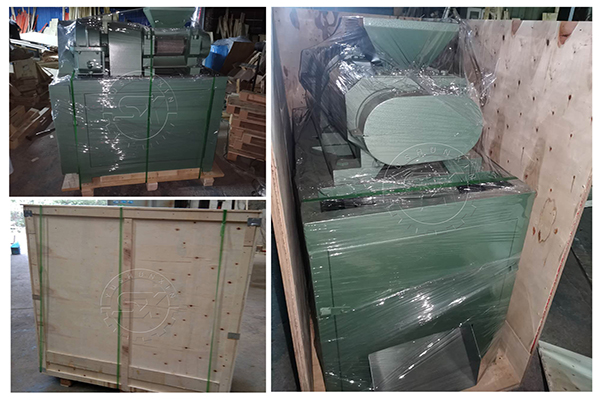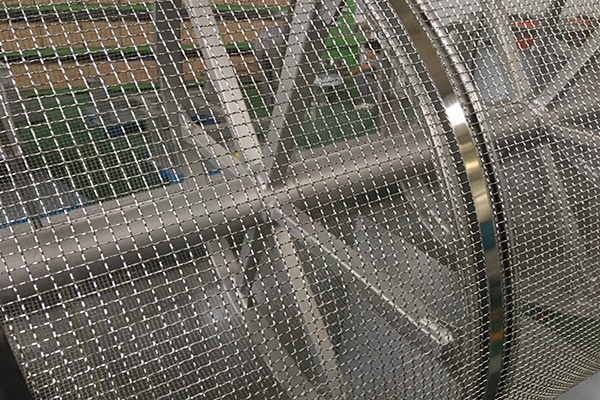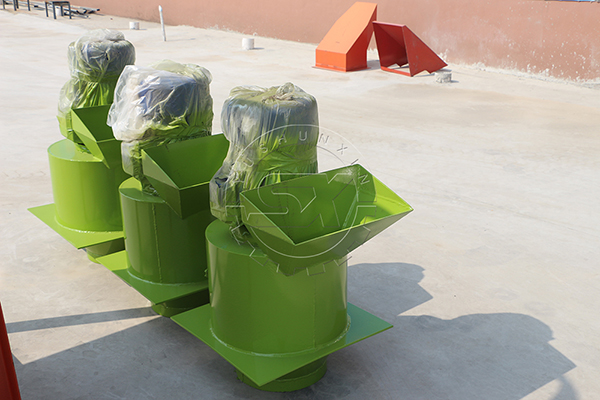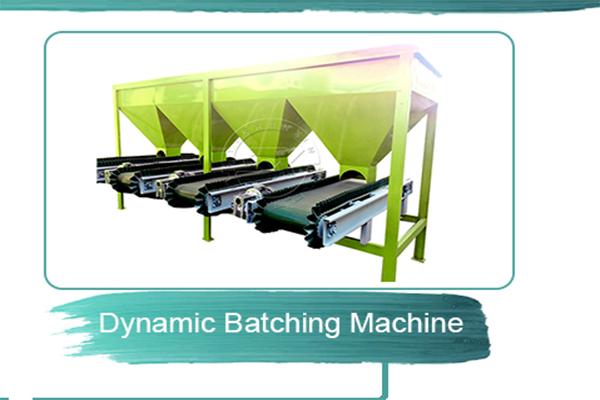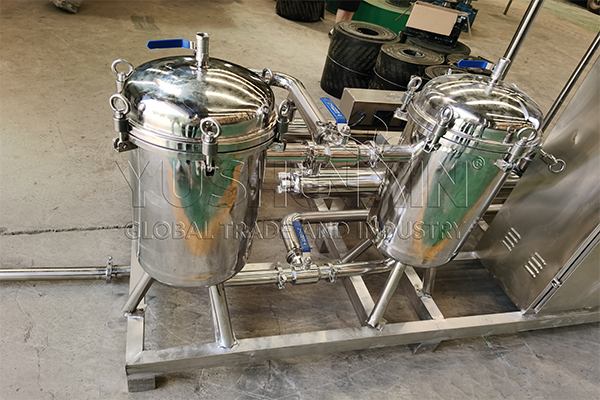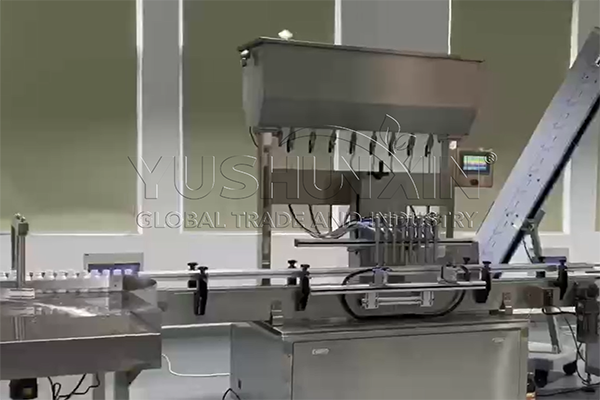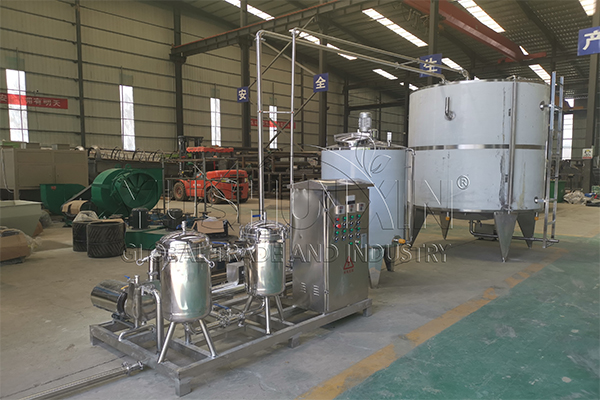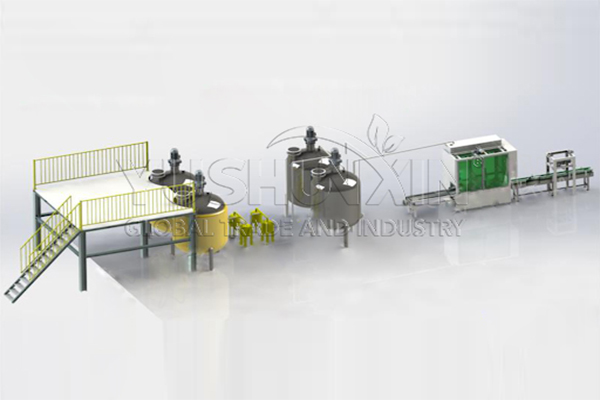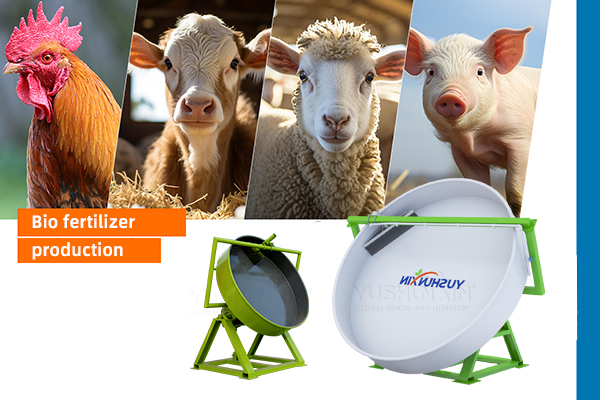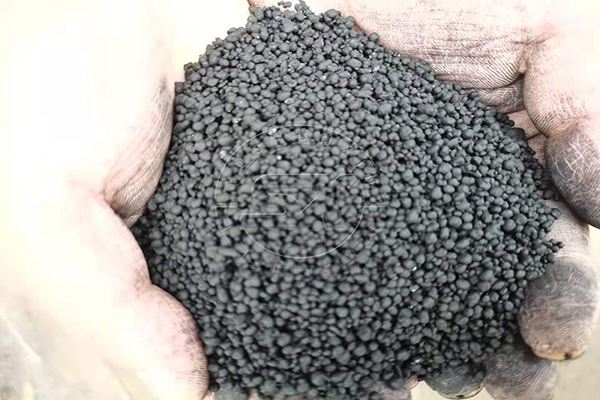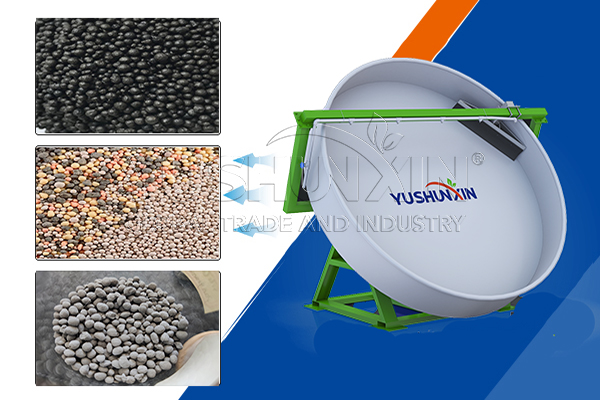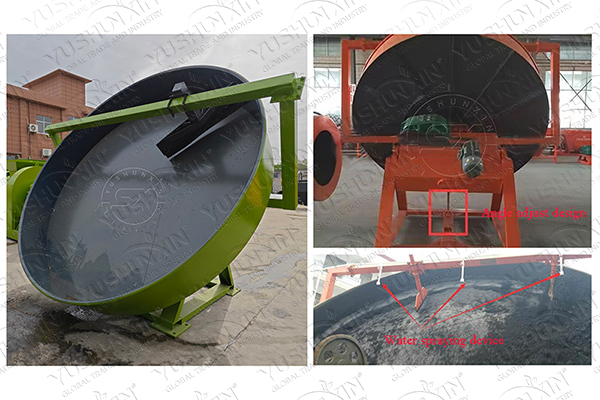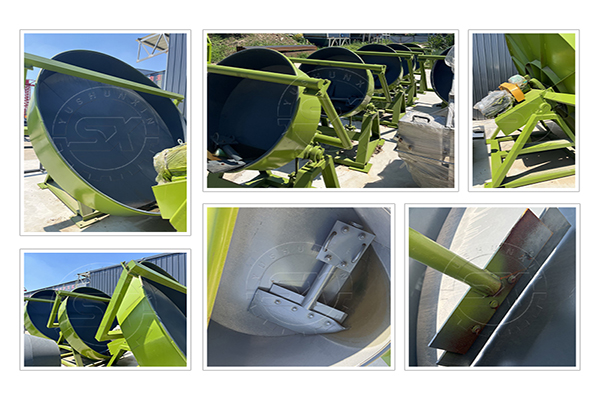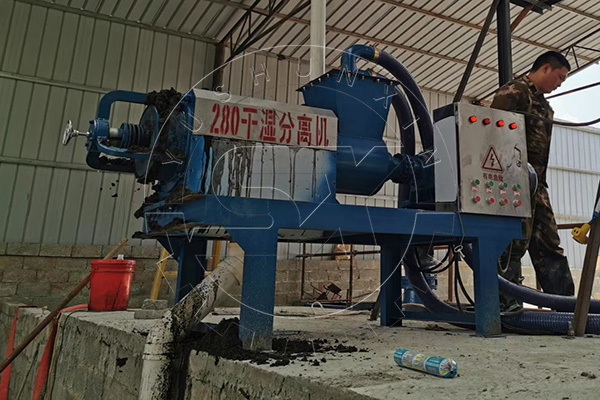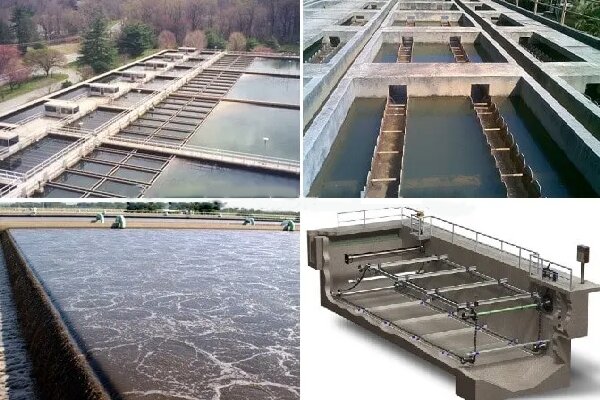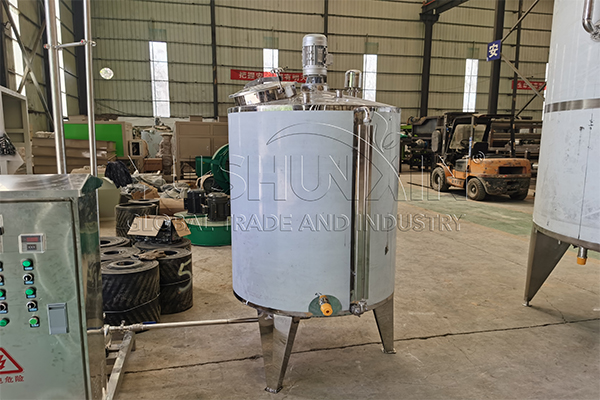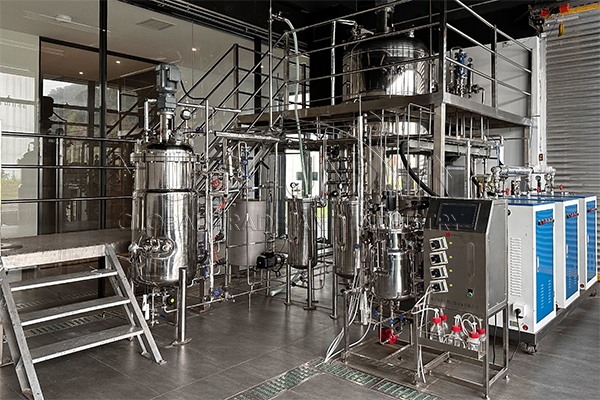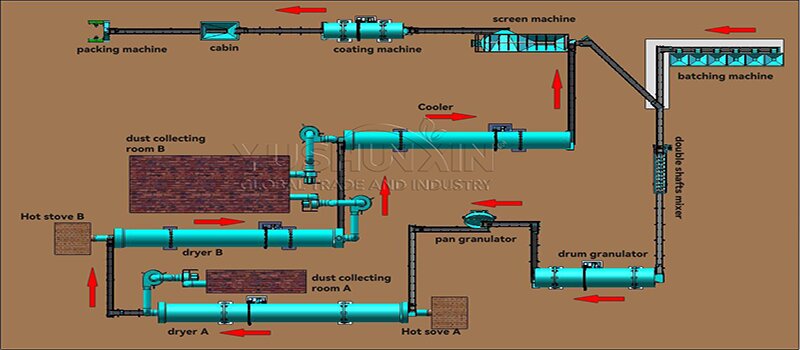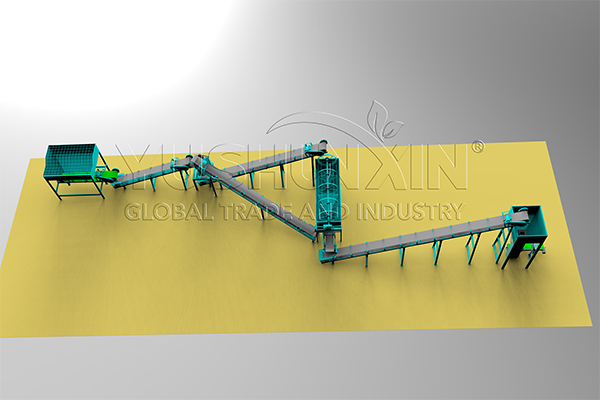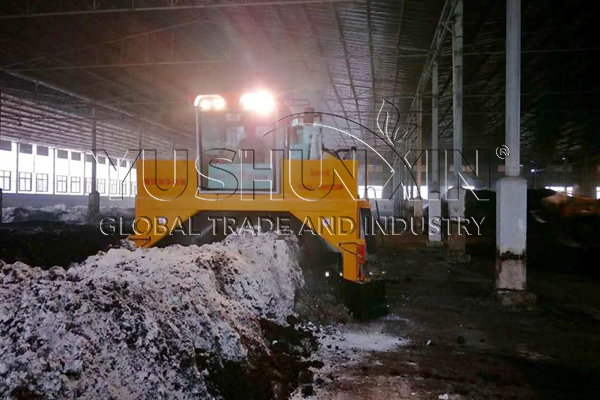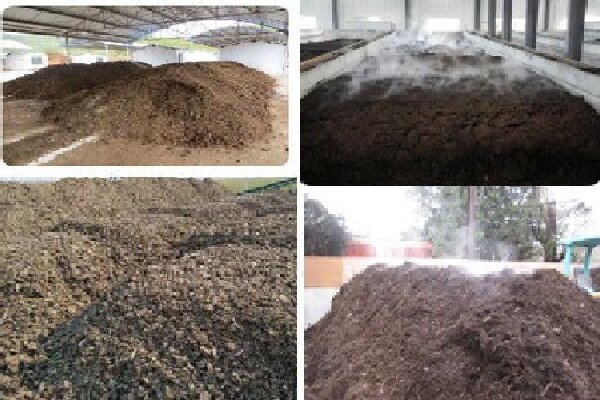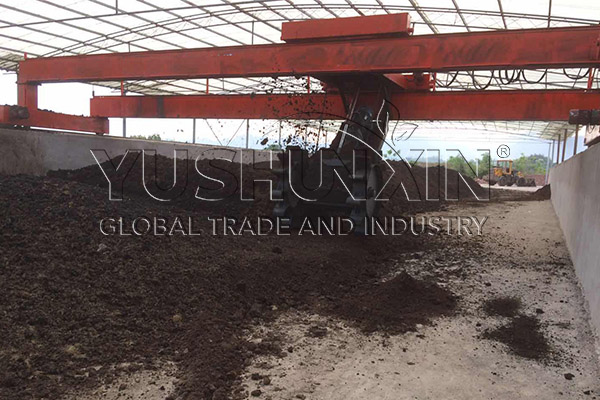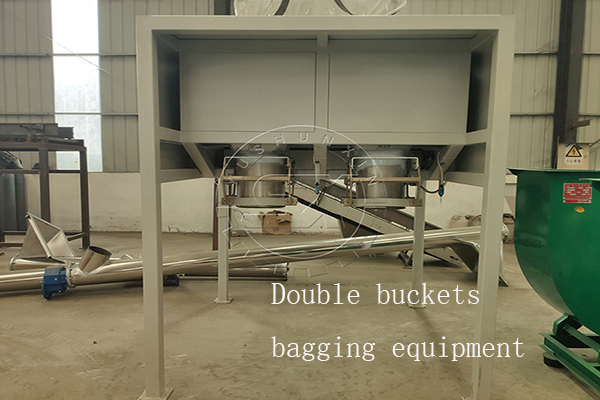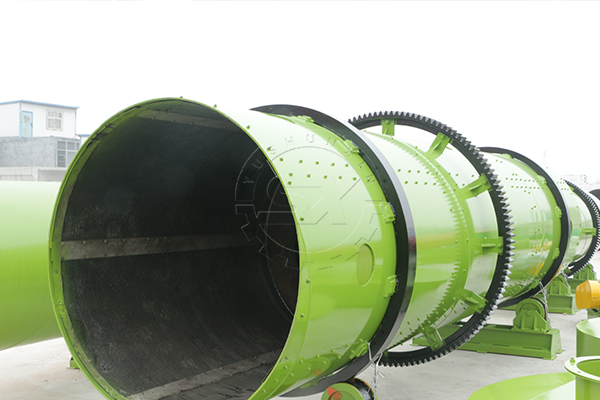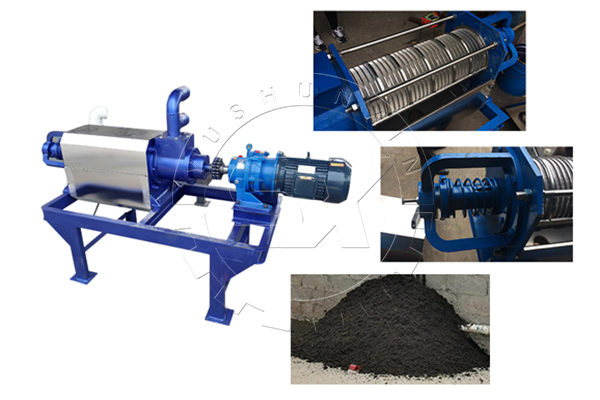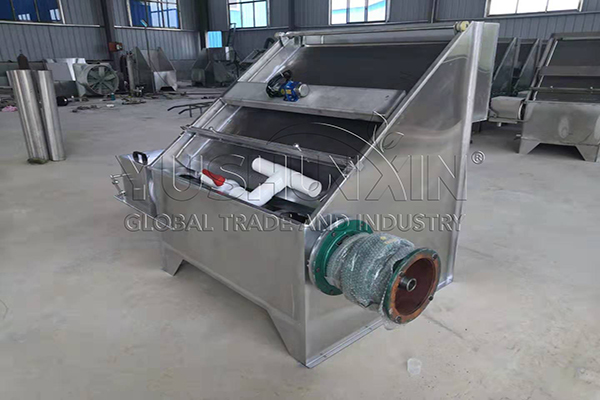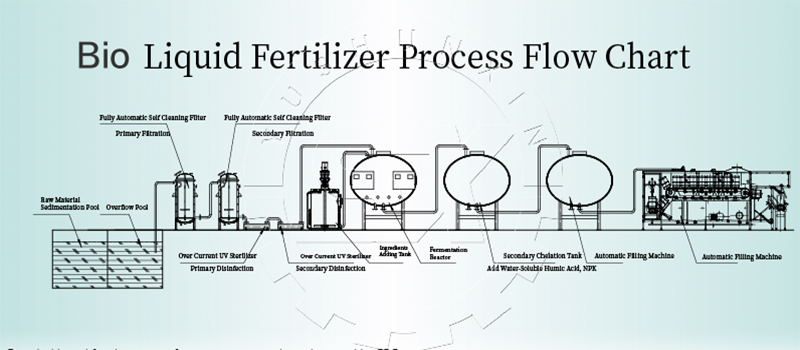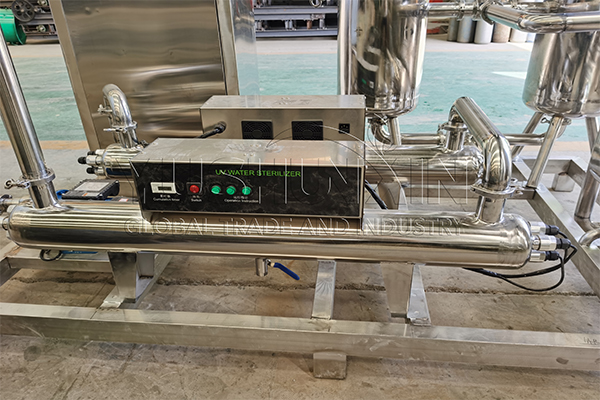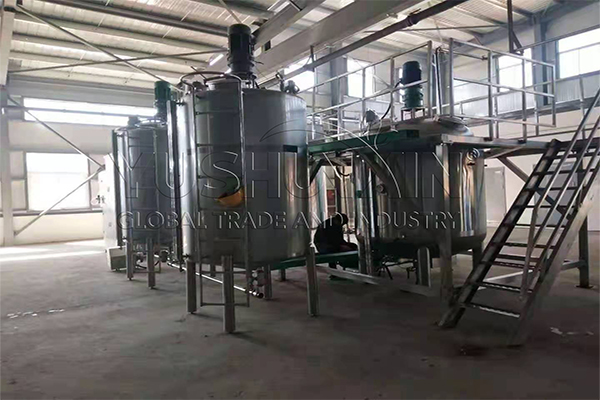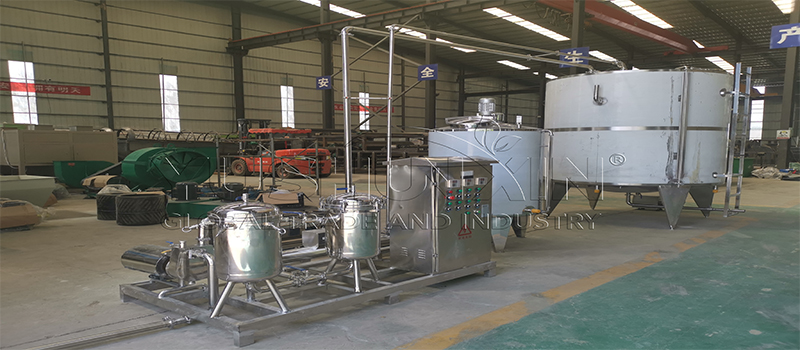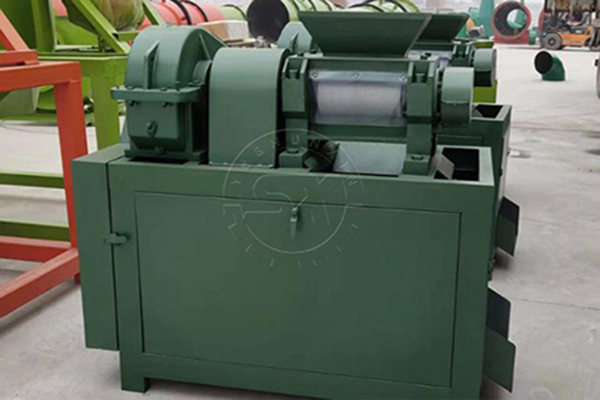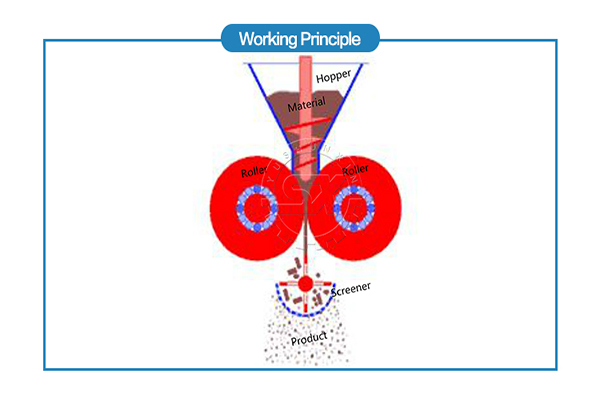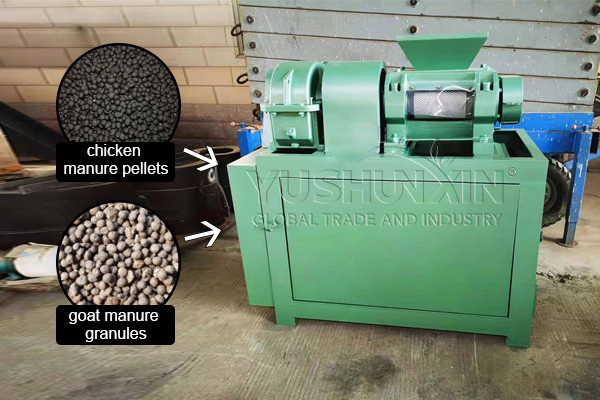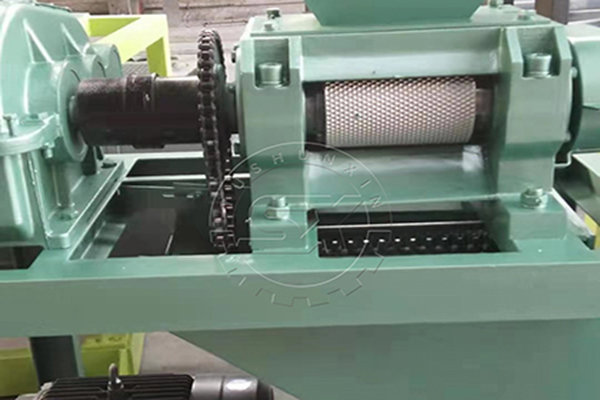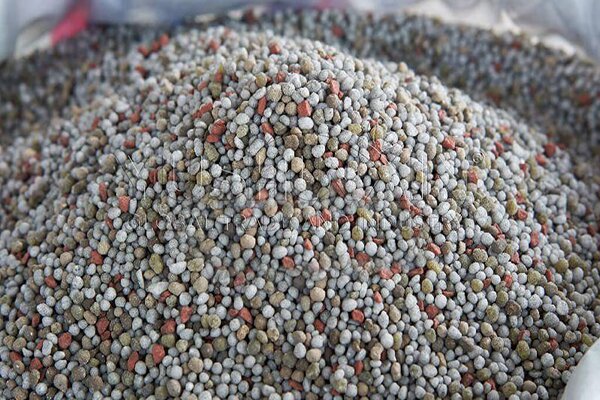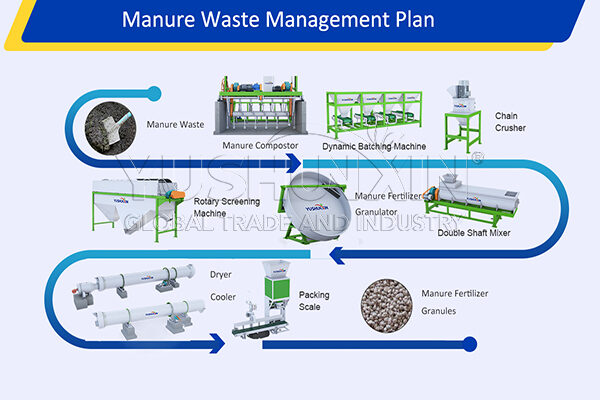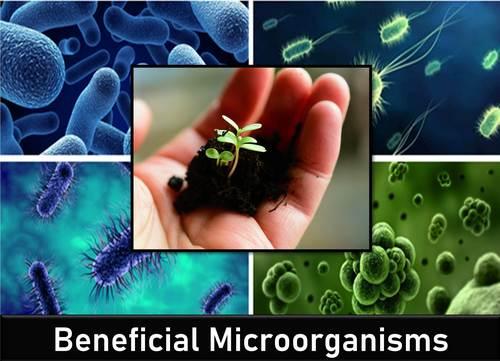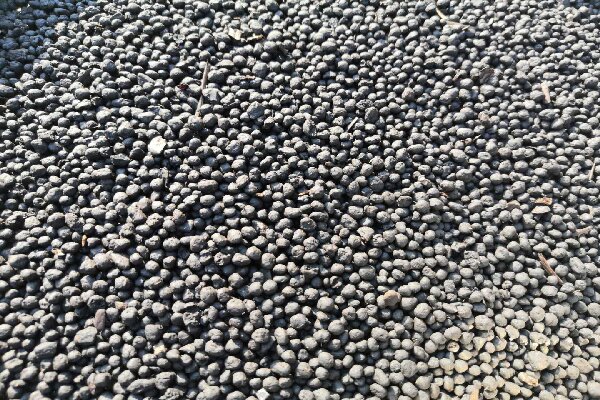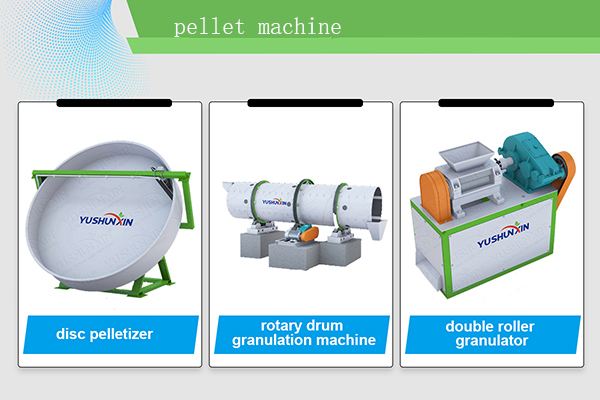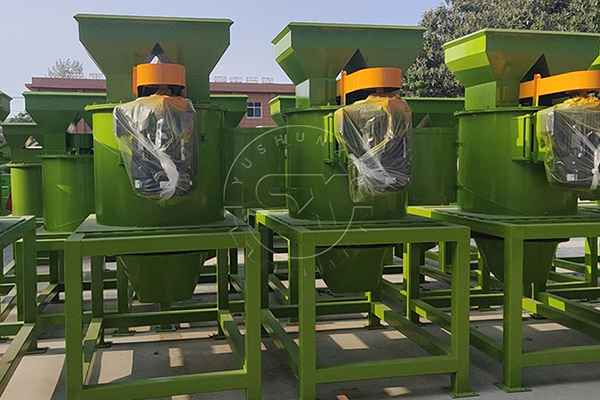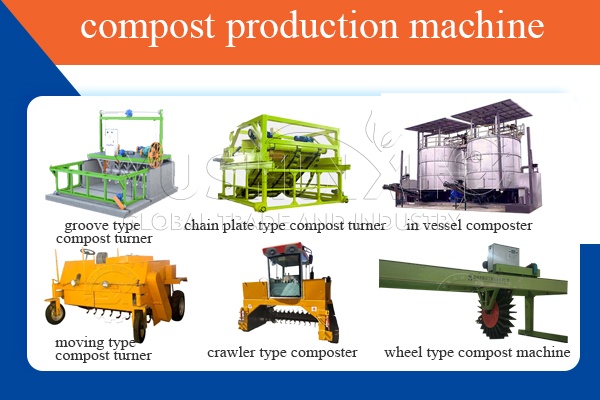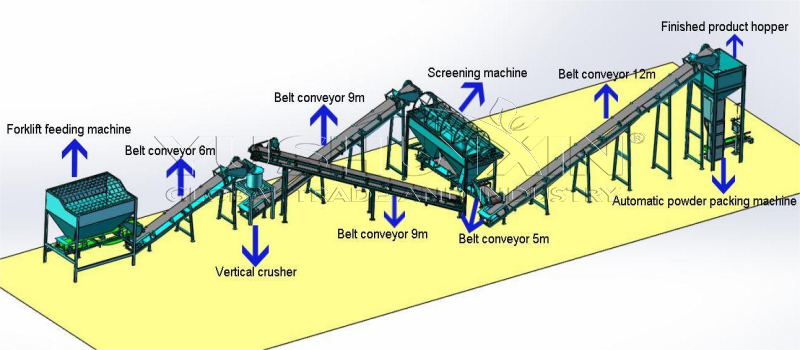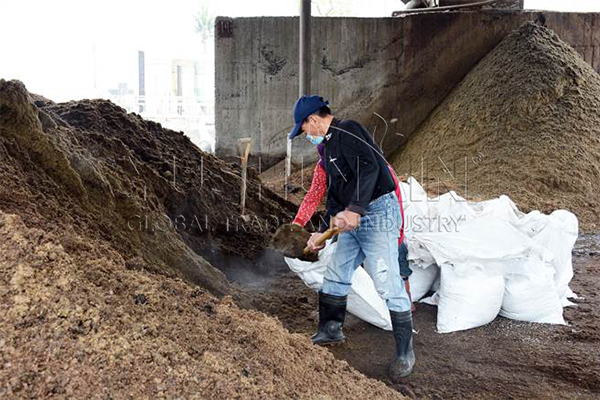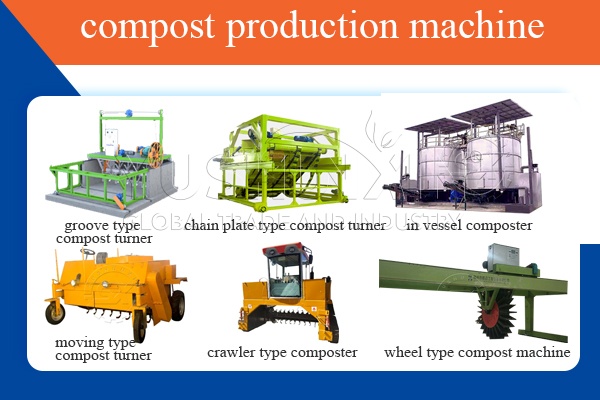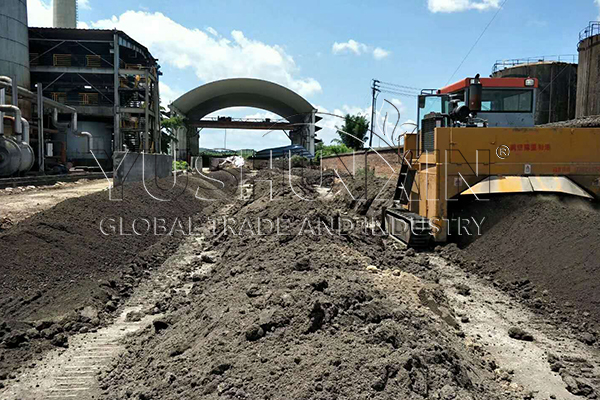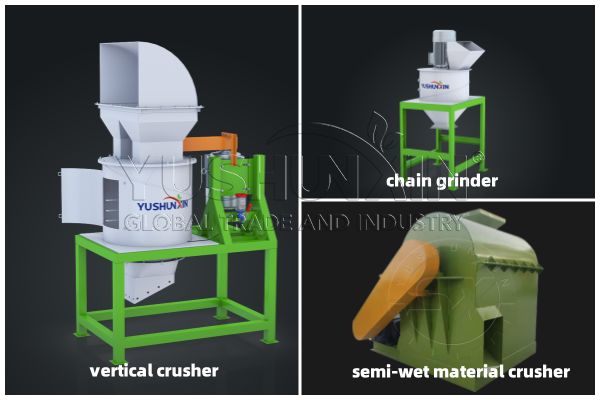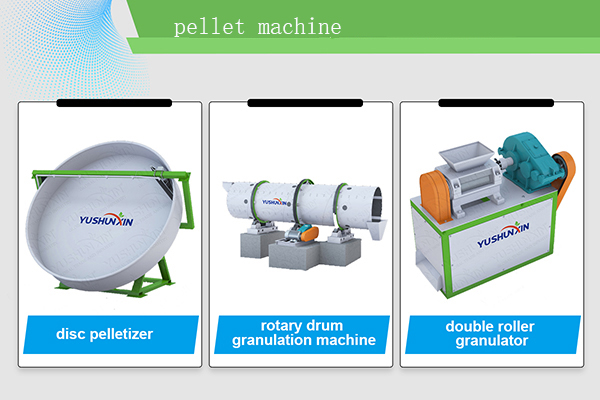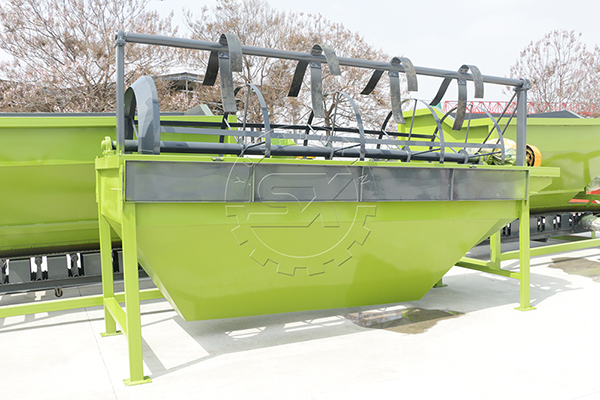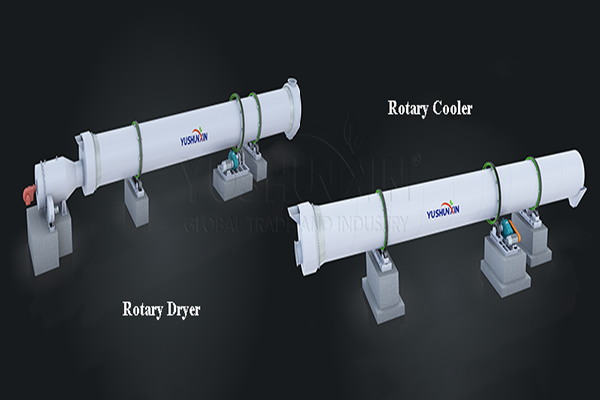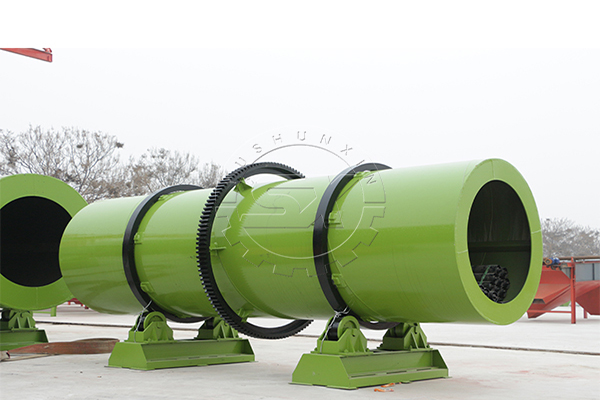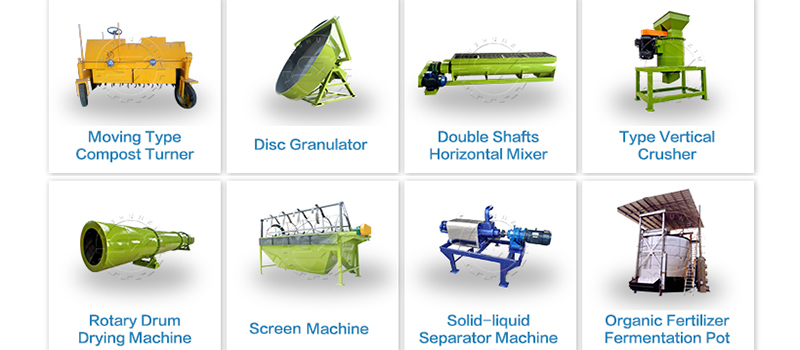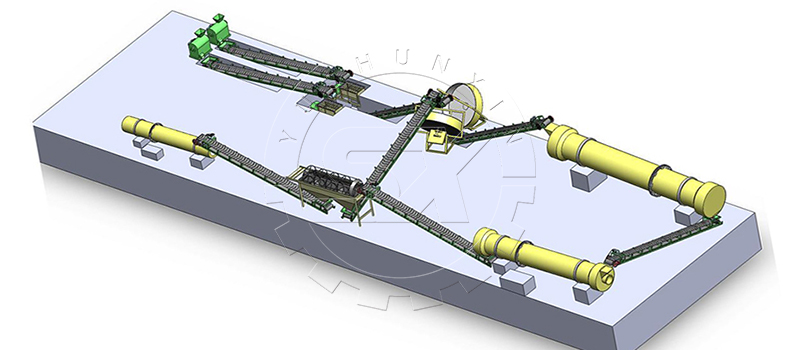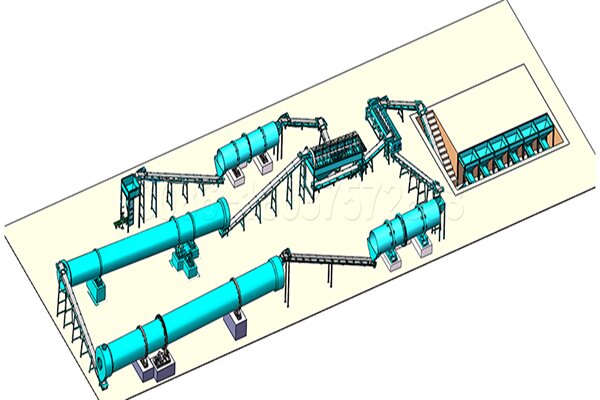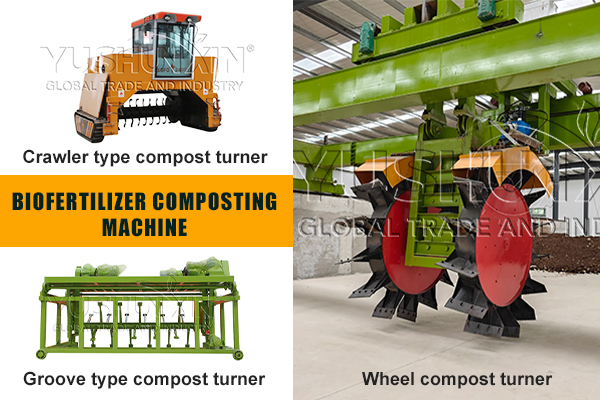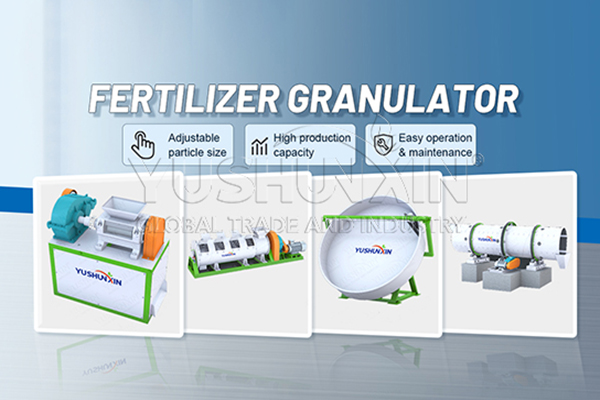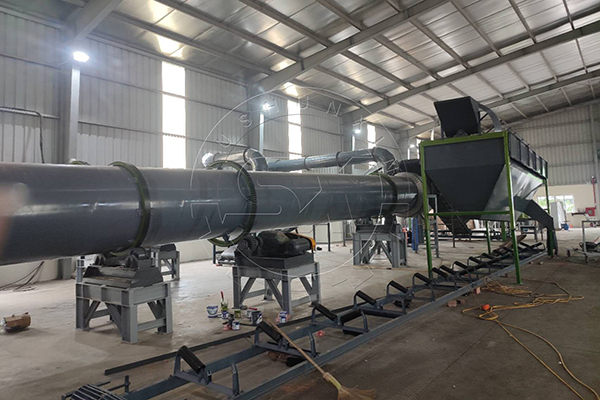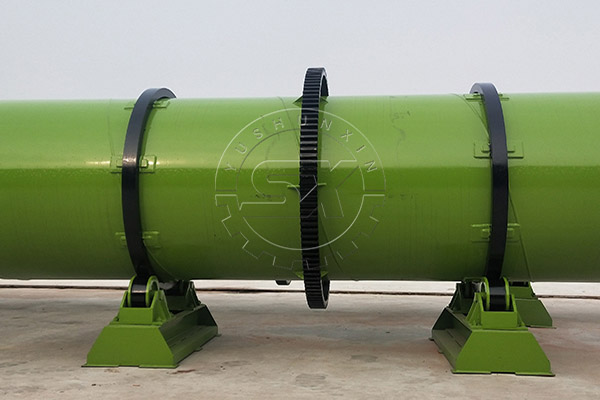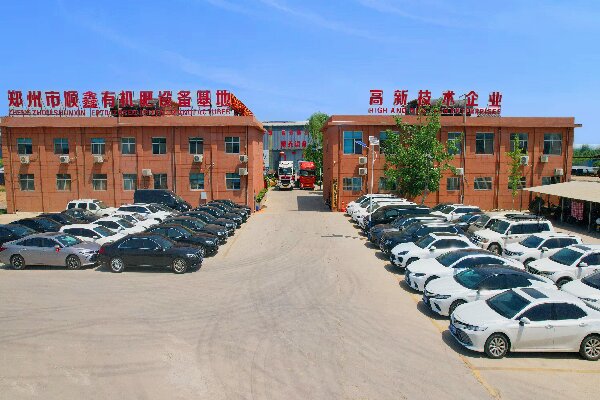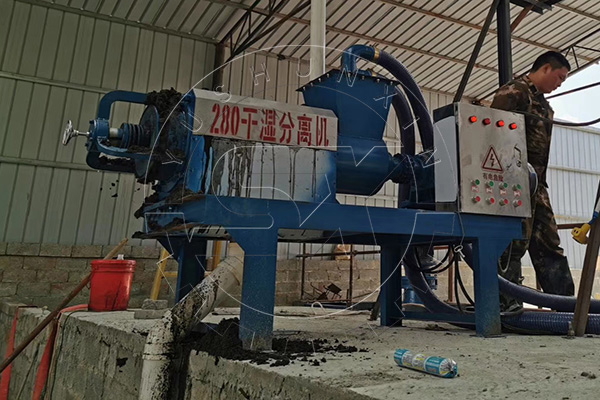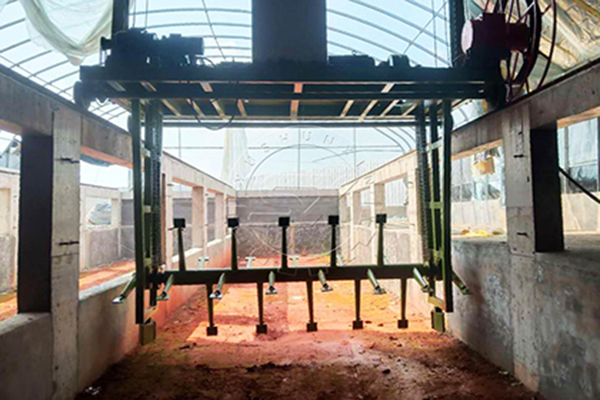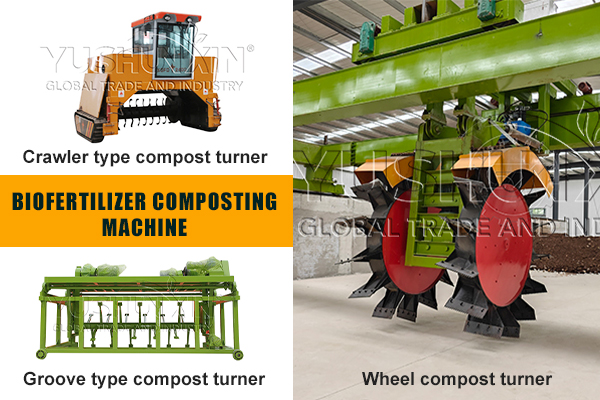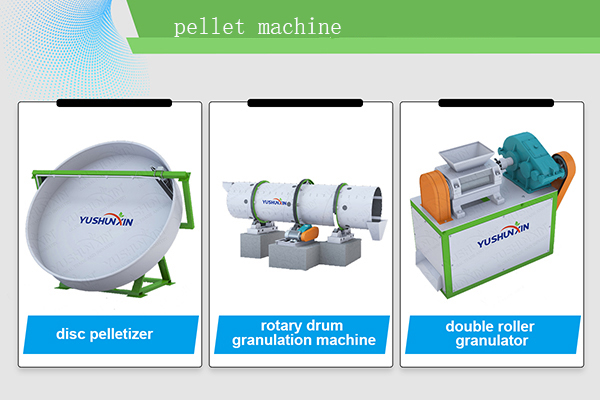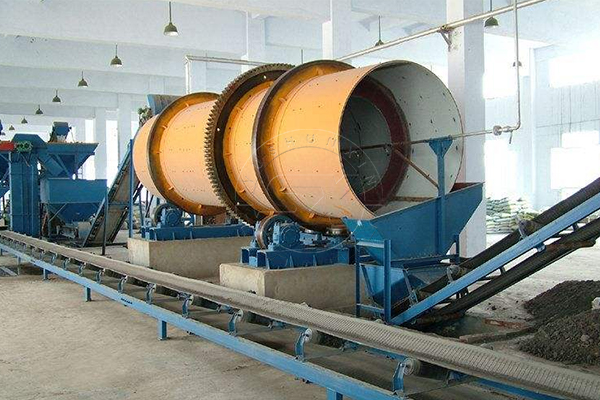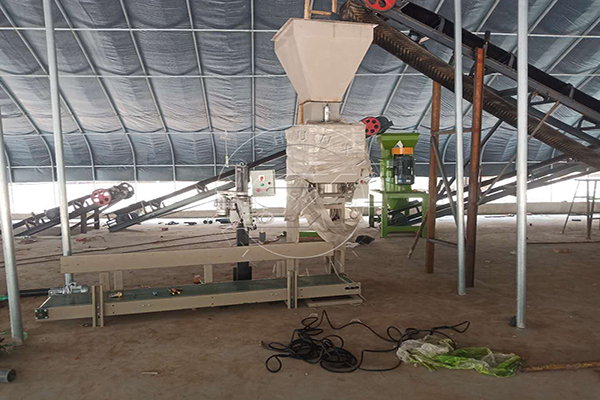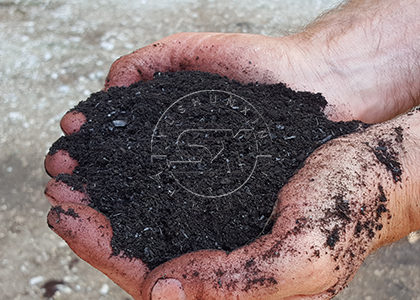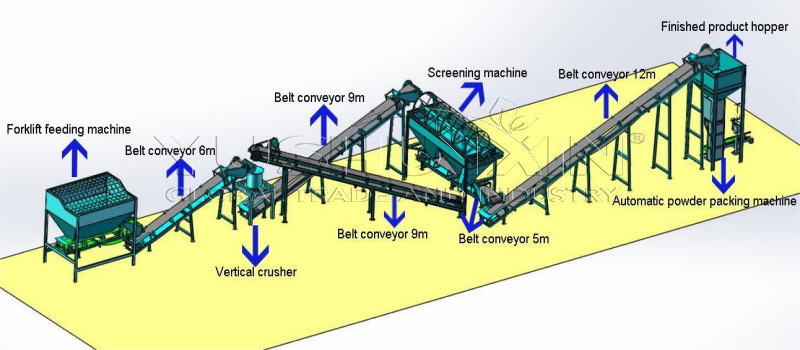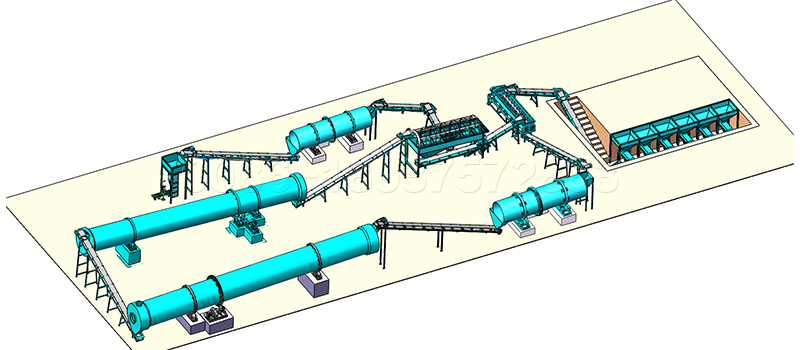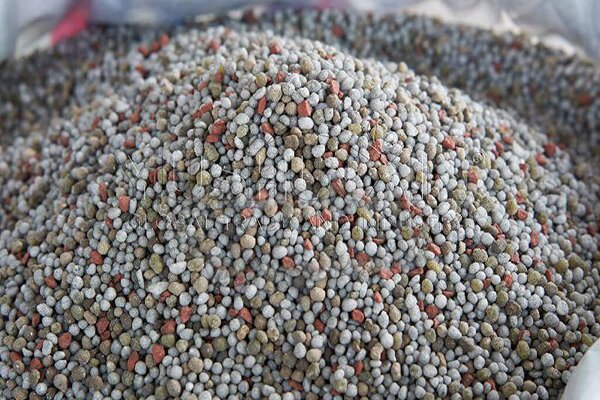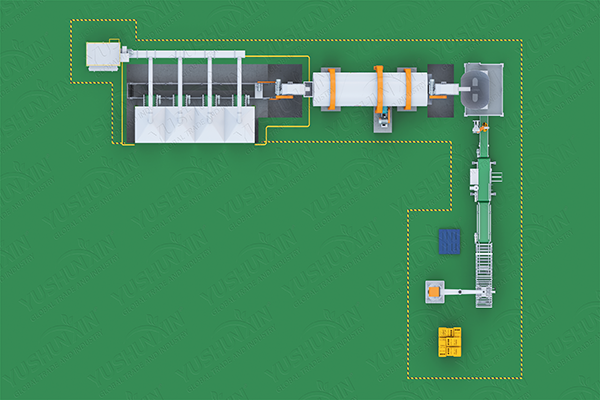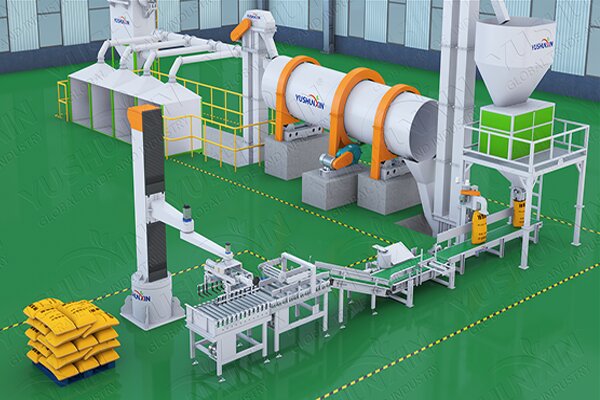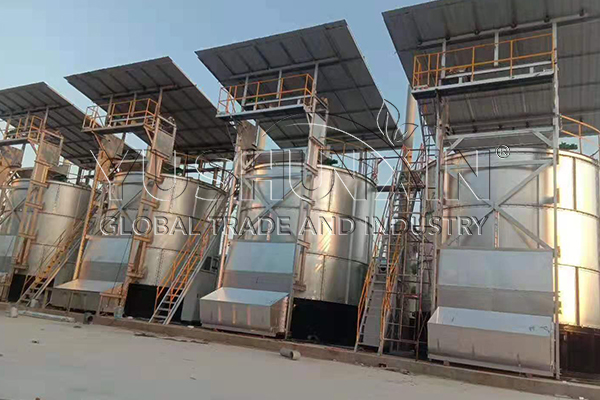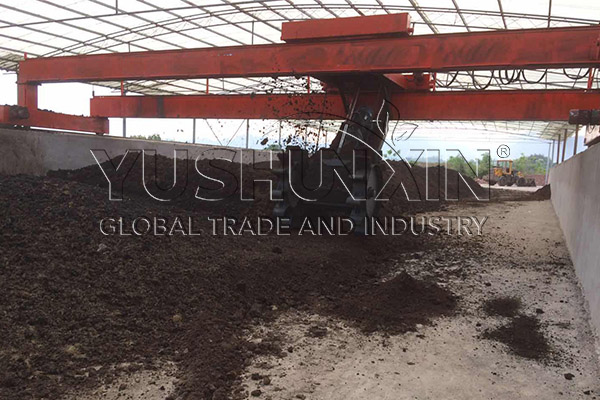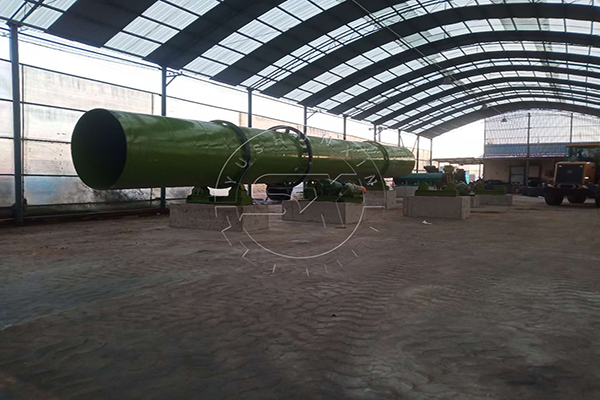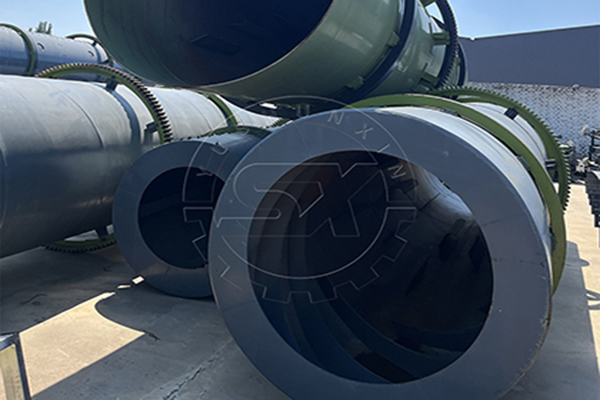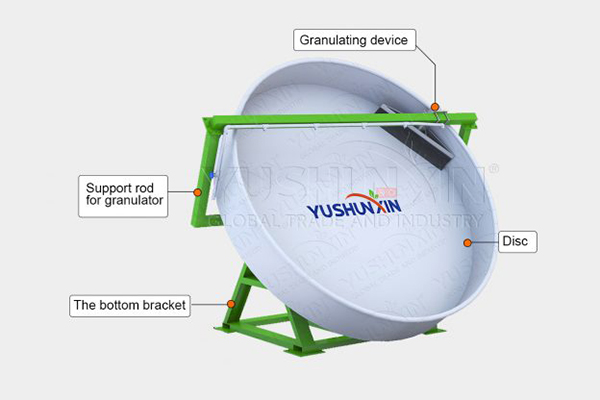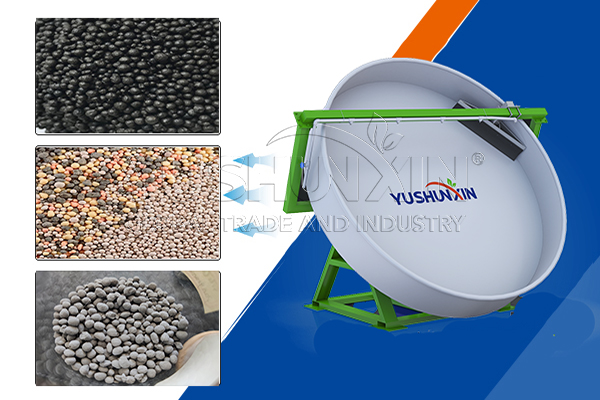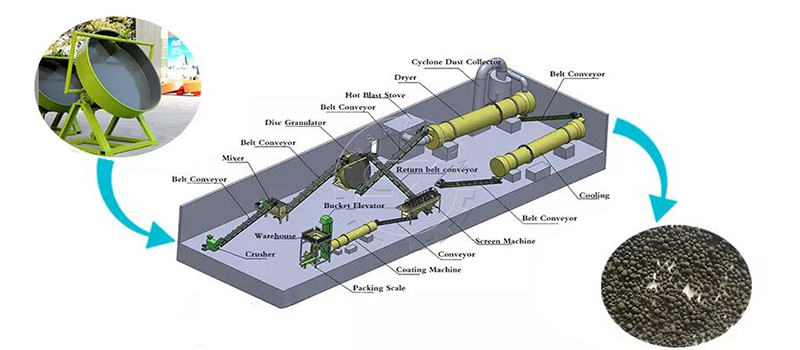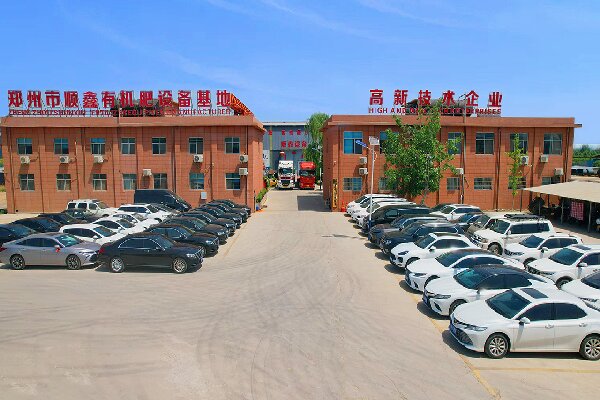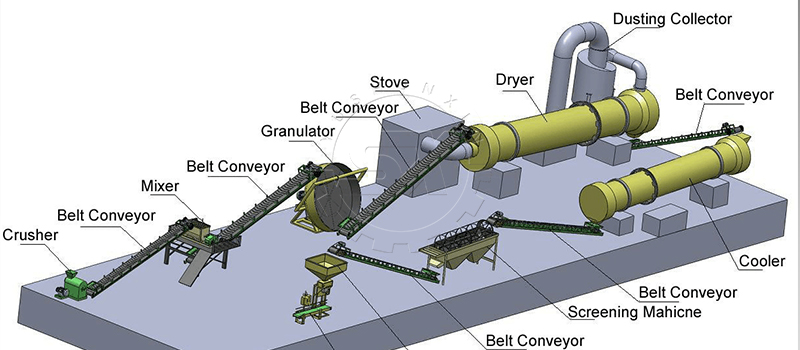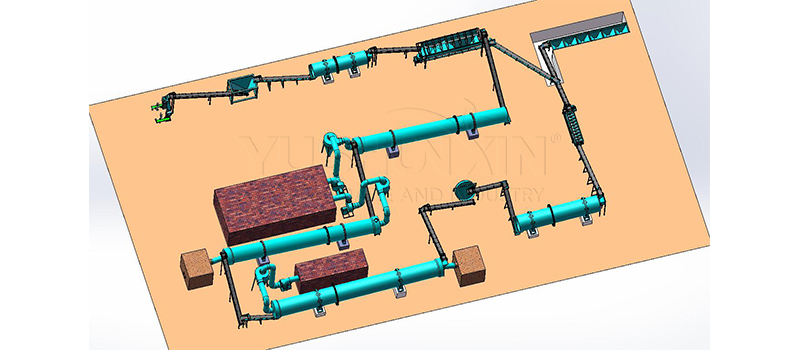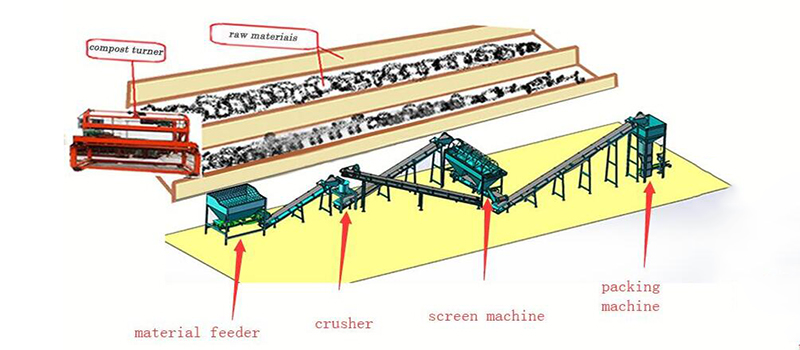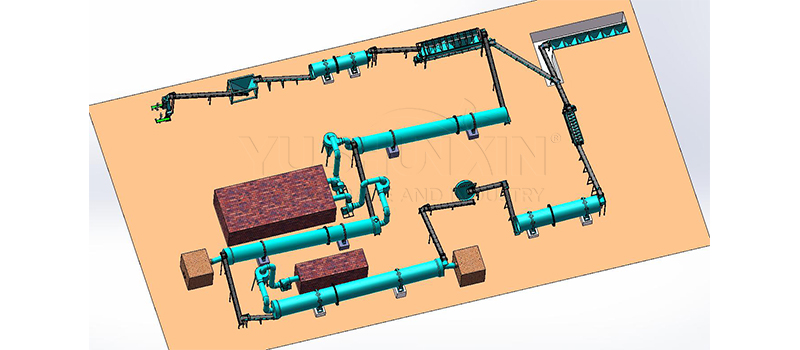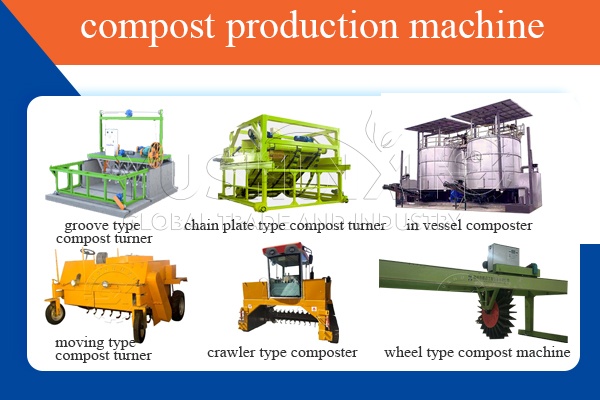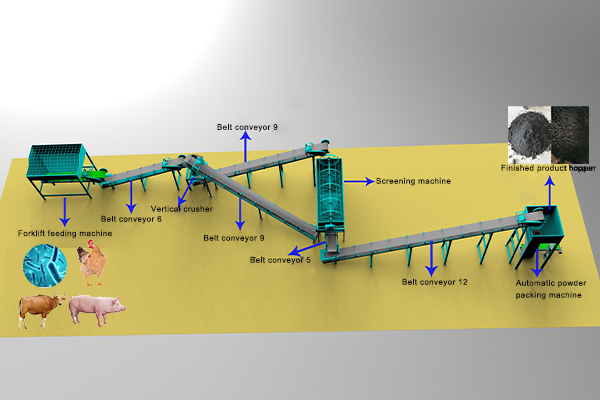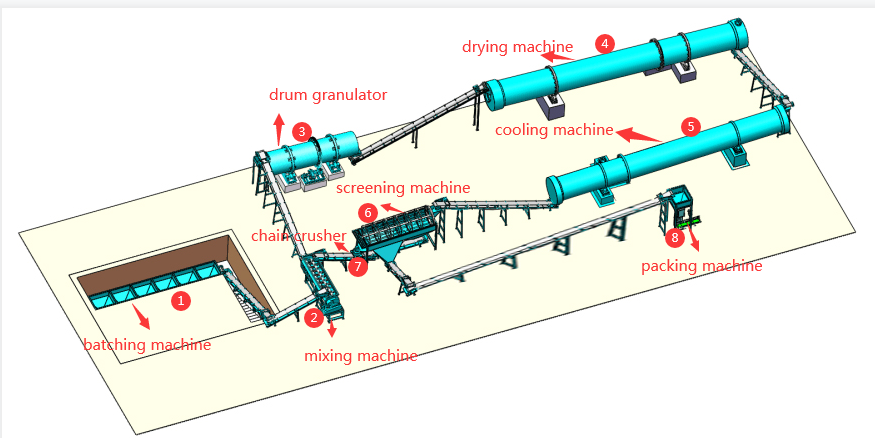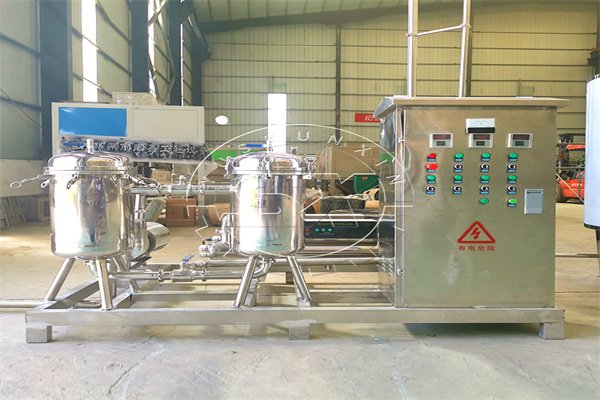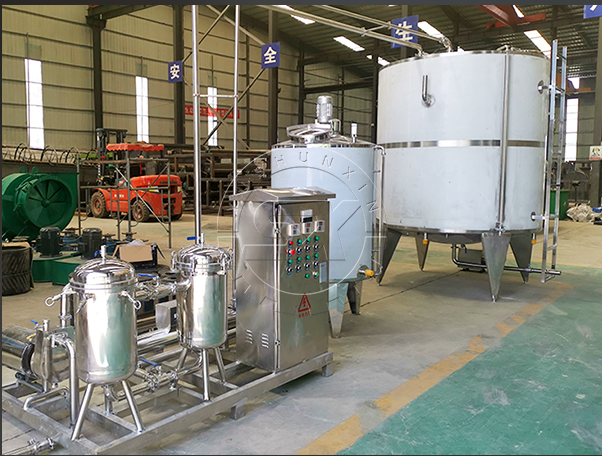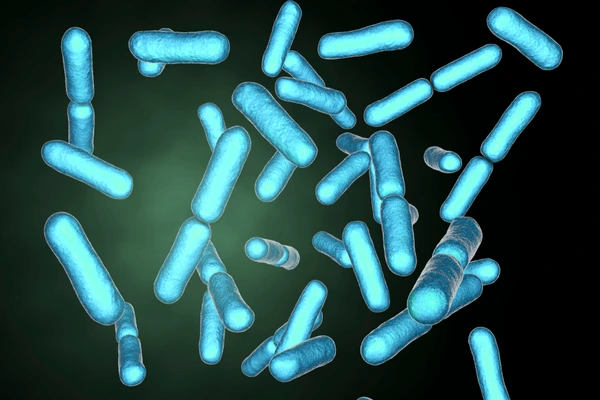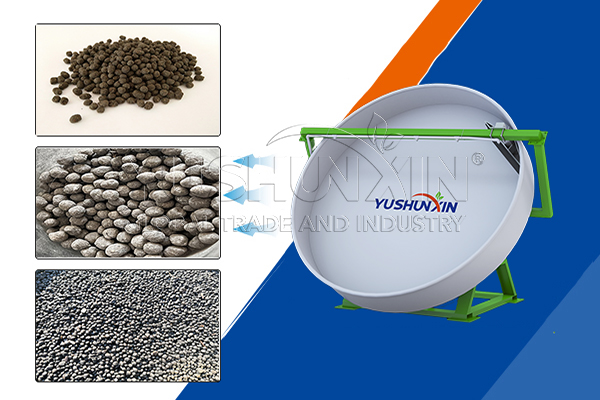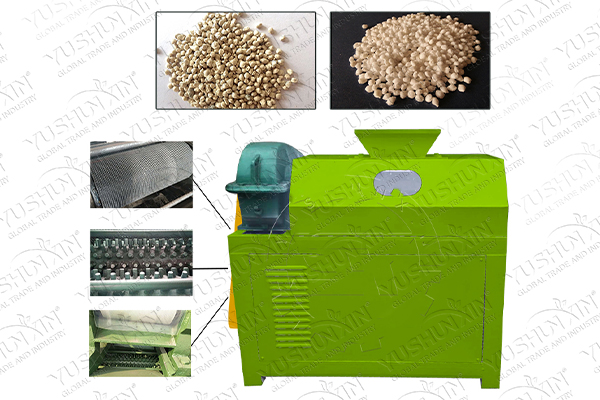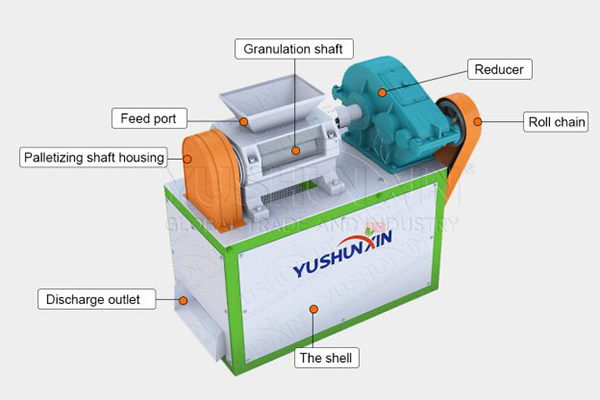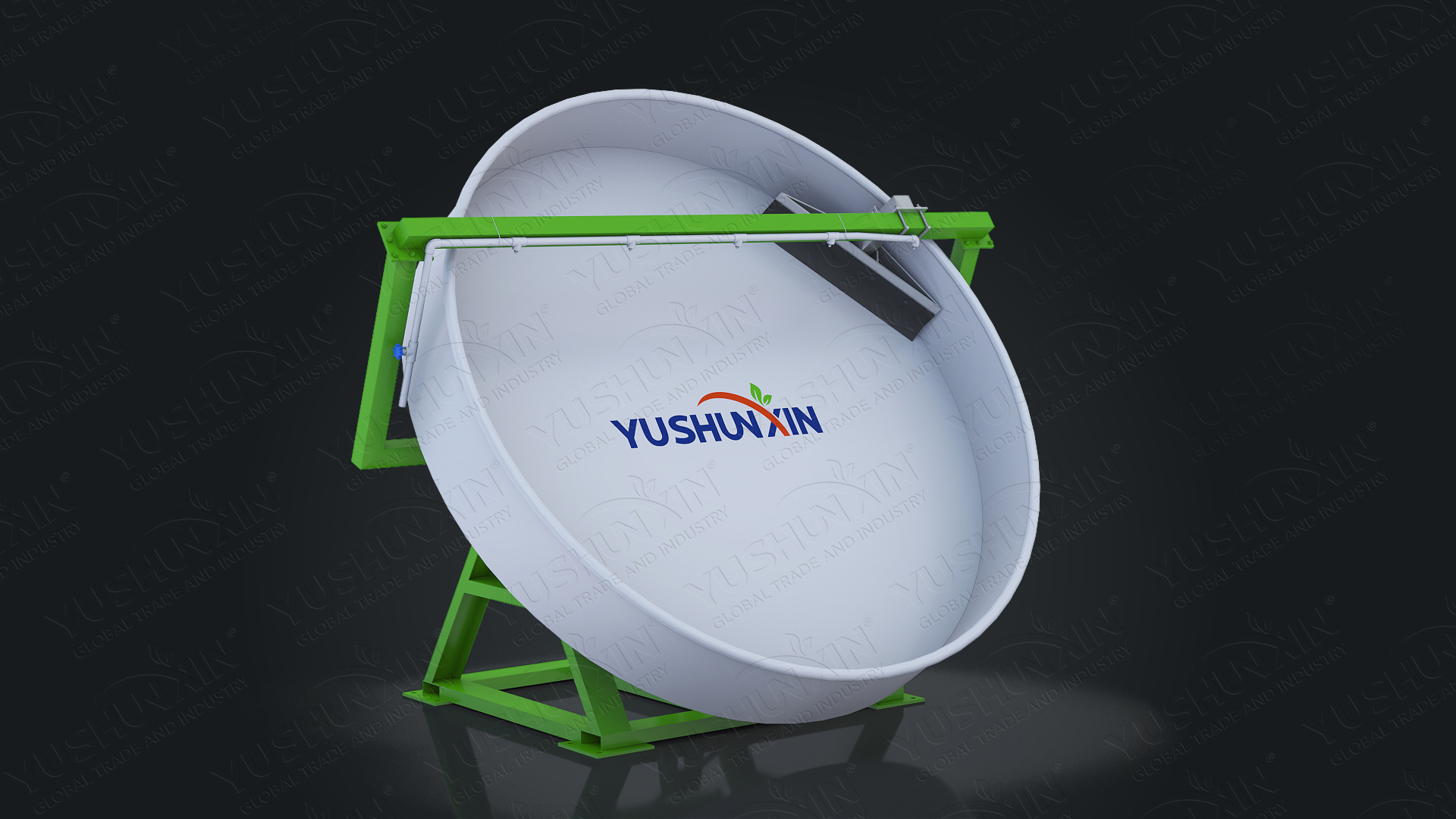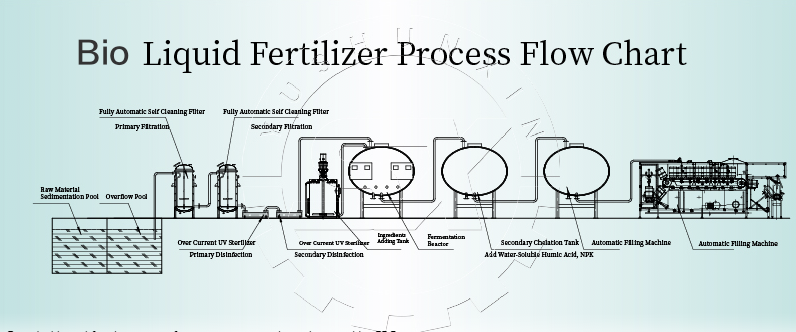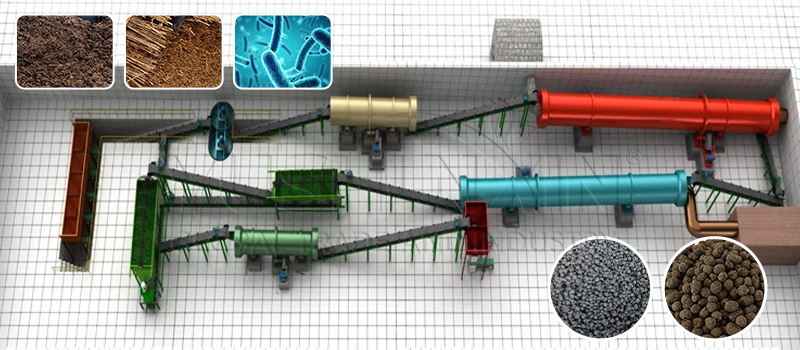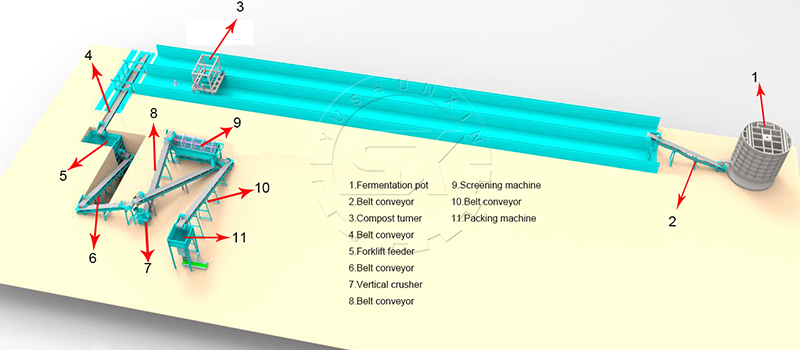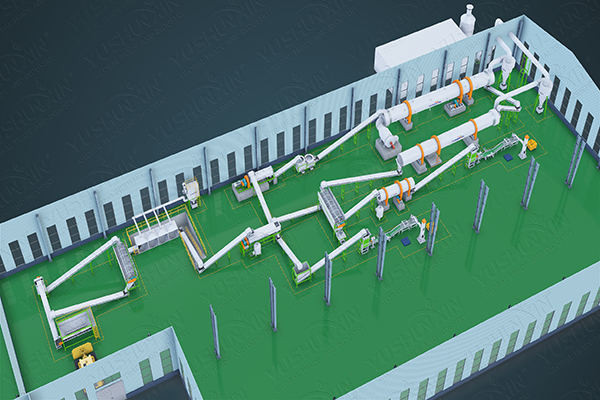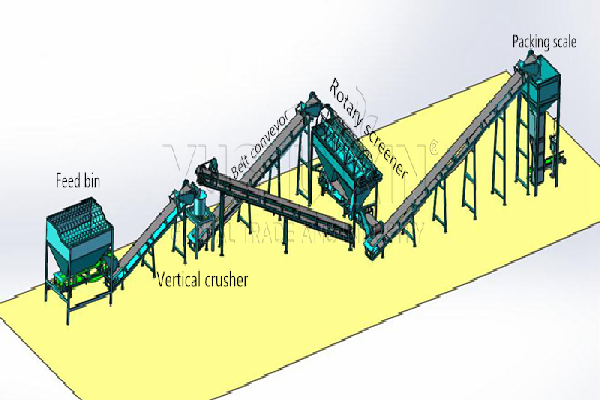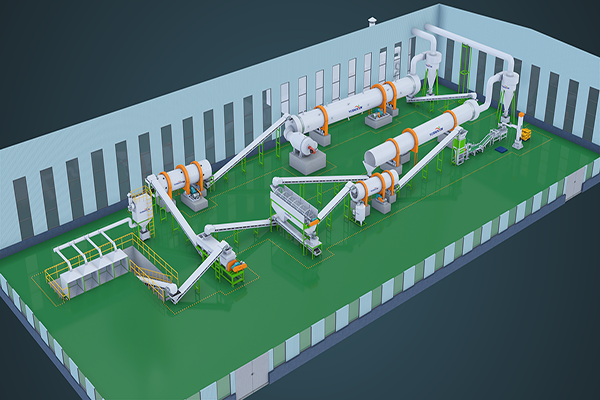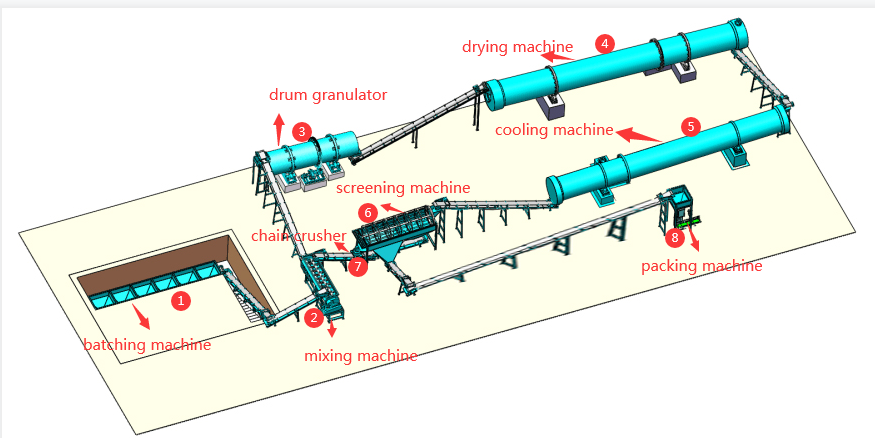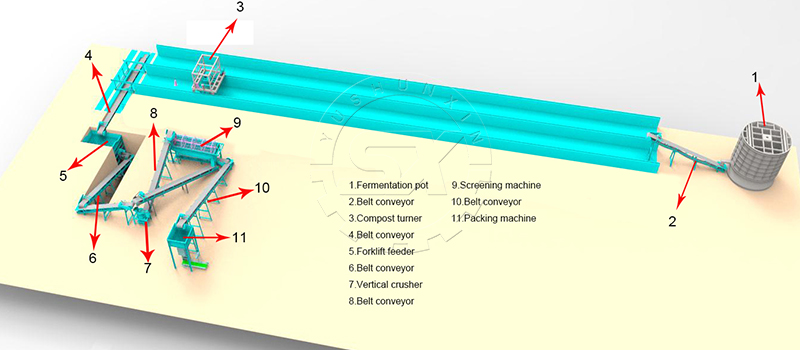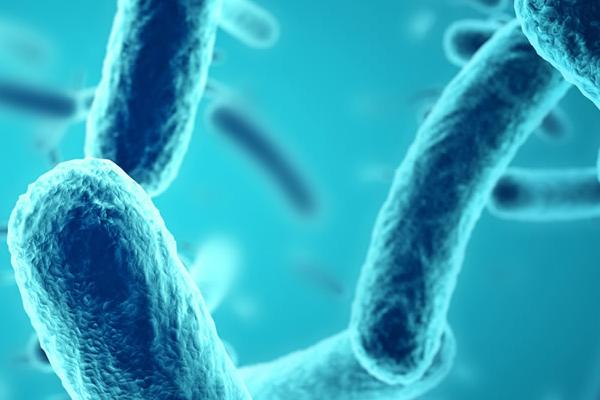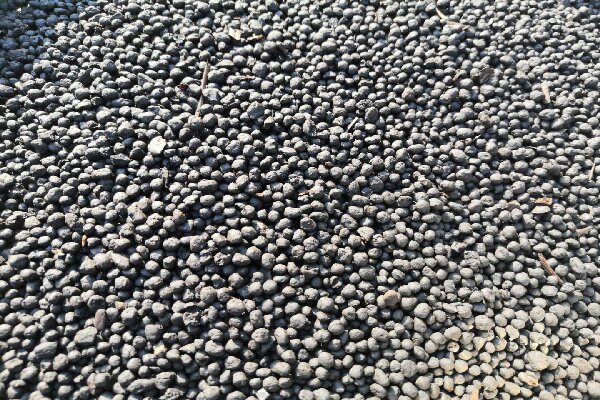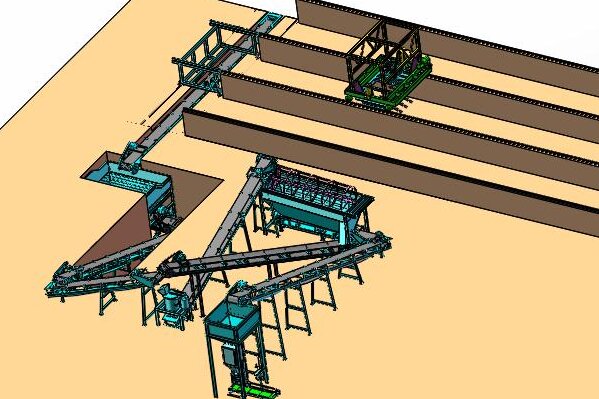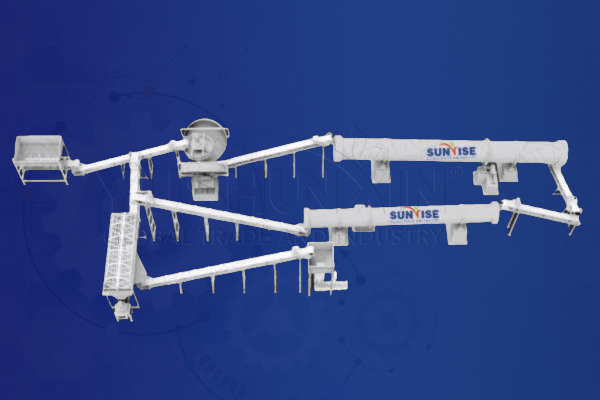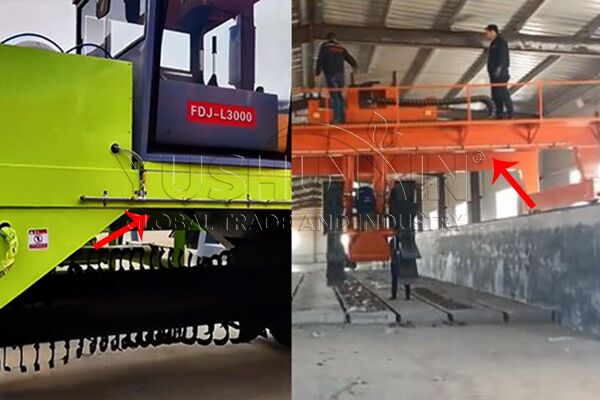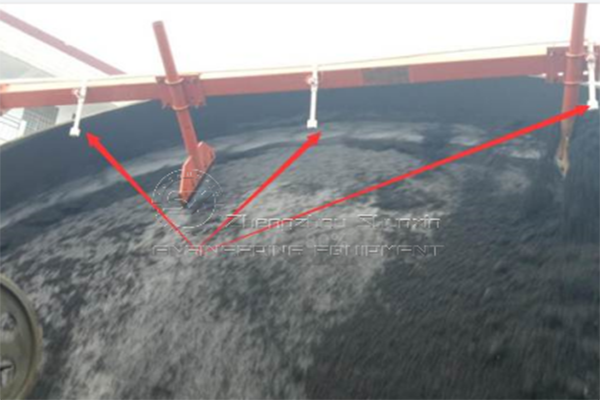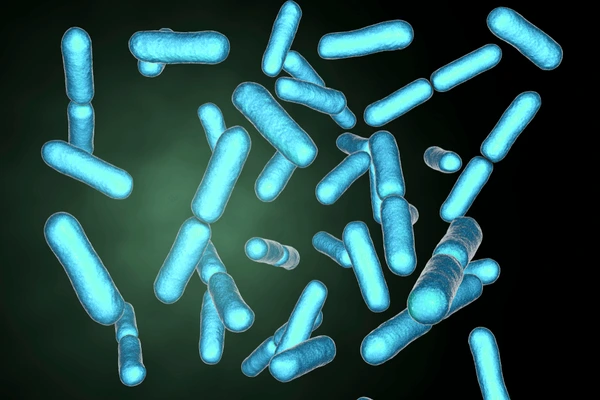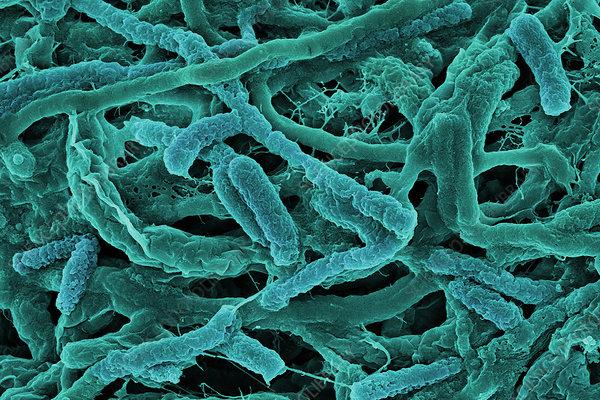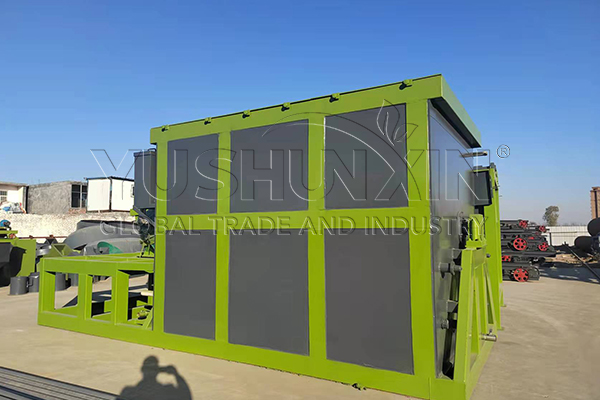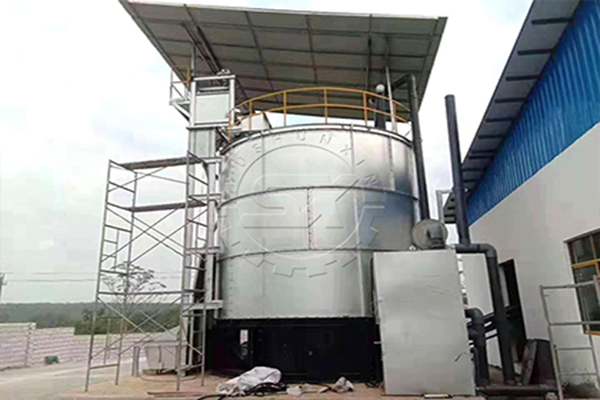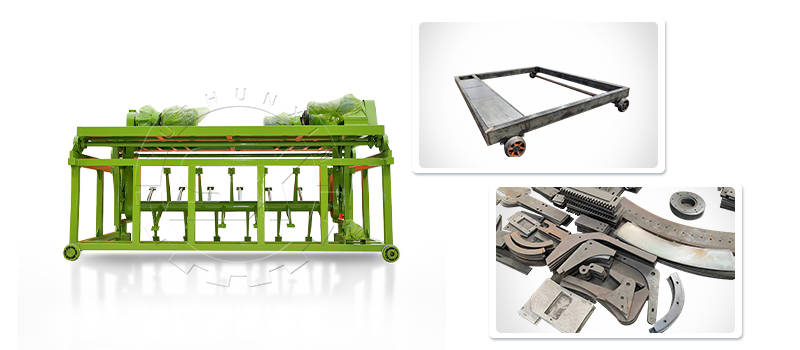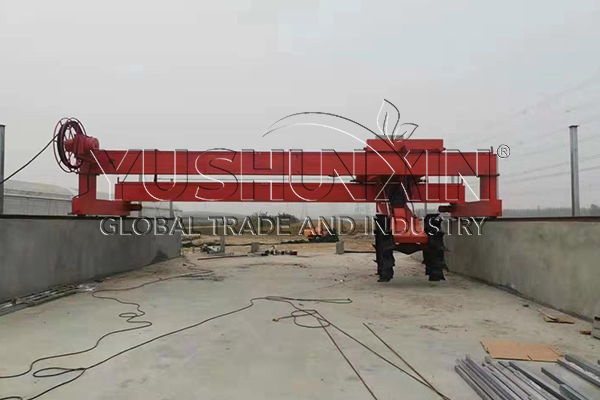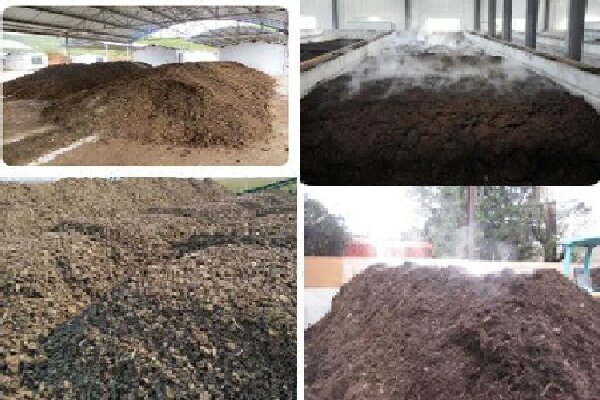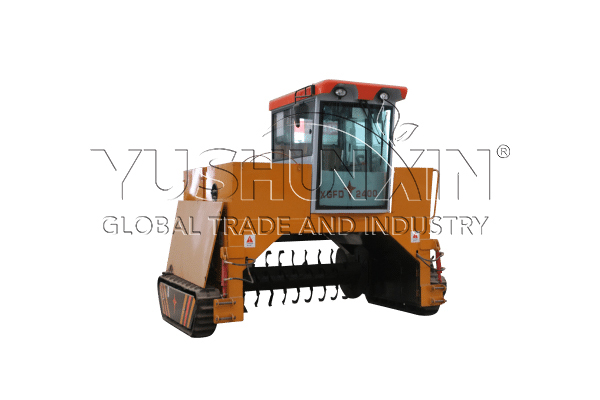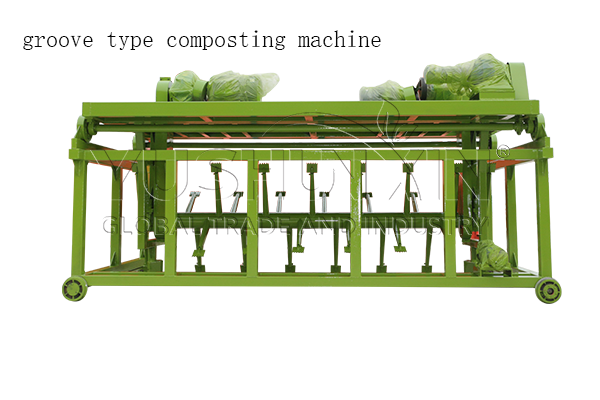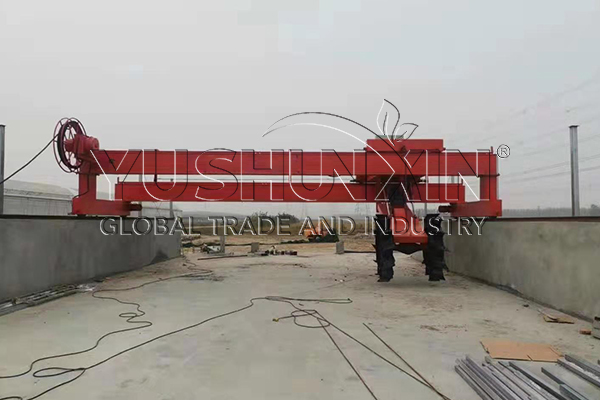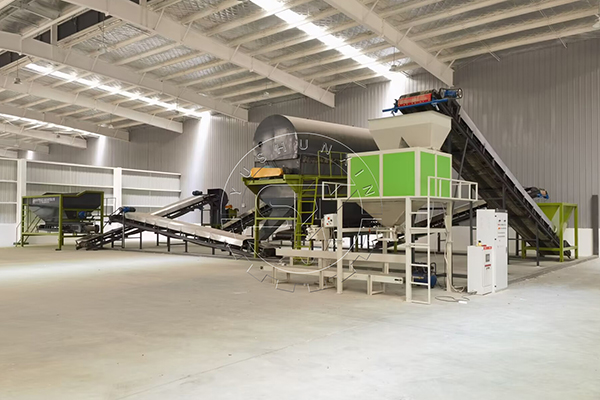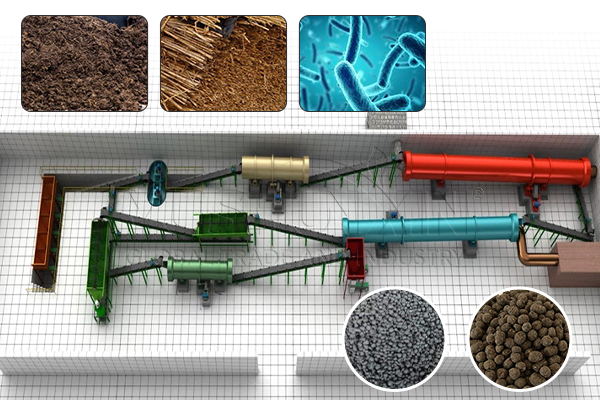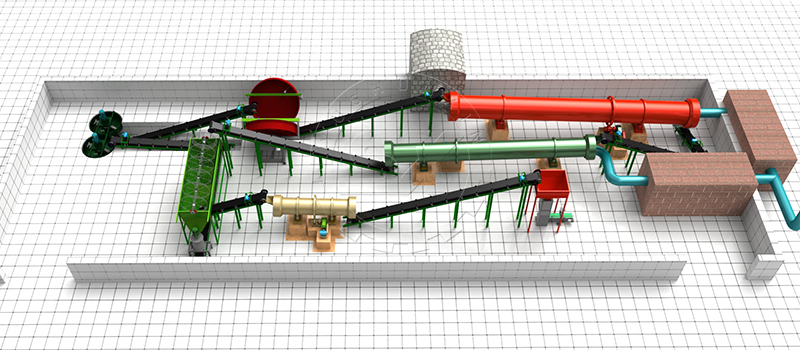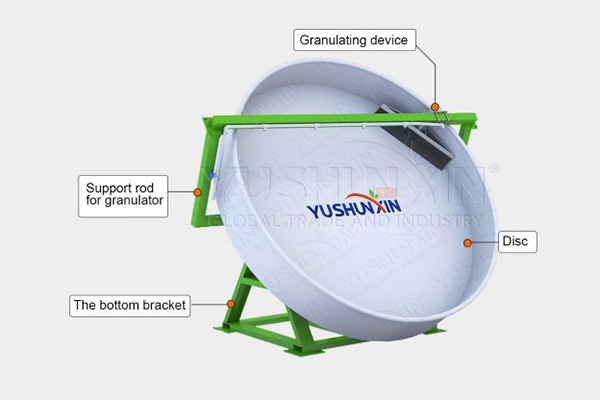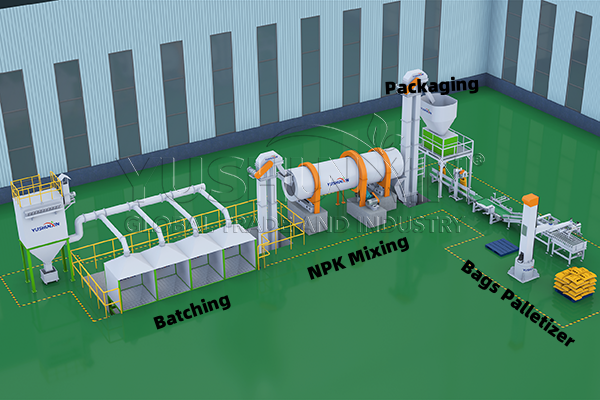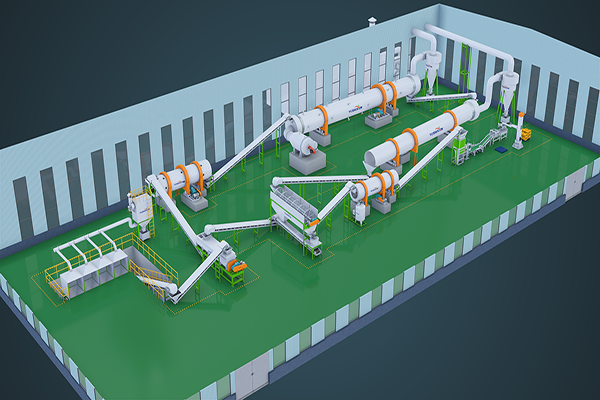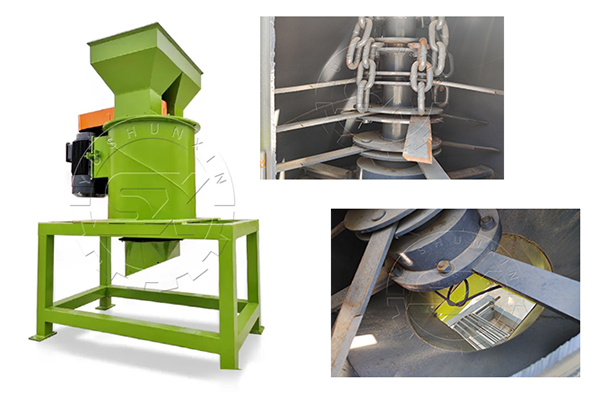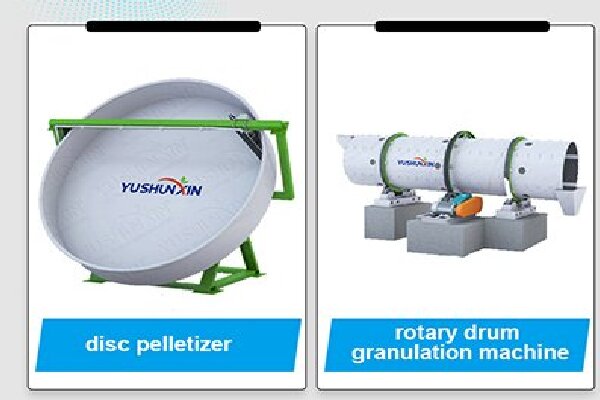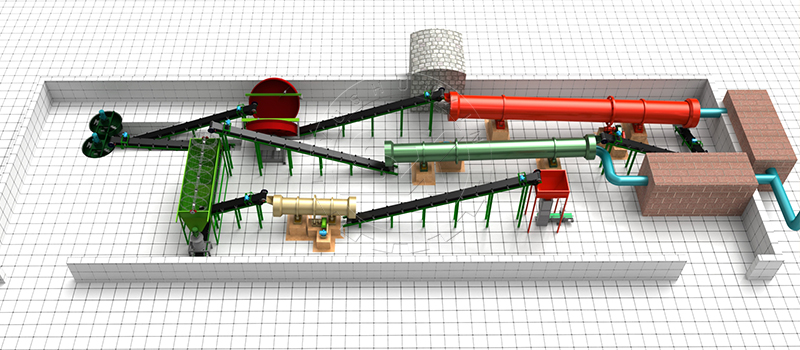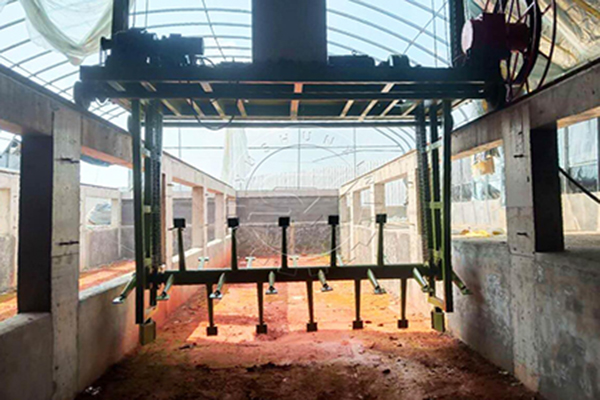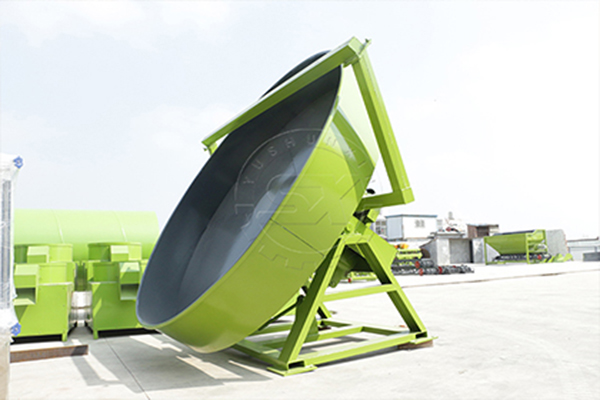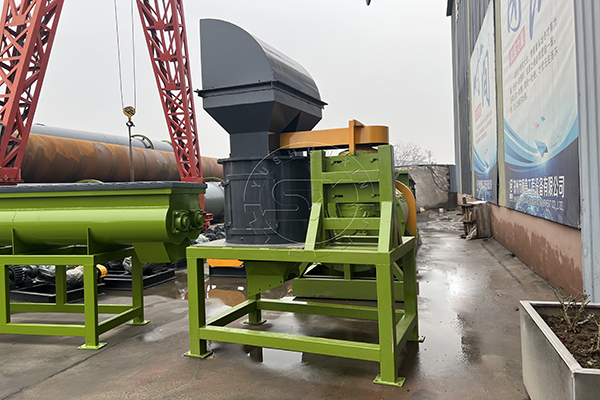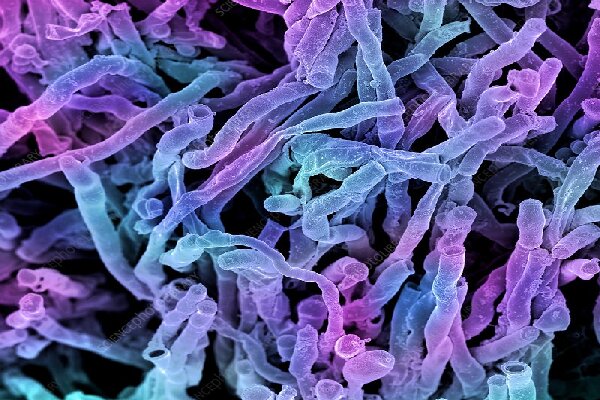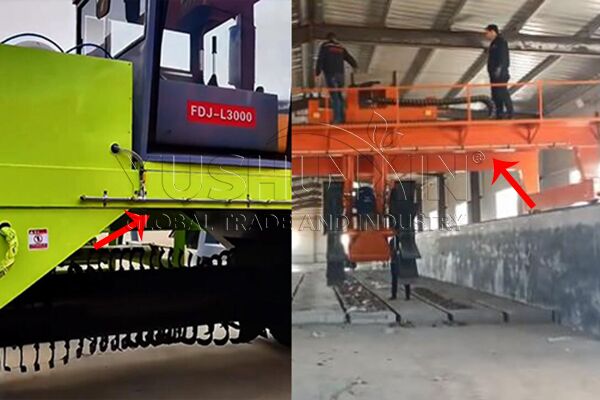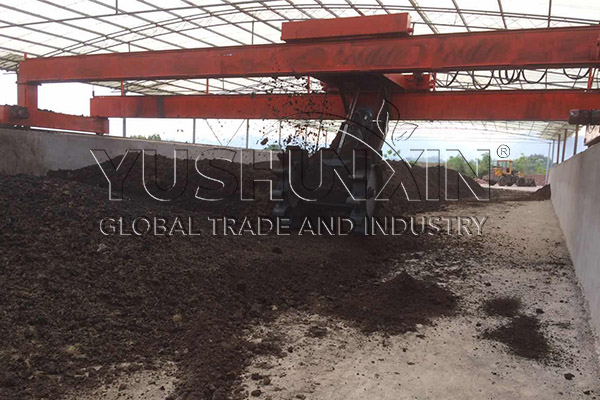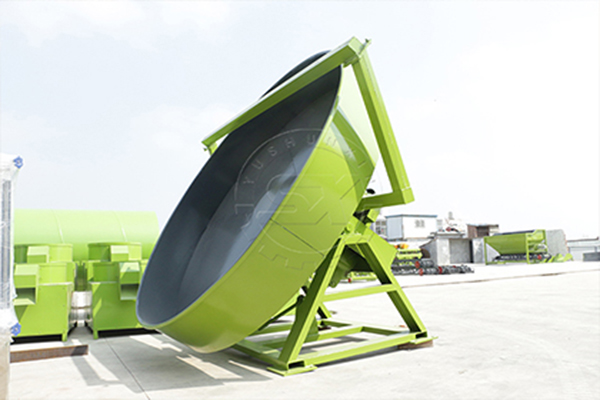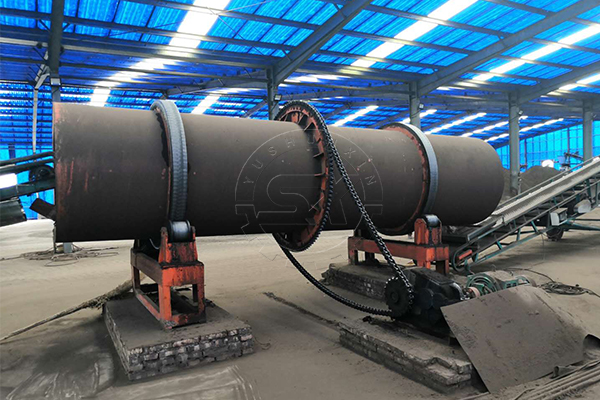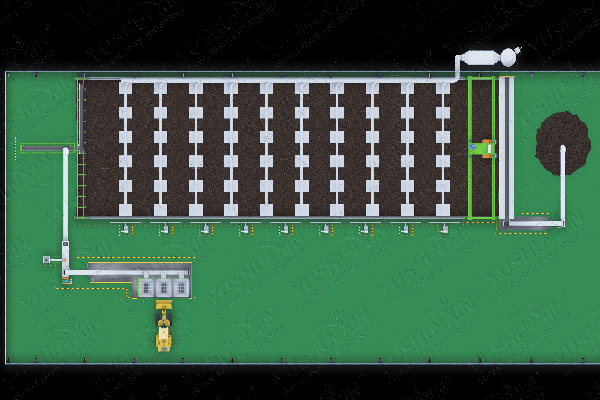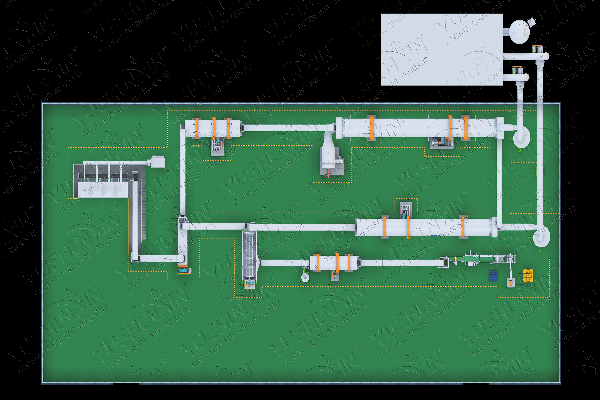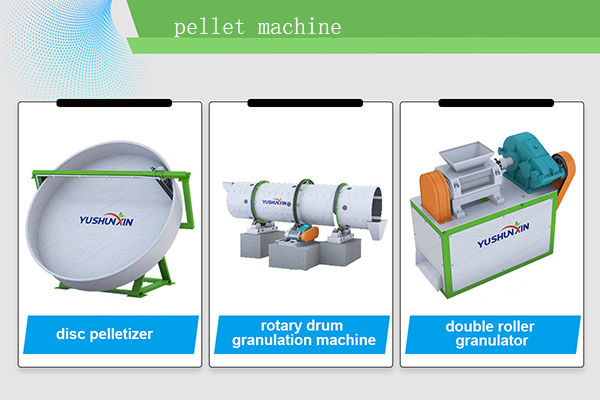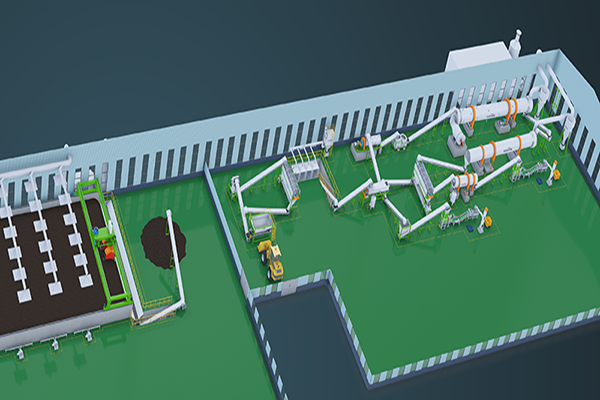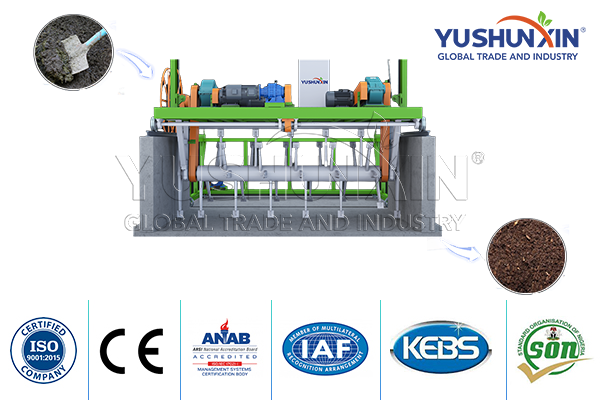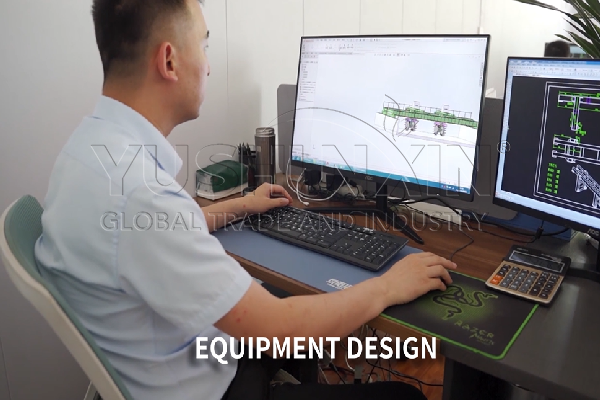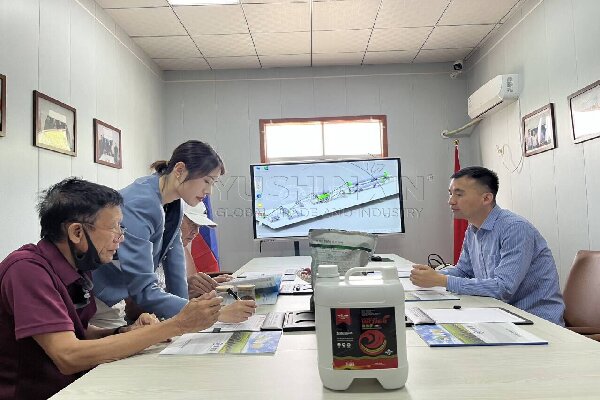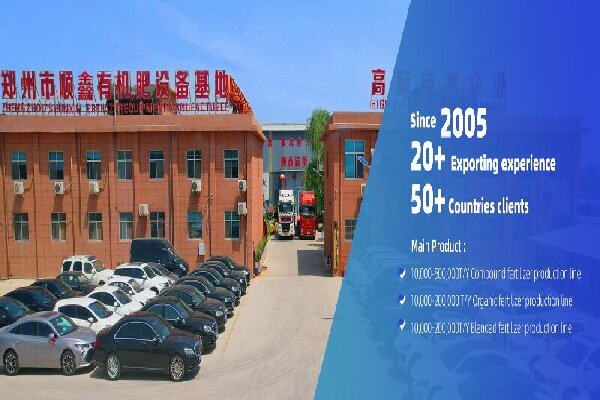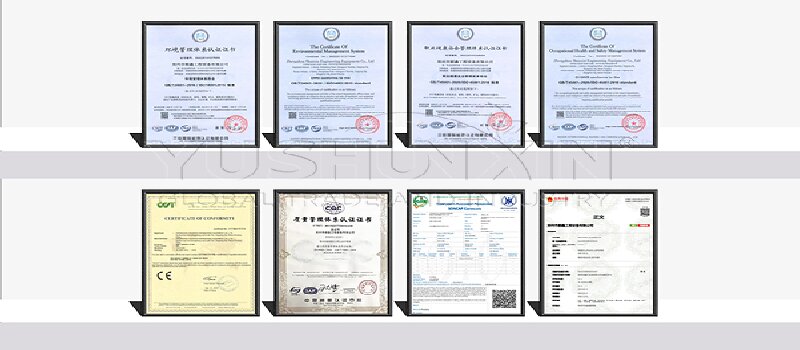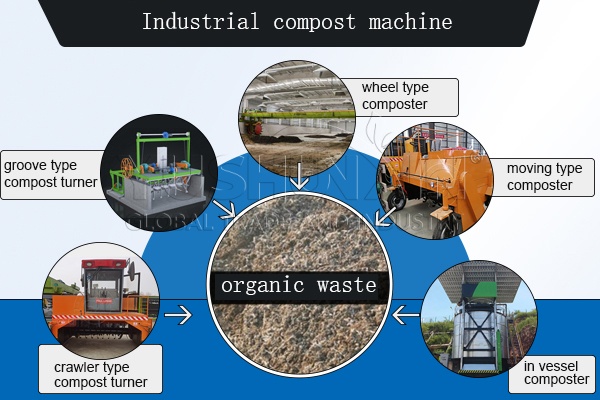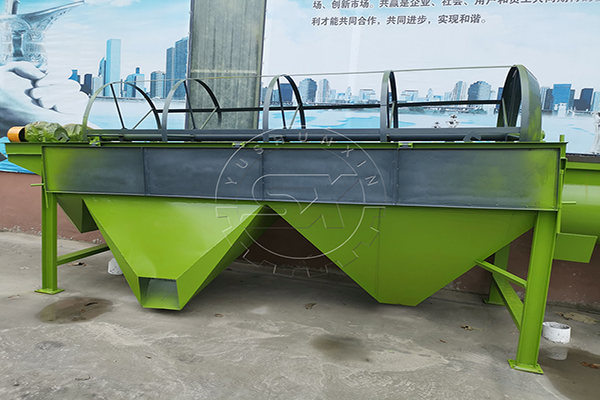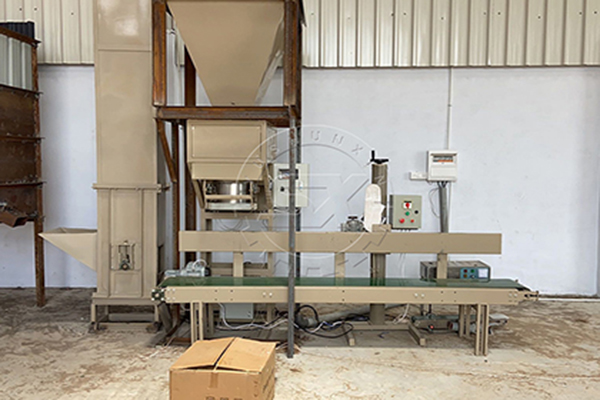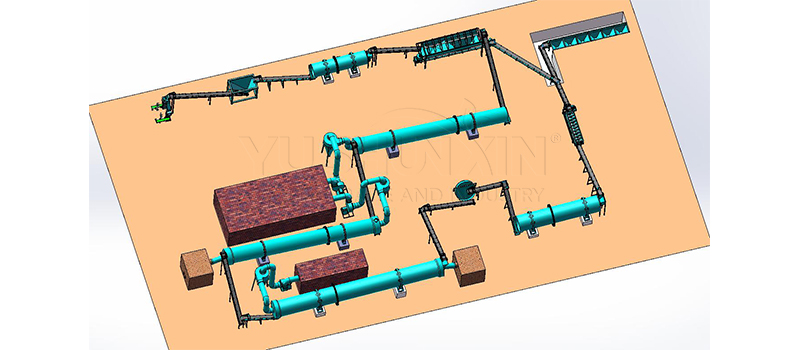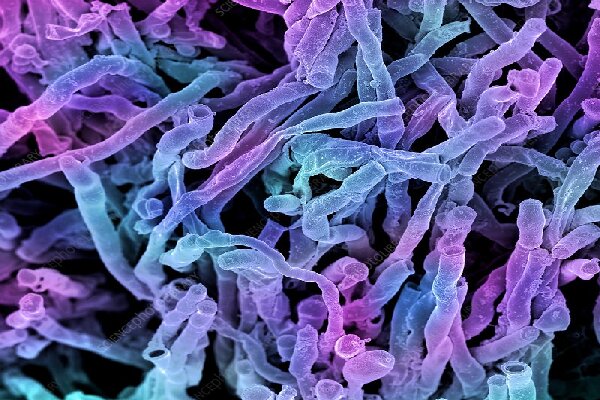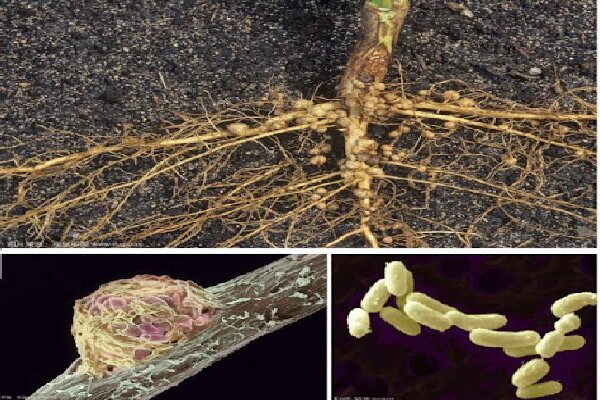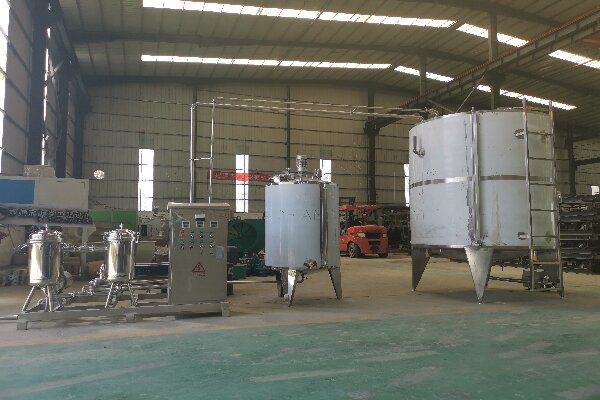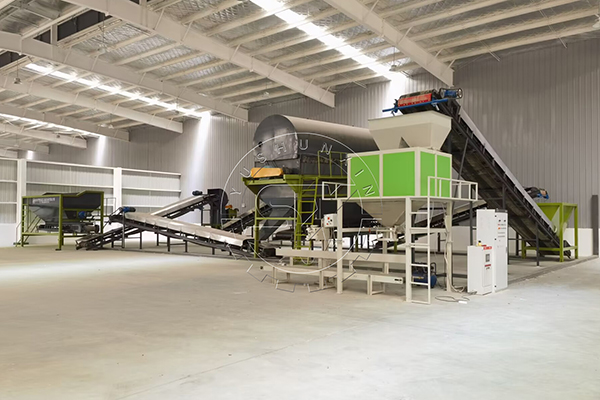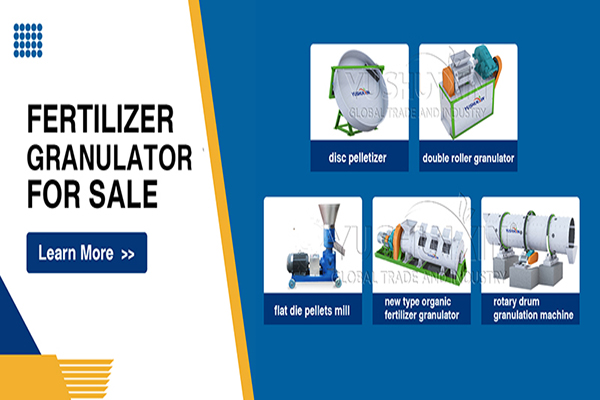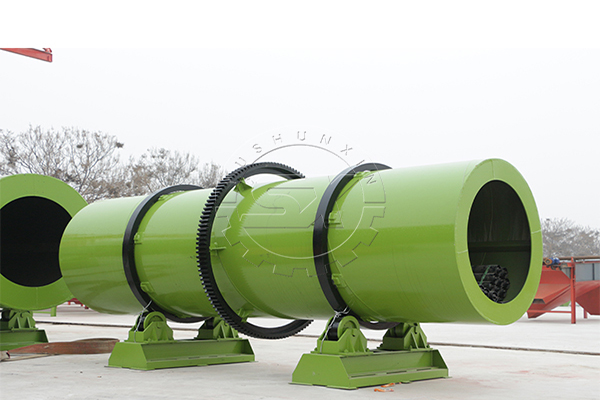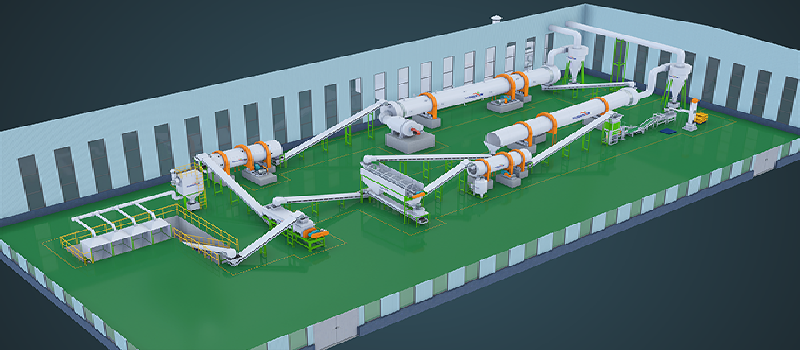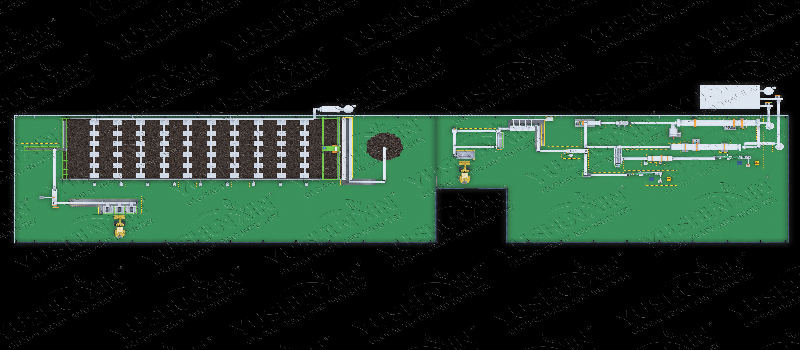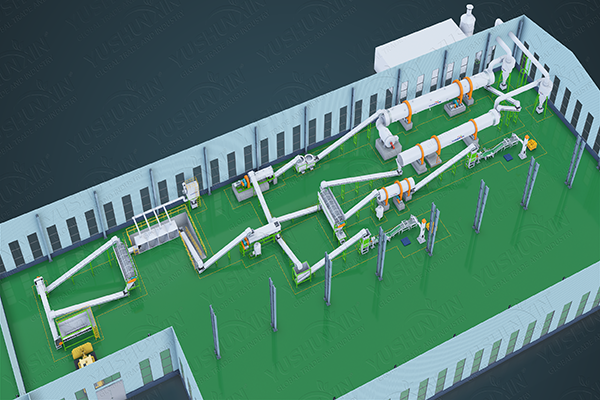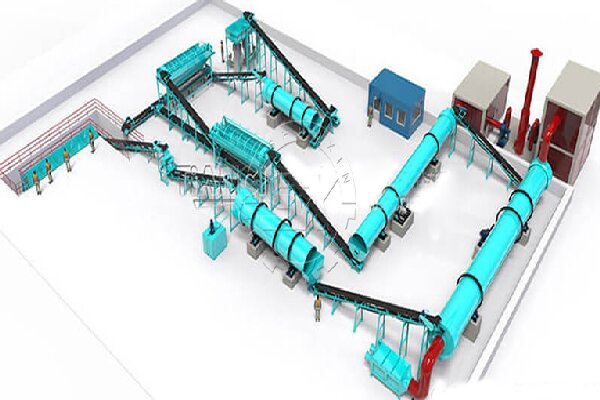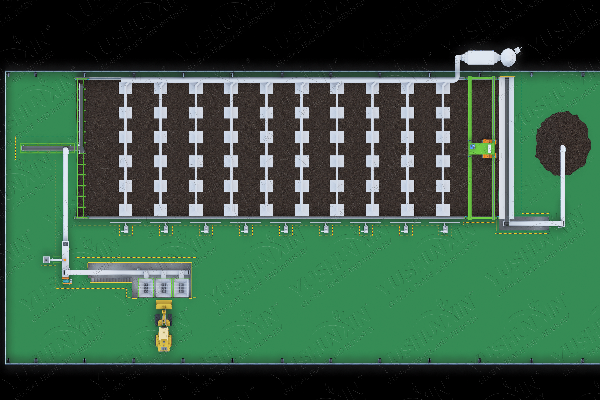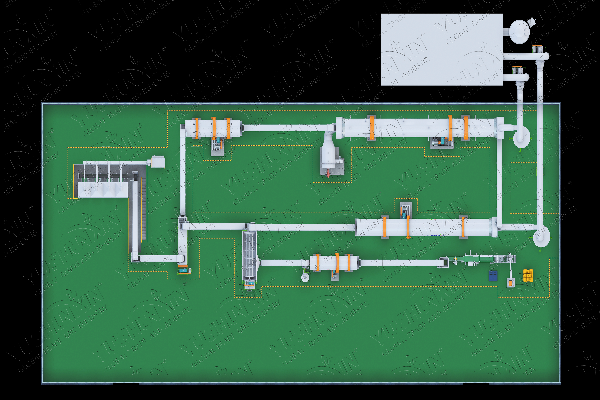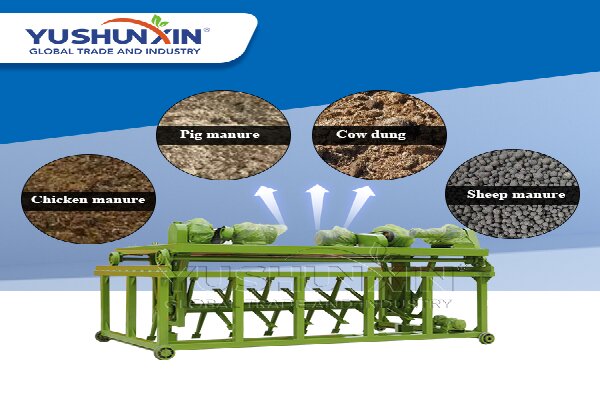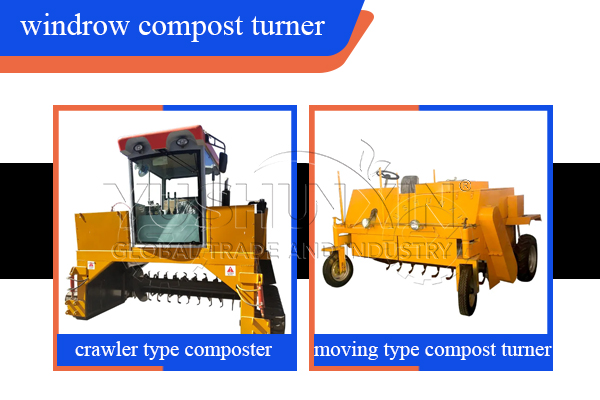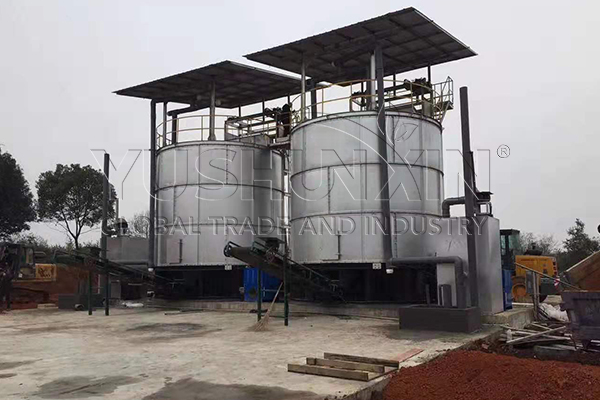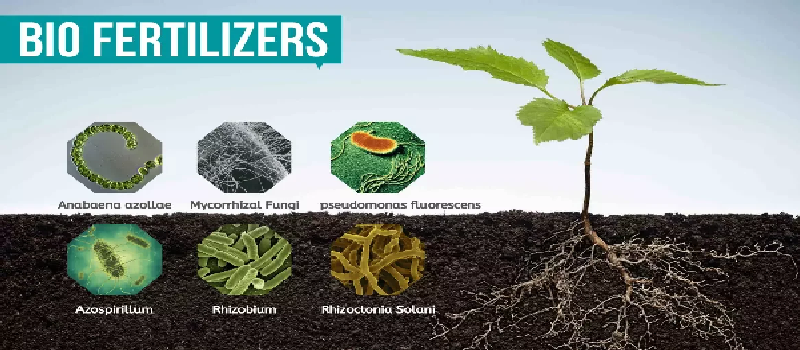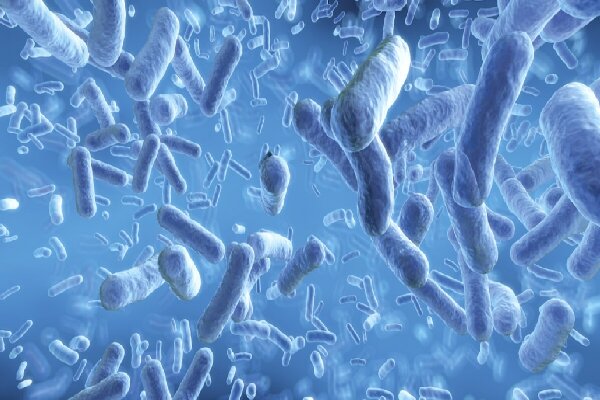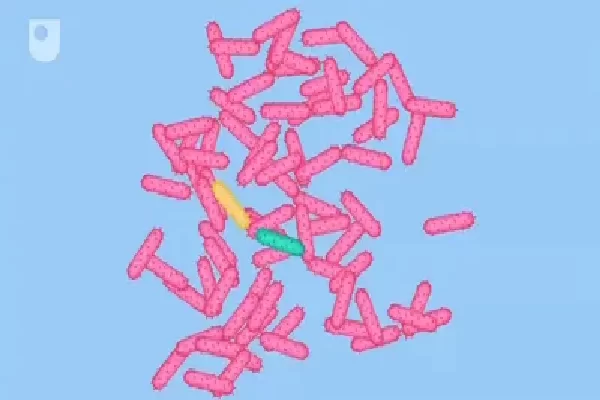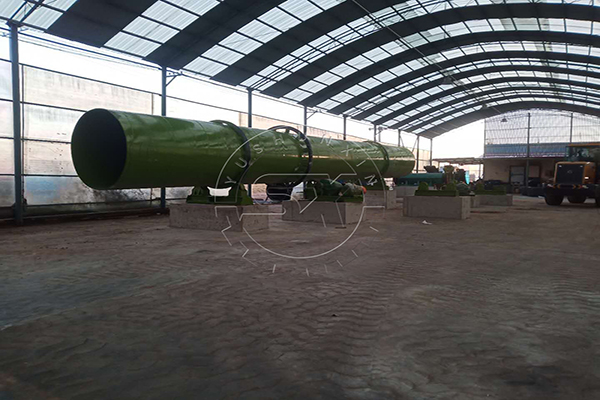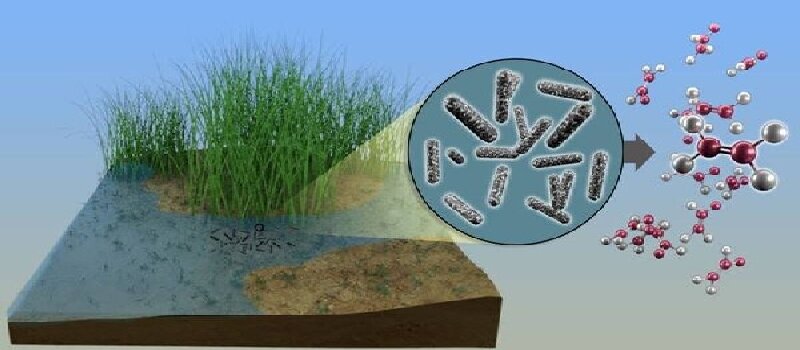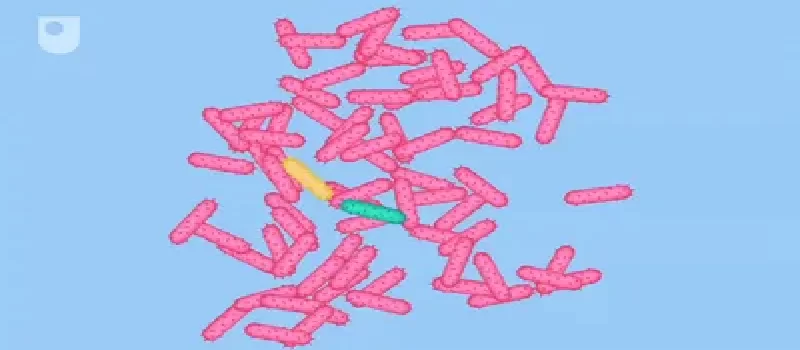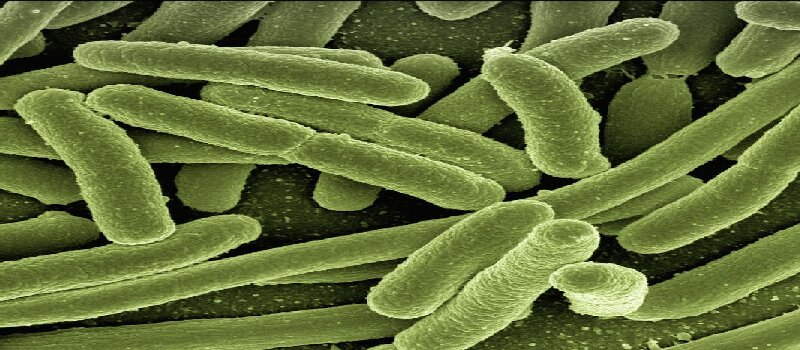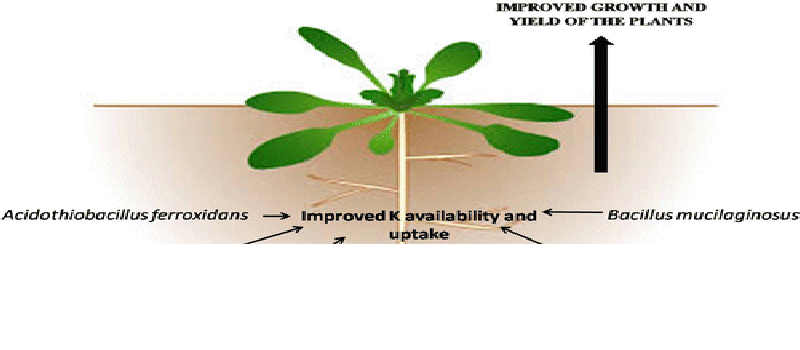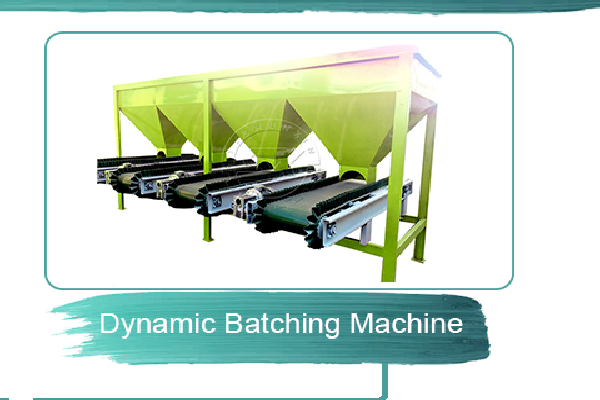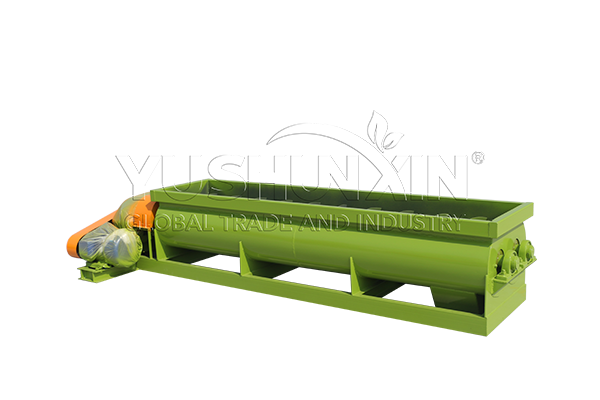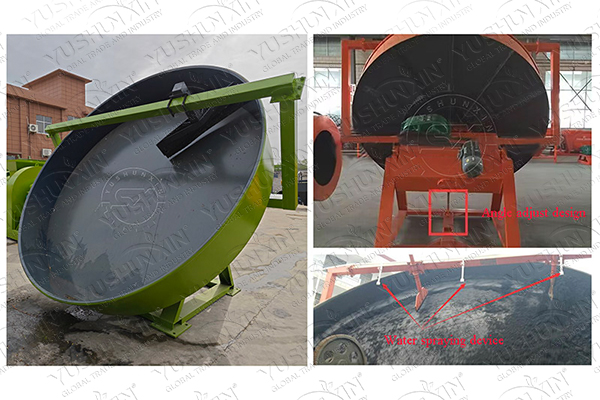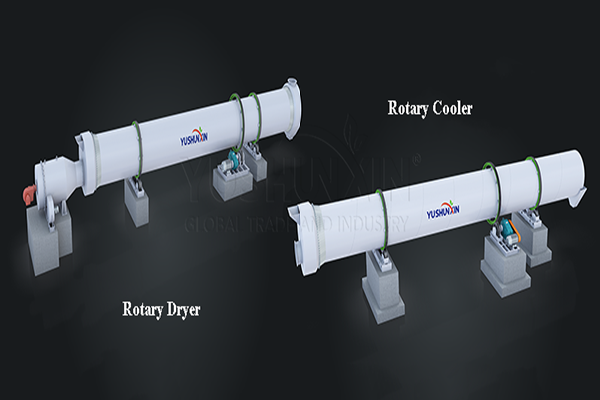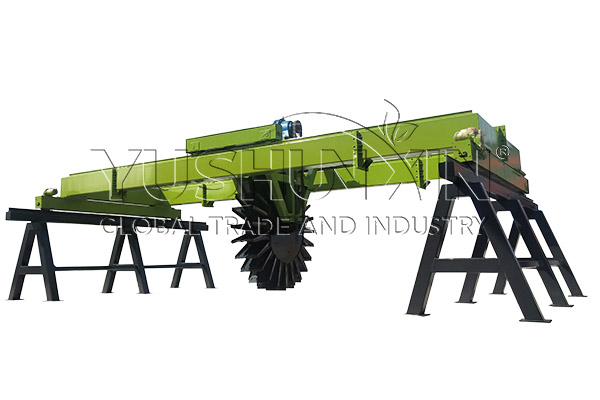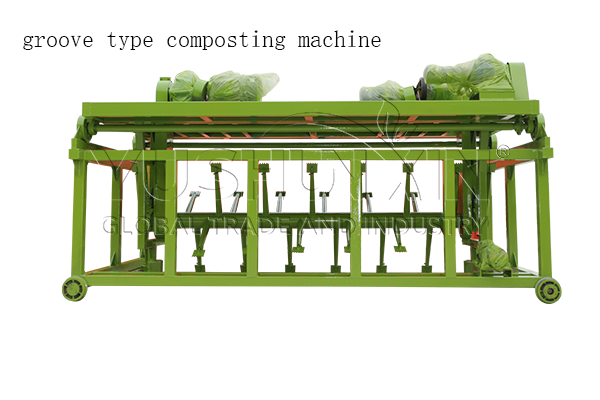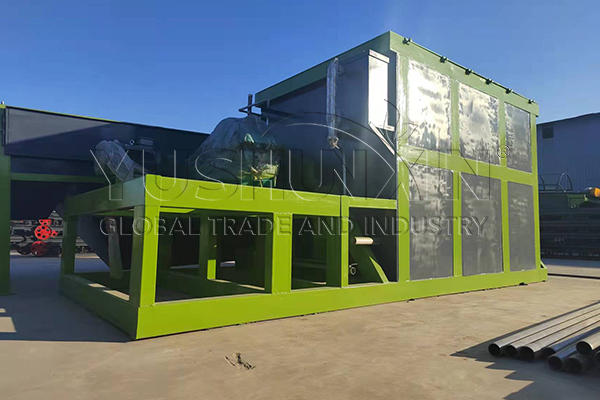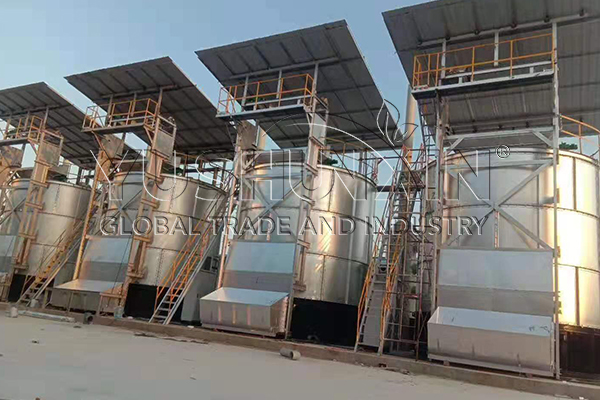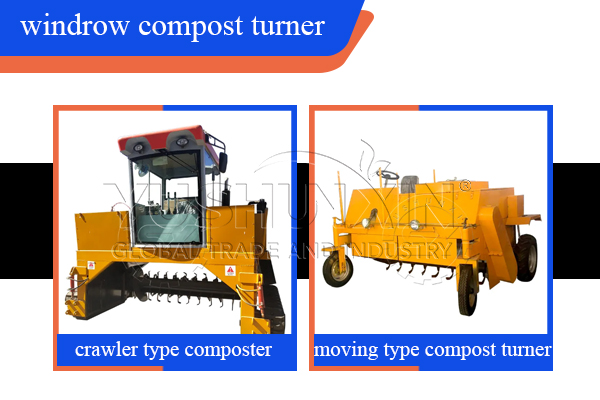Our FAQ
Here, we can help you answer many questions. You can learn about biofertilizer production knowledge to help you better production.
- Bio Compound Fertilizer
- Bio Fertilizer Machine
- Bio Organic Fertilizer
- Biofertilizer production cost
- Liquid biofertilizer production
Small-particle biofertilizers are easy to apply and have a high market demand. But do you know how to make 1-5mm biofertilizer pellets? Choose the right granulation machine can do this. YUSHUNXIN can provide you with the pan granulation machine. It has a 93% success rate in granulating bio fertilizer pellets of 1-5 mm size.
The ideal granulation machine to make 1-5mm biofertilizer pellets–disc pelletizer
Through controlling the raw material moisture and adjusting the pan slope angle, you can start 1-5mm bio fertilizer granule production plan.
1. Control the biofertilizer moisture content:
The pan granulation machine adopts the wet granulation method. So you should keep the water content of raw material in 30-40%. Generally speaking, less moisture, smaller size. Much water, bigger size. You can make large-sized biofertilizer granules by adding water or other liquid bacterial agents.
2. Adjust the pelleting disc angle:
During the biological fertilizer granulation process, you can adjust the disc tilt angle to obtain biofertilizer granules of different sizes, with an adjustment range of 35°to 55°. Sharp slope, smaller size; slow slope, bigger granules. After adjustment, remember to tighten the bolts to prevent accidents.
What other equipment used for 1-5mm biofertilizer granules production?
Before granulation, the vertical grinder can crush various biological fertilizer raw materials into fine powder, which is more conducive to disc granulation. After granulation, in order to obtain your satisfactory bio fertilizer particles, a drum screening machine is put into use. By replacing the sieve, you can get 1-5mm granules. And the mesh material is galvanized steel, which is not easily corroded.
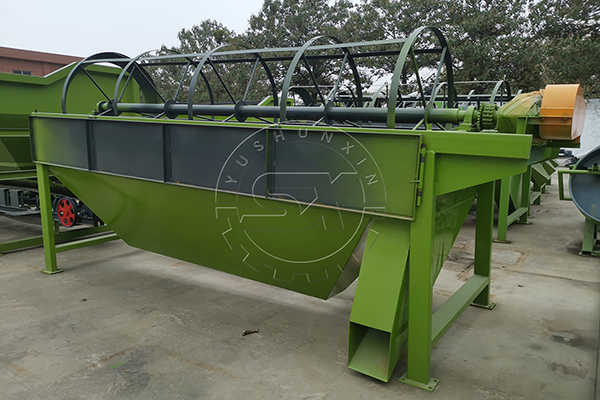
The liquid biofertilizer manufacturing plant cost is $40,000-$750,000. The greater the output, the higher the cost. A complete bio liquid fertilizer production line configuration includes: duplex filter, UV sterilizer, fermentation reaction tank, batching tank, automatic filling machine, auxiliary equipment etc. Learn more below!
How much does it cost to set up a liquid biofertilizer production line?
The price of a complete set of liquid biofertilizer production equipment varies depending on many factors. It is usually between $40,000 and $750,000.
The small-scale liquid biofertilizer manufacturing plant cost is between $40,000 and $70,000. If your expected output is low (5-10 tons/day), some basic models in the small production line can meet your needs. We mostly configure 5-10 m³ fermentation tanks for it. It is relatively cheap and easy to operate, and can meet basic bio liquid fertilizer production requirements.
These prices usually include installation and commissioning costs. As for training costs, YUSHUNXIN generally provide you with basic operation training at no extra charge. Regarding commissioning costs, we can provide you with remote video guidance to help you successfully install the liquid bio fertilizer making machine.
What is the basic equipment of liquid biofertilizer manufacturing plant?
The basic configuration of bio liquid fertilizer production line includes: animal manure dewatering machine, duplex filter, two UV sterilizers, fermentation tanks, batching tank, automatic filling machine, ect.
What is the best payment solutions for liquid biofertilizer production line provided by YUSHUNXIN?
Generally, after signing the final liquid bio fertilizer production project contract, you need to pay a 40% deposit. This ensures that we can start arranging the production and preparation of the liquid fertilizer equipment for you. After about 30-35 working days, the bio liquid fertilizer production unit will be completed. You need to pay all the final payment before shipment.
If you want to build other types of biofertilizer production plant, we will provide the detailed biofertilizer manufacturing plant cost. We can customize manure biofertilizer production plans, granular biofertilizer production lines, etc. for you. Welcome to consult!
Generally speaking, the 15 t/h biofertilizer manufacturing plant cost is between $60,000-$550,000. It depends on the type of biofertilizer you want to produce. The cost of powder biofertilizer production line is lower than that of a biofertilizer granulation production line. According to your budget, we can configure different bio fertilizer making machines for your 15t/h biofertilizer manufacturing plant.
Budget of $60,000-80,000 to setup a powdered biofertilizer production line:
If your budget is between $60,000-80,000, you can consider establishing a 15t/h powdered biofertilizer production line. Due to the simple production process of powdered bio fertilizer, YUSHUNXIN has equipped it with a compost turner, loader type feeder, SXFLF-1000 vertical crusher, SXGS-1870 drum screening machine, double bucket packaging machine, and belt conveyor. These are just the basic configurations of a 15t/h powder bio fertilizer manufacturing plant. You can communicate with us for customization.
How much does the 15 tons/hour granular bio fertilizer plant cost?
So how much does the 15t/h granular biofertilizer manufacturing plant cost? Between $360,000 and $500,000. In addition to the complete powdered bological fertilizer making machine, this granulation line also includes a bio fertilizer granulator, drying and cooling equipment, and a coating machine. Bio fertilizer granulation machine is critical. Regarding the choice of pelletizer, a SXZGZ-2080 drum granule making machine is sufficient. In order to improve the granulation effect, you can install a disc granulator after it. If you want to save costs, you can also directly purchase 3 SXYZ-3600 disc pelletizers.
How much raw materials does a 15t/h bio fertilizer production plant need?
Generally, 3 tons of raw materials are required to produce 1 ton of bio organic fertilizer. This means that the raw material output ratio is 3:1. Then, you need to prepare 45 tons of raw materials to produce 15 tons of bio organic fertilizer. The raw material output ratio for producing bio compound fertilizer is about 1:1.2, so you need to prepare 18 tons of raw materials. YUSHUNXIN’s 15-ton biological fertilizer production line can process many raw materials, such as cow dung, chicken manure, biogas residue, etc. Welcome to consult!
By using the liquid biofertilizer production technology, you can efficiently make liquid biofertilizer from fish waste. It needs to crush, sterilize, chelation filtration, adding microbial agent. You can get more details below. YUSHUNXIN has the fish waste bio liquid fertilizer making line, welcome to consult!
Step1: Crushing fish waste into fine powder for liquid biofertilizer production
First, use a double-shaft shredder to crush fish bones, fish meal, and fish slaughterhouse scraps into fine powder. This makes it easier to fully contact with water and other additives. It can accelerate the enzymatic hydrolysis and fermentation process. YUSHUNXIN equips the double-shaft crusher with high-strength stainless steel blades. It can easily crush hard materials.
Step2:Adding water and sterilizing for getting safety bio liquid fertilizer:
Then, add water to the crushed fish paste in proportion. The amount of water is preferably 5 times that of the fish paste. At the same time, in order to ensure the quality of the liquid biological fertilizer, it must be sterilized to eliminate harmful microorganisms contained in the liquid. Sterilization and disinfection are mostly in high-temperature. So you need to temporary storage and cooling.
Step3: Chelation filtration to obtain high-quality liquid biological fertilizer
Then there is an enzymatic hydrolysis and fermentation process that lasts for 3-5 days. Enzymatic hydrolysis can effectively reduce the difficult-to-decompose organic matter in the raw materials, which is beneficial to improve the purity and quality of fish protein liquid fertilizer. Then filter out the impurities to obtain a pure liquid. YUSHUNXIN‘s chelating tank integrates fermentation and filtration, which can increase its speed.
Step4 : Cooling and adding microbial agents:
You still need to cool the liquid after enzymatic hydrolysis. Then, please add microbial strains and elements with different functions according to your needs to make fish protein liquid biofertilizer with different effects. Common microbial agents include compound Bacillus, compound enzyme preparations and other beneficial microbial flora.
Finally, use a fully automatic filling machine to package it into fish protein biofertilizer of different specifications for sale.
Tips :
If the liquid biofertilizer after enzymatic hydrolysis has foam or is not viscous enough, you can add honey, maltose, brown sugar, and emulsifier to increase the viscosity of the liquid.
Mushroom residue is one of the raw materials for producing biological organic fertilizer. Making biofertilizer from spent mushroom substrate requires composting, granulation, drying and other processes. At the same time, there are some precautions in each step. You can learn more details from the following.
How to prepare spent mushroom compost as biofertlizer ?
First, mix the mushroom compost waste with animal manure and lime in a certain proportion, and then water it to make the moisture content of the compost pile reach 50%-55%. Pile it into a one-meter high pile. Composting takes about 3 weeks to complete. Then, crush it to get powdery spent mushroom compost. Granulation is one of the important steps to convert the compost into bio organic fertilizer granules. The produced spent mushroom compost bio organic fertilizer pellets need to go through a drying and cooling process to maintain stable performance. Then using screener machine to sieve out the granules of appropriate size for packaging.
What machine needed to make biofertilizer from spent mushroom substrate ?
In mushroom compost making process, manufacturers need to use a compost turner to speed up the fermentation time of mushroom waste. Strip composting is the most convenient way. Therefore, you can use a crawler composting machine or a self-propelled compost turner. Similarly, it is necessary to choose suitable biofertilizer granulation equipment. For large-scale bio fertilizer manufacturers, YUSHUNXIN advises that you use a drum granulator, and for small and medium-sized compost mushroom substrate organic biofertilizer production lines, the disc pelletizer is good. In the drying and cooling process, we can provide you with a drum dryer and cooler.
In addition to some bio fertilizer making machines, YUSHUNXIN can provide you with a complete spent mushroom biofertilizer production line, welcome to consult!
In addition, YUSHUNXIN can design suitable biofertilizer production line for you according to different raw materials. Such as cow dung biofertilizer business plan and bio compound fertilizer production project. Welcome to consult!
Do you know what is what is the main process in making biofertilizer? Fermentation, granulation, drying and cooling, and the addition of microbial agents are essential. You need to strictly control the process flow to obtain high-quality bio fertilizers.
How to make high-quailty bio compost for biofertilizer production?
Advanced fermentation technology is the first step in making high-quality biofertilizers. Strip composting is the most common composting process.
Mix different types of organic raw materials (such as feces, kitchen waste, crop straw, etc.) evenly and compost them into a triangle or trapezoid with a height of 1.5 meters to 2 meters, a width of 2-3 meters, and a length of more than 3 meters. The suitable organic microbial carbon-nitrogen ratio (C/N) is 20~35/1. At the same time, the moisture should keep in 60-65% during the fermentation process. You can use windrow type composting machine to control the temperature, humidity, and moisture in the compost.
Key step for converting powder compost biofertilizer into granules:
Granulation is the most critical process in making biofertilizer. Common granulation processes include wet granulation and dry granulation. You can choose according to the moisture content of the raw materials. Wet granulation requires the feed moisture to be around 30%, while dry granulation requires the material to be 10%, which is mostly used to produce bio compound fertilizers.
The needed granulation machine in YUSHUNXIN has the dry roller extrusion granulator. wet disc granulator, and drum pelletizer. Please note: Before granulation, it is most appropriate to crush the raw material into a particle size of about 50 mesh.
After granulation process, what should i do to make bio fertilizer?
In order to maintain the stability of the biological fertilizer, you need to dry and cool it. The hot air furnace sends hot air into the drum dryer in a downstream manner, the biofertilizers temperature continues to rise, the surface moisture gradually evaporates, and the moisture decreases. Producing compound biofertilizer should pay attentation to its heat-sensitive. When it has a high moisture content, the only way to speed up the drying speed is to open the hot air door and increase the amount of hot water.
There are many benefits to start a compound biofertilizer production line. Not only can you produce a variety of chemical fertilizers, such as NPK biological fertilizers. Moreover, bio compound fertilizers have a wide range of uses and huge market demand. Before establish a bio compound fertilizer plant, it is essential to make adequate preparations. But do you know what preparations should be made in the early stage of setup a compound biofertilizer plant?
How much demand have in market for compound biofertilizer?
When launching a bio compound fertilizer production plan, you need to conduct soil analysis on the target market. Then accurately locate the local customer demand for biological compound fertilizers. This will directly affect the content of nitrogen, phosphorus, potassium, medium and trace elements in compound biofertilizers. Different crops have different requirements for nutrients. For example, sweet potatoes, potatoes, and beets have a large demand for potassium. A full understanding of market demand can increase the sales of compound bio fertilizers.
Raw material used in compound biofertilizer prodcution:
The raw materials required for the production of bio compound fertilizers are mainly ammonium phosphate, potassium chloride, urea, potassium sulfate, ammonium sulfate, superphosphate and some auxiliary materials (decomposed materials), etc.
What machines used in the compound biofertilizer production line?
If you want to ensure the normal operation of the compound biofertilizer production line, it is necessary for investors to choose high-quality bio fertilizer machine. When manufacturing bateria compound fertilizer, you should purchase fertilizer crusher, fertilizer mixer, fertilizer granulator, fertilizer dryer, fertilizer cooler, fertilizer screening machine, fertilizer coating machine and fertilizer packaging machine.
Here, I would like to show you the complete set of machinery that YUSHUNXIN successfully built a 20-ton compound biofertilizer production unit for a Pakistani customer, just for your reference.
Subsequent plans for the bio compound fertilizer business plan:
Similarly, you also need to consider the sales plan after the production of compound biofertilizer according to market changes. At the same time, please formulate a reasonable price for bio compound fertilizers. At the same time, adopt superb marketing skills to gain market competitiveness. While producing, you should save water and energy, protect the environment, and strive to become a biofertilizer manufacturer with both fame and fortune.
The moisture content of raw materials is very important for biofertilizer manufacturing process. The optimal production water content is around 30%. You can use methods to reduce it in order to obtain high-quality biofertilizer. If you have any questions, welcome to contact YUSHUNXIN!
The suitable moisture content of raw materials in biofertilizer production:
Generally speaking, a moisture content of 30% is most suitable for producing bio fertilizer. Too high a moisture content will cause the biological fertilizer to mold and deteriorate, affecting the quality of the biofertilizer. If the water content is too low, the biofertilizer will dry out. It is not conducive to the growth of microorganisms.
How can I reduce water content in biofertilizer manufacturing process?
Generally speaking, the raw materials for bio organic fertilizer production are mostly animal manure, plant residues and other organic wastes. They have a high moisture content. You should process. The raw materials for producing bio compound fertilizers are mostly chemical fertilizers with a low moisture content.
Dehydration of animal manure:
First, you can use a manure dewatering machine to reduce the moisture content of manure to about 30%. If the water content of manure is above 90%, you can choose an inclined screen dehydrator. If the moisture content is between 80% and 90%, a spiral dehydrator is more suitable.
Fermentation of organic waste:
Composting fermentation is an effective way to reduce the moisture content of raw materials during the biofertilizer manufacturing process. As the composting process progresses, the water in the raw materials will gradually be consumed and evaporated, resulting in a gradual decrease in the overall water content of the compost.
Drying of biofertilizer after granulation:
Moisture may also be produced during the granulation process. This is because some bio fertilizer granulation machines adopt wet granulation technology, such as disc granulators, drum pelletizer, etc. However, in order to ensure the quality of bacteria fertilizer, you can add a rotary dryer and drum cooler after granulation to reduce the moisture content of biological fertilizer.
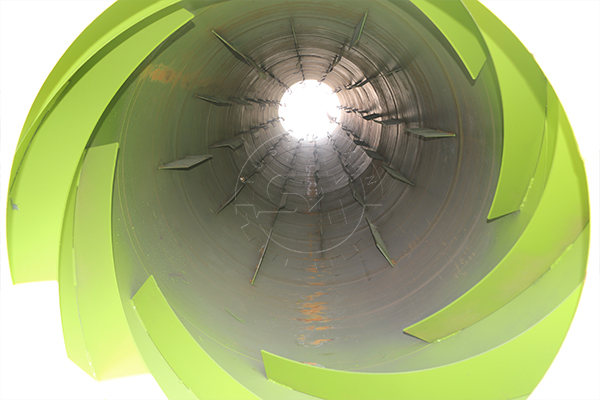
If you add microbial agents during the granulation process, please use low temperature drying. If you add it after drying, we advise you use a coating machine.
The double roller granulator is a high-quality biological fertilizer granulation equipment. It uses dry granulation technology to quickly make chemical powder into granules through double roller extrusion. Due to its corrosion resistance and low investment, it is favored by many bio NPK fertilizer manufacturers.
What is the pelletizing process of double roller pressing granulator?
When using the roller extrusion granulator to make bio NPK fertilizer granules, the following is the complete process: First, the belt conveyor transports the bio NPK raw material (N, P, K, little bio compost ect. )to the roller extruder. Secondly, the raw material will pass through two counter-rotating granulation roller sheet. These shafts have specific molds and ball sockets, and under the action of extrusion, a uniform size of bio NPK fertilizer is formed.
Methods for adjusting bio NPK fertilizer granules with double roller granulator:
The final size of the NPK bio fertilizer granules produced by the double roller extrusion granulator is between 3-10mm. It is related to the shape of the ball sockets on the two rollers. You can choose a roller with a ball socket of the required size. In addition, adjusting the distance between the two rollers is also a method. The smaller the roller spacing, the larger the size of the NPK bio fertilizer pellets. So, by adjusting these two roller, you will produce different size of bio compound fertilizer granules.
How much capacity can I setup a NPK biofertilizer plant using a double-roller extrusion granulator?
The maximum output of the double roller press granulator is 2t. Therefore, you can use it to set up the small scale compound biofertilizer production line. But don’t worry. It is also suitable for large scale NPK bio fertilizer manufacturing plant. You only need to buy a few more for your roller extrusion granulator production line. For example, when you want to produce 6 tons of bio-fertilizer per hour, YUSHUNXIN can configure 4 roller extrusion granulators with an output of 1.5 tons per hour for you. If you have other output requirements, please contact us!
Notes on using double roller granulator in bio NPK fertilizer production line:
NPK biofertilizer granules not hard enough:
The hardness of biological NPK fertilizer pellets produced using a double-roller granulator is generally 15-20N. If the hardness of the granules is not enough, you can adjust the compression force of the granulation machine, or use a suitable adhesive.
Wear of the roller press:
Long-term use of the roller press granulator will cause wear of the granulation roller skin. YUSHUNXIN’s double rollers are made of 20GrMoTi and can be used for about half a year. We can also provide you with spare parts. Of course, you can also buy them locally.
Generally speaking, for 1 ton organic biofertilizer making, it takes 3 tons of raw materials. This is calculated by a conversion rate of 3:1. And you also need to add raw materials such as microbial agents according to the proportion. By analogy, you can calculate how many tons of biofertilizer you can produce based on the raw materials you have. If you are not sure, please contact YUSHUNXIN.
What is the ratio of raw materials to final biofertilizer output?
On average, the ratio of raw materials to final bio fertilizer output is 3:1. This ratio depends on factors such as moisture content, nutrient concentration, and the specific biofertilizer production technology. So, when producing 1 ton of bio fertilizer, you should prepare 3 tons of raw material. Similarly, take the 30 tons of cow manure as example, when disposing it, you can consider to setup 10 t/h organic biofertilizer making line.
What are the raw materials for 1 ton organic biofertilizer making?
Many raw materials are needed to produce 1 ton of biofertilizer, usually organic matter, microbial strains, mineral substances, etc.
Organic waste:
Usually, you can convert 3 tons of organic waste into 1000kg biofertilizer. Such as plant residues, poultry and livestock manure, etc. But you need to ferment and compost it.
Microbial strains:
When producing biofertilizers, it is usually necessary to add a certain number of microbial strains, such as bacteria, fungi, algae, nitrogen, phosphorus, ect. You should add 100kg microbial strains in making 1 ton biofertilizer.
Mineral substances:
Similarly, when producing 1 ton of biofertilizer, it is best to add about 0.1 tons of mineral substances to increase the nutrients of biological fertilizer.
If I have 3,000 cows, how many tons of biofertilizer can I produce according to 3:1?
When you have 3,000 cows,You can convert the cow dung into bio organic fertilizer. Generally, you can use it to produce 4 tons per hour. An adult cow produces 35 kg of dung per day, so 3,000 cows produce 10,500 kg of dung per day. Since the output ratio of raw materials to final bio fertilizer is 3:1, you can produce 35,000 kg of biofertilizer, which means that the daily output of biofertilizer can reach 35 tons. If you work ten hours a day, you can choose to setup a small bio fertilizer production line with an hourly output of 4 tons.
So, addording to the 3:1, you can get the raw material need to produce organic biofertilizer. If you want to know more detailed information, please contact with us!
Generally, it takes about 30-35 days to produce organic biofertilizer. It is divided into the organic material composting stage and the biofertilizer processing stage. The specific number of days is related to the bio fertilizer process and output. Welcome to consult us!
What is the organic waste composting process?
In the process of bio organic fertilizer production, the raw material fermentation stage takes about 25 days. First, the warming stage lasts for 2-3 days, and mesophilic microorganisms (such as bacteria and fungi) begin to decompose organic matter. Next is the high temperature stage of 8-12 days, when the temperature rises to 60-70℃, further decomposing complex compounds into simpler forms and neutralizing pathogens. Finally, there is a 5-10-day maturation stage, when the compost gradually stabilizes and produces a humus-like substance.
Process of turning compost into bio organic fertilizer:
It may take 5-10 days to process the mature organic compost into bio fertilizer, and it takes faster to produce organic biofertilizer powder. You only need to use biofertilizer shredder to crush the organic material. Then use a rotary drum sifter to separate the appropriate bio organic fertilizer powder. The process of making granular biofertilizer also requires pelleting, drying, cooling and other processes. So its production cycle is relatively long.
How to quickly produce organic biofertilizer?
1. Use compost turner to speed up fermentation:
In order to speed up the composting of organic waste, YUSHUNXIN advises that you use a compost turner. It can regulate oxygen and ventilation in the compost and promote microbial activity. This effectively speeds up the compost fermentation and improves fermentation efficiency and quality.
2. Use efficient bio fertilizer making machine:
The use of highly automated biofertilizer equipment can reduce the labor input of the bio organic fertilizer production line. While reducing the possibility of manual errors, it speeds up the production of organic biofertilizer. YUSHUNXIN‘s biological organic fertilizer production line has a high degree of automation and is easy to operate.
Of course, the production process of bio compound fertilizers and liquid biofertilizers is simpler and the production cycle is shorter. If you want to produce biofertilizer quickly, you can choose them!
Do you want to know the success rate of converting biofertilizer powder into granules? First of all, you need to know what machines are used to make bio fertilizer granules. Generally speaking, there are double-roll extrusion granulators, disc granulation machine, and drum pelletizer. The granulation rate of bio fertilizer granule making machine can reach up to 95%.
The highest bio fertilizer granulation rate:
Generally speaking, the minimum percent of good quality bio fertilizer granule production is 95%. you can use the roller extrusion granulator to do. It can successfully produce 3-10mm bio organic fertilizer granules through double-roll extrusion.
Pan pelletizer granulating rate:
When using a disc granulator to make organic biofertilizer pellets, the success rate can reach 93%. Under the action of centrifugal force, by rotating the granulation disk, you can produce bio organic fertilizer granules with a size of 1-8mm.
Drum granlator pelleting rate:
When in a large bio organic fertilizer manufacturing plant, we advise that you use a drum pellet making machine with a granulation rate of about 90%. It can produce 1-8mm bio fertilizer pellets and has an output of 1-30 tons.
Methods to improve the granulation rate of bio fertilizer granule making machine:
Crushing before biofertilizer granulation:
First, crush the raw materials before granulation. Use a bio fertilizer grinder to crush the biofertilizer raw materials into fine powder of about 50 mesh. The raw material particles after crushing are more compact. This can ensure that the pellets after granulation are more solid and easier to granulate.
Add a disc granulator :
In addition, in order to improve the granulation rate of bio fertilizer granule making machine in large-scale plants, you can install a disc pelletizer after the drum granulator. This can not only meet the production requirements, but also improve the pelleting rate.
When you want to set up a biofertilizer manufacturing plant in Australia, you need to make a lot of preparations. For example, choose to produce bio organic fertilizer or compound biofertilizer? Make powdered or granular bio fertilizer ? How much land to prepare? These are the key factors of the biofertilizer business plan in Australia.
What kind of biofertilizer can I produce in Australia?
Choosing what kind of biofertilizer to produce for you biofertilizer manufacturing plant is the most important. This will determine your production raw materials. Make bio organic fertilizer? Or produce compound biofertilizer?
Bio organic fertilizer making:
Producing bio organic fertilizer generally uses farm animal manure, agricultural waste, and industrial waste as raw materials. The process of making bio organic fertilizer generally includes: first remove excess water from the bio organic fertilizer raw materials, then mix the compost and ferment it, crush the organic compost into fine powder, and then make organic biofertilizer granules. Dry and cool to ensure the performance of the bio organic fertilizer, next screen out qualified products, and package them for sale.
YUSHUNXIN’s bio organic fertilizer production lines for sale include pig manure biofertilizer production lines, chicken manure bio fertilizer making lines, etc. In Australia, we have successfully helped customers build cow dung bio fertilizer business plan.
Compound biofertilizer manufacturing:
Can chemical materials be processed into bio compound fertilizer? Of course. The raw materials of bio compound fertilizer are urea, DAP, phosphate or other chemical raw materials and a small amount of biological compost. Thoroughly mix the crushed organic compost rich in nitrogen, phosphorus and potassium elements with chemical raw materials in proportion. Then turn the raw material powder into bio compound fertilizer granules by using bio fertilizer granulator. Buying chemical raw material powder as much as possible can improve the production efficiency of compound biofertilizer.
Which is better to produce powdered biofertilizer or granular bio fertilizer?
About this question, you can choose according to the Australian market, biofertilizer production process and cost budget.
Generally speaking, the process of producing powdered biofertilizer is simple. Its cost is $35,000-90,000. This requires: dehydrator, compost turner, bio fertilizer crusher, batching machine, mixer, screening machine, bagging equipment. In addition to the powdered biofertilizer system, the biofertilizer granulation line also needs to select pelletizing machine according to the raw materials, as well as subsequent cooling and drying equipment, coating machines, etc. Its cost is generally between $110,000 and 550,000.
What is the floor area of the biofertilizer producing line?
Usually, biofertilizer production factory are built in areas close to raw material plants and with developed transportation. When setting up a biofertilizer manufacturing plant in Australia, it is as close to suburbs such as farms as possible. The area is related to the scale of the production line and the form of biofertilizer.
The above is the general content that needs to be considered when establishing a biofertilizer production plant in Australia. If you still have questions, please consult YUSHUNXIN!
Do you want to easily handle cow dung? Why not use a disc pelletizer to make it into biofertilizer? It can quickly produce 3-10mm cow dung bio fertilizer granules with a granulation rate of up to 93%. However, before pan granulation, you need to disposal of the cow dung in advance. There are a the disc granulation cow dung biofertilizer line on sale in YUSHUNXIN. welcome to consult!
How to treat cow manure before disc pelletizer process?
Fresh cow dung cannot be used directly as biofertilizer. First, use an animal manure dehydrator to reduce the water content of cow dung. Then, in order to increase the organic matter content of cow dung biofertilizer, you can mix it with organic waste such as plant residues and compost them. For this, using a compost turner can speed up the fermentation cycle. You can consult YUSHUNXIN about the model of the compost turner based on the output.
How to use a disc granulator to make cow dung biofertilizer?
Fermented cow manure compost may clump together. Use a vertical crusher to crush it before granulation. Then feed the powdered cow dung biofertilizer into the disc pelletizer through a belt conveyor. The disc starts to rotate, and under the action of centrifugal force and gravity, cow dung biofertilizer particles are gradually formed. During the granulation process, you can add water or microbiological culturer to speed up the granulation. The final granulation rate can reach more than 93%.
Suggestion: The granulation size of the disc pelletizer machine is 3-10mm. You can regulate the pan slop angle or control the cow manure moisture to regulate the cow manure biofertilizer granules size.
Is there a complete disc granulation cow dung biofertilizer production line?
Of course, YUSHUNXIN has a set of cow dung bio fertilizer disc granulation line. The production line includes cow dung composting turning machine, vertical crusher, drum screening machine, disc granulator, drying and cooling equipment, etc. Its output is about 1-6 tons, which is suitable for small-scale cow dung biological fertilizer manufacturers. You are welcome to consult to get the cow dung biofertilizer production line cost.
Are you thinking about how long it will take to receive the YUSHUNXIN‘s biofertilizer production equipment? There will answer your questions about the delivery cycle of biofertilizer equipment, the delivery process, and the after-sales service of equipment. If you want to know more details, please feel free to consult!
How long does it take to receive the bio fertilizer making equipment?
Are you looking forward to receiving the biofertilize production equipment quickly? Usually, when you determine the bio fertilizer equipment or production line you want to buy, YUSHUNXIN’S staff will start production and deliver the goods in about 35 working days. The larger the output of the bio fertilizer production line, the longer it takes. For example, a Nigerian customer received the purchased bio NPK fertilizer production line about 30 days after placing the order. You can contact us to get the specific delivery period.
How is the delivery process of biofertilizer making machine?
First, you need to tell us the biofertilizer equipment you need. With the support of technicians, we will determine the final biofertilizer production plan for you. Then pay a 40% deposit through a bank guarantee, and the factory will start production. About 30 working days to Delivery. However, you should settle the final payment before shipment. The bio fertilizer manufacturing line or equipment will be shipped from the port of China by container to the port closest to you.
Can I customize biofertilizer manufacturing equipment?
Of course, YUSHUNXIN can customize bio fertilizer production lines and equipment according to your needs. Such as animal manure biological fertilizer production lines or liquid NPK bio fertilizer production lines. You can also customize biofertilizer equipment, such as customizing dust covers for disc granulators.
What are the vulnerable parts of bio fertilizer equipment? Can I buy them locally??
Usually, Common vulnerable parts include: biofertilizer screening machine’s galvanized steel screen , roller skins of double-roll extrusion granulators, belt conveyor equipment, etc. You can buy them locally. YUSHUNXIN’s biofertilizer production equipment is exquisitely designed and produced in standard, and can be purchased directly in the local market.
Producing NPK liquid bio fertilizer can bring you huge economic benefits. But do you know how to make liquid NPK biofertilizer? Its production process is simply divided into five steps: crushing raw materials, raw material ratio, adding water to react, filtering and purifying, filling and selling. YUSHUNXIN has a complete set of liquid NPK bio fertilizer production lines, welcome to consult!
What is the liquid NPK fertilizer manufacturing process?
First, use a biofertilizer grinder to crush the bio compost, n, p, k and other raw materials. Then the dynamic batching machine can mix the raw materials according to the proportion. Then add water to the well-proportioned raw materials. The resulting liquid will react in the liquid chelating tank. After the reaction, use a filter device to obtain pure NPK liquid biofertilizer. Then use a fully automatic filling machine to package it into different specifications for sale.
What equipment is necessary to make liquid NPK biofertilizer?
Grinder for crushing raw materials:
Powdery raw materials are more soluble in water. Therefore, you need to use a grinder to make the liquid NPK bio fertilizer raw materials into powder. The chain crusher on sale at YUSHUNXIN can quickly crush raw materials such as n, p.k into powders ≤3mm. The crushing speed is fast.
Dynamic batching machine:
The dynamic batcher uses an electronic belt scale to accurately control the output of raw materials in each bin. You can mix n, p, k raw materials according to the proportion. Then, use the transport pipeline to transport the NPK powder to the liquid chelating tank.
Liquid chelating tank:
The reaction tank for liquid NPK biofertilizer production can fully mix water with NPK powder to make it react. At the same time, you can also add some microbial cultures to it. These reaction tanks are usually sealed containers. It can control temperature, pressure and other reaction conditions to promote the growth and metabolic process of microorganisms.
The filter device:
In order to obtain purer liquid NPK biofertilizer, it is necessary to use a filter device. YUSHUNXIN’s filter is made of stainless steel, which is corrosion-resistant and its components have a service life of up to 5 years.
Fully automatic filling machine:
It can fill the pure liquid NPK biofertilizer obtained after filtration according to different specifications, such as large barrel filling, small bottle filling, etc. High degree of automation and rapid production.
In addition to liquid NPK biofertilizer, YUSHUNXIN can also provide you with granular NPK biofertilizer production line, liquid biofertilizer production technology and other solutions. You can contact us for more information.
The process of making liquid biofertilizer requires four steps: dehydration of raw materials, filtration of impurities, liquid sterilization, and mixed fermentation. Combining the above steps, we have planned four zones for bio liquid fertilizer plant in Singapore. At the same time, YUSHUNXIN can configure a complete liquid bio fertilizer production line, welcome to consult!
What is the liquid biofertilizer production process?
Usually, there are two processes for making bio liquid fertilizer. This is determined by the raw materials used. The Singapore plant intends to use animal manure as the raw material for liquid bio fertilizer. This requires six steps. First, separate the liquid from the animal manure. Next, build a manure sedimentation tank to settle the large impurities in the liquid. In addition, use a filtration device to obtain pure manure liquid. Then, the UV sterilizer will kill the pathogens in the manure liquid. After that, you can mix some microbial agent with the pure manure liquid, such as nitrogen, phosphorus, potassium, etc. After a few days of anaerobic fermentation, you will get animal manure liquid biofertilizer.
What equipment is used in bio liquid fertilizer plant in Singapore?
First, depending on the moisture content of animal manure, we provide screw extrusion dehydrators. It will quickly dehydrate the wastewater in the animal manure. Then, in order to get pure liquid bio fertilizer, it is necessary to use the filtration device. Next, using the UV sterilizers to Kill pathogens in manure liquid. The sterilization rate of YUSHUNXIN’s UV sterilizer reaches 99%. Then, YUSHUNXIN can provide the liquid bio fertilizer plant with anaerobic fermentation tank.
How to design a liquid biofertilizer plant in Singapore?
According to the liquid biofertilizer production technology, you can reasonably divide the bio liquid fertilizer plant into four areas. They are the raw material processing area, liquid biofertilizer production area, finished product storage area and work and living area. To ensure the continuity of liquid fertilizer production, the first three areas should not be too far apart. At the same time, in order to ensure the health of workers, the living area should be far away from the liquid fertilizer production area. You can plan the specific site size according to production capacity and budget. If you have an idea, please contact us!
The pan pelletizer is very popular among biofertilizer manufacturers at home and abroad. It gradually converts the powder raw materials into uniform biofertilizer granular form through rotating discs and moisture control. Its capacity is about 0.5-6 tons/hour. At the same time, the disc granulation machine is suitable for producing bio organic or compound fertilizer. Therefore, if you want to set up a biological fertilizer manufacturing plant, it will be an ideal choice for you!
What biofertilizer raw materials can the disc pelletizer granulate?
Making the powdery organic waste into pellets:
The bio disc granulator has a wide range of uses. It can produce 0.5-6 tons of bio fertilizer granules per hour, and can process organic waste such as powdered animal manure. Such as cow dung, chicken manure, etc. Please don’t worry about its corrosiveness. YUSHUNXIN‘s disc pelletizing machine can fully withstand it. Because it mostly uses Q235B boiler steel, it has good anti-corrosion properties. This can ensure that bio fertilizer granules can be produced for a long time.
Turning the bio compound powder into granules:
At the same time, the pan granulator can also make bio NPK fertilizer granules. It can process NPK powdered chemical materials into high quality bio compound fertilizer granules. At the same time, it can also make powdered materials such as urea and potash fertilizer into granules. If you are not sure, you can contact us. YUSHUNXIN can test the disc granulation material for you to help you understand the granulation effect.
How to adjust the particle size of biofertilizer pan pelletizing machine?
There are two ways to adjust the granules size. The first is to adjust the disc angle of the pan pelletizer. The larger the angle, the smaller the granulation size. The minimum granule size you can produce is 1mm. Another method is by control the moisture. You can control the water spray system to control the bio fertilizer raw material moisture. Less water, smaller size; much water, bigger size.
cow manure, as a common organic raw material, you not only make bio organic fertilizer from cow manure, but also make bio liquid cow manure fertilizer. To make liquid biofertilizer from cow waste, You can achieve by following these steps: dehydration, precipitation and filtration of impurities, disinfection, nutrient ratio, and anaerobic fermentation.
How to dehydrate the liquid in cow waste?
Using cow manure dewatering machine can effectively extract liquid components from fresh cow manure. There are two types for sale in YUSHUNXIN: spiral extrusion type and inclined screen type. Because the water content of fresh cow dung is usually 60%-80%, it is most appropriate to use a spiral dehydrator. After dehydration, the water content of cow dung is 20%-30%. It can be made into powdered or granular biofertilizer.
How to remove impurities from cow dung wastewater?
In order to obtain pure cow dung liquid bio fertilizer, you need to remove a large amount of impurities contained in it. First, you can build a sedimentation tank to precipitate the visible impurities in it. Then, use a filtration device to remove other impurities in the cow manure wastewater, such as silt, grass clippings, etc.
How to kill pathogens in filtered cow dung wastewater for making liquid biofertilizer?
The filtered cow manure liquid contains some harmful substances such as pathogens or insect eggs. Using a sterilization device can be of great help. So, in this step, YUSHUNXIN has configured two UV sterilization devices for the liquid bio fertilizer production line. Its sterilization effect can reach 99%. After sterilization, you can get high-quality cow dung bio liquid fertilizer.
How should you ferment liquid cow dung into biofertilizer?
Before anaerobic fermentation, by using the batching tank, you can add the biological agents and related ingredients to the cow dung liquid according to the proportion. The stirring device of the YUSHUNXIN fermentation tank can fully mix the material. Then control the temperature in the fermenter at 25-35℃. During the anaerobic fermentation process, you should turn on the stirring device on 1-2 times a day for 15-30 minutes each time to ensure uniform fermentation. After 7-10 days, the fermentation is over.
Secondary chelation Process
After the above steps, you can also add nutrients such as nitrogen, phosphorus, and potassium or water-souble humic acid to the mixture to increase the nutritional content of the liquid biofertilizer.
The above is the complete steps to manufacture liquid biofertilizer from cow waste. There are whole sets of bioliquid fertilizer unit on sale in YUSHUNXIN. You can get it at a preferential price, contact us for the latest quotation. At the same time, YUSHUNXIN has other cow dung biofertilizer production solutions.
There are many factors will affect the cost of bio fertilizer production, such as needed raw materials, human, production line type and machine selection. Generally speaking, the smaller the output, the lower the cost. For example, the 8 t/h biofertilizer producing factory cost is generally between $55,000 – $60,000 or $300,000 – $350,000. It varies according to the type of production line. You can get the details from the following.
What is the price of 8t/h biofertilizer granulation line?
If you want to setup an 8 t/h granule line for your biofertilizer plant, please prepare $300,000-350,000 in advance. In addition to the powdered bio fertilizer manufacturing line, you also need to purchase granulation equipment, drying and cooling machine, coating equipment, and bagging machine. For an 8 t/h biofertilizer factory, we advise that you choose the SXZGZ-2080 drum pelletizer. Of course, if you want to save on drying and cooling costs, you can choose to buy more double roller extrusion granulators. The bio fertilizer granules it produces are drier.
How much does it cost to produce 8 tons powdery bio fertilizer per hour?
The price of 8t/h powdery bio fertilizer production line is about $55,000 – $60,000. Its cost is lower than the bio fertilizer granulation line with the same capacity obviously. This is because the process of producing powdered bio fertilizer is simple. Therefore, YUSHUNXIN equipped this 8 t/h bio fertilizer powder production line with: crawler composting machine, SXFLF-800 new type vertical crusher, SXGS-1560 drum screening machine, and single bucket packaging machine. By using these machines, you can get high-quality powdery bacteria fertilizer.
How much raw material should I prepare for 8t/h biofertilizer producing factory?
Animal manure is a common raw material for bio fertilizer. Do you know how many tons of animal manure are needed to setup an 8 t/h bio fertilizer production line? Typically, producing 8 tons of biofertilizer may require about 10-15 tons of animal manure as raw material. In addition, to increase the nutrient content of biofertilizer, you need to mix it with other organic waste (such as straw , waste plants, etc.) for fermentation and composting. Buying animal manure from local sources will save your 8t/h biofertilizer producing factory cost.
In addition to the medium-sized biofertilizer production line with an output of 8 tons per hour, YUSHUNXIN can also provide you with small and large biofertilizer plant business plans. If you want to know the specific cost, you can contact us to get the latest quotation.
As an experienced bio fertilizer machine manufacturer, YUSHUNXIN can provide you with the best design of 10t/h powdery biofertilizer production system. Generally speaking, the process of making 10 tons powdery bio fertilizer per hour includes: fermentation process, crushing process, screening process, packaging process. There are some suitable machines for this bio fertilizer production business plan.
Wheel type compost turner used in the 10 t/h powdery biofertilizer production system:
For the fermentation process of the 10 t/h biofertilizer production system, you had better use the wheel type composting machine. Its maximum throwing width can reach 30 meters, and its turning depth can reach 1.5-3 meters. Clumping may occur after fermentation. For this situation, you can use the SXFLF-1000 new type vertical bio fertilizer grinder. It is the best choice for the 10 t/h powdery bio fertilizer production system.
The machine used in the screen process of 10 t/h powdery biofertilizer production plan:
Screening machine has two main functions: first, to screen out impurities in bio compost, such as stones and cigarette butts. Also, choose powdered biofertilizer that is consistent in size. When making 10 tons powdery bio fertilizer in an hour, you had better purchase the SXGS-1870 rotary screener machine in YUSHUNXIN.
Double bucket bagging machine for packaging 10 tons powdery bio fertilizer per hour:
Packaging is the last step of the entire biofertilizer manufacturing plant. The automatic packaging machine is automatically controlled by a power cabinet. It can quickly package finished products. This will improve production efficiency. For the 10 t/h powdery biofertilizer production system, you can use the double bucket bio fertilizer bagging machine.
In addition to the above machines, you also requires the purchase of some auxiliary equipment. Such as: automatic feeder, belt conveyor. Generally speaking, the cost of complete bio fertilizer production line is about $60,000. Also, there will be some discounts. Moreover, there are various bio-fertilizer production line in YUSHUNXIN. Such as chicken manure business plan, bio compound fertilizer line, liquid biofertilzer making line. At the same time, we can also customize according to your needs. In addition to the powdered biofertilizer production line, you can also set up a 10 ton biofertilizer granule production line.
Drum pelletizers are generally used to produce large-scale biofertilizers. The rotary drum granulator cost is about $5,000-$15,000 . Its output is generally 1-30 tons. The greater the output, the higher the price. It is not only suitable for fermented organic materials, but also can be used to produce biofertilizer compound fertilizer. In addition, it also has the advantages of novel design and large capacity. It is worth your purchase!
What is the typical price of A bio fertilizer drum granulation machine?
The cost of a rotary drum granulator typically ranges from $5,000 to $15,000. Small-scale models (1–3 tons/hour) are more affordable, while larger units (10–20+ tons/hour) require higher investment. The final price depends on capacity, materials, and optional features. Whether you’re starting a small biological organic fertilizer plant or scaling up an NPK fertilizer production line, we offer flexible models to fit your budget. At the same time, YUSHUNXIN will provide corresponding discounts regularly. You can contact us to get the latest quotation.
What affects the rotary drum granulator cost?
There are several factors that influence the granulator machine price, including production capacity, raw materials, and pelletizing drum material (e.g., carbon steel or stainless steel). High-automation designs with PLC systems, internal linings for corrosion resistance, or integration into a complete biofertilizer granulation line will also increase the cost. The more complex your bio fertilizer project, the more investment is needed — but it also brings long-term stability and efficiency.
Fresh chicken manure is a common raw material for making bio fertilizer. It contains 60%-80% water content. So you should dewater chicken drops before using them as bio fertilizer. To make the most of chicken manure, you can turn solid chicken litter into powdered or granular biofertilizer. Then, Then make the left chicken waste into liquid bio fertilizer. But do you know how to make chicken manure liquid biofertilizer? There are five steps in making liquid biofertilizer from chicken dung.
How to prepare the waterwaste from chicken dung for liquid biofertilizer production?
In the process of making cow manure liquid biofertilizer, if you want to get chicken waste water quickly, using a manure dewatering machine is a good choice. YUSHUNXIN has two types of solid-liquid separators. The first is the screw dehydrator, the other is the inclined screen solid-liquid separator. If you want to dewater fresh chicken manure, please choose the first. It can dehydrate chicken manure with a moisture content of 60-80% to about 20%. The dehydration efficiency is high. Then, you can get more chicken drop waterwaste by using it for liquid bio fertilizer production.
How to get pure chicken manure wastewater to make bio liquid fertilizer?
The dehydrated chicken manure wastewater may contain impurities such as grass clippings and stones. If you want to make high-quality liquid biofertilizer, it is necessary to remove these impurities. There are two steps to help you. First, build an animal manure sedimentation tank to precipitate the suspended matter in the chicken manure water. Then, pass the liquid after solid-liquid separation and sedimentation treatment through filters to remove residual impurities and solid particles.
How to kill pathogens in filtered chicken manure liquid?
After filtering process, you will get the purity chicken manure waterwaste. However, these waste water may contain pathogens and harmful microorganisms. So, the use of sterilization devices is necessary to make safe bio liquid fertilizers. It can kill germs in chicken manure liquid. In this step, YUSHUNXIN will provide you with the two UV sterilization device. It can kill 99% of pathogenic bacteria in chicken waste excrement.
How should I adjust the composition of chicken manure liquid biofertilizer?
In order to supplement the nutrient content of chicken manure bio liquid fertilizer, you can add some microbial agents to the disinfected chicken manure wastewater according to the recipe. At the same time, you can also add some auxiliary materials such as fermentation agents. This can shorten the fermentation time and improve the production efficiency of chicken manure liquid bio-fertilizer.
What is the last step of making chicken litter bio liquid fertilizer?
Fermentation is the last step in the production of chicken manure liquid fertilizer. For this, you can use a centrifugal pump to send the prepared mixture into the anaerobic fermentation tank for fermentation. The fermentation cycle of the entire chicken manure liquid fertilizer is about 3 days. After the fermentation is completed, you can use a liquid filling machine to package it into different specifications for easy sale.
This is the complete process to make chicken manure liquid biofertilizer. At present, YUSHUNXIN has a complete set of chicken manure liquid bio-fertilizer production lines for sale at a preferential price. You can contact us for the latest quote and detailed information.
Double extrusion pelletizer is is a dry bio fertilizer granulation machine. You not only use it in bio organic fertilizer production, but also in compound biofertilizer making line. The double roller extrusion granulator price is about $2,000-$5,000. You can choose it according to cost, raw materials, and production requirements.
The cost-effective bio fertilizer pellet making machine–double roller extrusion granulator:
Generally speaking, the double roller extrusion granulator price is about $2,000-5,000. In additional, it adopts the dry granulation method. This eliminates the need to dry and cool the bio fertilizer after granulation. You can pack them directly. Therefore, bio fertilizer manufacturers will save the cost of cooling and drying machine. Moreover, the roller extrusion granulator has the long service life. It is made of Q235 boiler steel. For the wearing part, we use 20GrMoTi as the roller sheet material. So, compared with other biofertilizer granulators, the double extrusion pellet making machine is very cost-effective.
What raw materials are suitable for the roller granulator?
As the above mentioned, the roller extrusion pelletizer is suitable for making bio compound fertilizer. So you can prepare zinc sulfate, potassium chloride, ammonia chloride, and ammonia sulfate etc. to make bio compound fertilizer. But please pay attention to the feed moisture in producing organic bio fertilizer by using it. The most suitable moisture of raw materials for double roller granulator is 5-10%. Or, you can send us at least 10 kg of raw materials, YUSHUNXIN‘s staff will help you to test.
Roller compactor granulator for biofertilizer with easy – to – adjust granule size from 3 – 10mm:
The roller compactor granulation machine makes biofertilizer granules by squeezing double rollers. The shape and size of ball socket on the roller sheet can be customized by customer’s requirement. So you have a wide range of options. Generally speaking, the final granule size and hardiness for double roller granulator is about 3-10mm and 15-20N. Moreover, you can get these bio fertilizer pellets in pillow shape, semicircle shape, stick shape and square bar shape.
There are many types of raw materials for making biofertilizers. Such as organic waste, batercial agent, algae and other microorganisms. But you need to choose according to the formula of bio fertilizer. In this way , you can get the high-quality biofertilizer.
What are the main raw materials for producing bio fertilizer?
Organic waste is the main raw materials for making biofertilizer. It includes animal manure, agriculture waste and so on. They are rich in nurtrent elements which are benefits for crop growth. Take the animal manure as example, the content of organic matter is about 25%.They are 1.63%N, 1.5%p205, 0.85%k20 in the poultry waste. In additional, you also can use agriculture waste as bio fertilizer. Its organic matter content is about 15%. You can mix the animal waste with agriculture accoring to a certain proportion. Then compost and ferment it . Next through a series of biofertilizer granulation process, you can manufacture bio fertilizer.
Is the microbial agent the raw material for producing biological fertilizer?
If you want to production bio fertilizer, it is necessary to add bacterial agent. You usually should add the nitrogen-fixing bacteria, phosphate-solubilizing bacteria , potassium-solubilizing bacteria . For example rhizobium, pseudonymous, and bacillu. But please pay attention to the adding time. If you add them before granulation, use the drum dryer in low temperature. However, if adding the biological agent after drying, the coating machine is best choice to maintain the biofertilizer performance for you.
can I make bio fertilizer from seaweed?
Of course, making bio fertilizer from seaweed is good choice. The seaweed is rich in nutrients, contains a variety of organic matter and trace elements. At the same time, it is rich in biologically active substances, such as algal polyacrylamide and align. It also has strong stress resistance. Moreover, the production process is simple. First, clean the seaweed by using the freshwater, then ferment and crush it. You will get powdery seaweed bio fertilizer. Next, you can use bio fertilizer granulation machine to pelltize.
The above is the common raw material of the biofertilizer production. YUSHUNXIN has provided customers with various biofertilizer production solutions for many years, such as liquid biofertilizer production, nitrogen-fixing bacteria bio fertilizer production, chicken manure as biofertilizer production line, etc. If you want to produce bacterial fertilizer, please contact us.
Generally speaking, the 1t/h powdery biofertilizer plant cost is about $35,000. When you want to produce 1 ton biofertilizer powder per hour, you should prepare 4 tons organic waste. In additional, please consider purchase compost turner, biofertilier grinder, drum screener and automatic package machine. You can contact YUSHUNXIN to get the suitable machine for manufacturing 1 tons bio fertilzer powder according your budget.
What is the price of 1t/h powdery bio fertilizer plant?
Because of the simple process of making powdery, you will need less production equipment. The 1t/h powdery biofertilizer plant cost is usually in $35,000. When setting up the 1t/h powdery biofertilizer production line, you need to buy compost turner, bio fertilizer crusher, rotary screener and automatic bagging machine. At the same time, the production line will covers the 800㎡.
How to make organic waste into powdery bio organic fertilizer?
In fact, the process of making powdery biofertilizer is simple. First, you should ferment and compost the organic waste.In this process, using a compost turner is good for reducing the fermentation time. Comparing to pure naturally composting of 4-8 months’ time, it takes 20-25 days for YUSHUNXIN’s composting machines like the crawler type composting machine, groove compost turner, or moving type composting equipment. Then, crush the composted organic waste to powder. With rotary screener separating unqualified or qualified biofertilizer. unqualified gets re-crushed, qualified gets packaged.
How much raw material to produce 1 ton of powdered biofertilizer per hour?
There are many raw materials used to make biofertilizer, such as animal manure, crop straw and other organic waste. The ratio of organic waste to bio fertilizer is usually (3-4):1. This is because there will be a certain amount of loss during the production process due to moisture and some other factors. Therefore, when you want to produce 1 ton of powdered biofertilizer, you need to prepare about 4 tons of organic waste. At the same time, it is necessary for you to buy some biological agent to increas the nutrient elements of biofertilizer.
Are you curious about the necessary equipment for biofertilizer production? Generally speaking, in order to produce high-quality bio fertilizer, you need to use compost turners, crushers, biofertilizer granulators, drum screeners, etc. These are all necessary for bio fertilizer production lines. You can choose according to the scale of production line.
Making high-quality bio compost with composting machines
Compost fermentation is an indispensable part of the biofertilizer production. Through it, you can convert organic waste into bio-organic fertilizer. Such as animal manure, plant residue… To obtain high-quality compost, you can use a compost turner. There are many composting machines for sale in YUSHUNXIN: groove composters, windrow compost turners, and moving type composting machine etc. Of course, if you want to reduce the odor in fermentation, you can choose to use bio fertilizer fermentation tank.
Crushing compost materials into powder with compost grinder
Although the fermented bio compost is mostly powdery, it may have agglomeration. Therefore, you can use biological fertilizer grinder to crush it into fine powder. On the one hand, this can help you achieve the production of powdered biofertilizers, and on the other hand, biofertilizer powder is easy to granulate, which is convenient for the next step.
Granulating the biofertilizer pellets with pelletizers
The granulating machine is a necessary machine for pelletizing biofertilizer. It can granulate powdered materials by extrusion and other methods. Common bio fertilizer granulation equipment include drum granulators, disc pelletizer, roller extrusion granulators, etc. If the moisture content of your feed is high, we advise you choose a drum or disc granulator; when using them, you can also add biological agents or water to them. However, drying and cooling equipment is required to stabilize the performance of the bio fertilizer. In addition, if you want to save drying and cooling costs, you can choose a roller extrusion granulator.
What are other necessary equipment for biofertilizer production?
Rotary screening machine:
Using a screening machine can help you screen out qualified biofertilizer, which is also essential for manufacturing bio fertilizer.
Drying and cooling equipment
Using drum dryer is to reduce the water content of biofertilizers for storage, while cooling is to prevent the dried biofertilizers from agglomerating and stabilize the performance of bio fertilizer.
Biofertilizer coating machine
When producing biofertilizers, it is inevitable to add some microbial agents. The use of a rotary coating machine can prevent the volatilization of the agents and increase the slow-release effect of biofertilizers.
When you want to deploy the 6t/h bio organic fertilizer manufacturing plan, most biofertilizer producers will consider the equipment, the site, the possible contamination, and so on. Today, there is an optimal solution. In additional, you can also contact YUSHUNXIN for more detailed production line details.
What equipment does the 6t/h bio organic fertilizer manufacturing plan include?
The production process of bio organic fertilizer is universal. First fermentation, then crushing, mixing, granulation, drying and cooling, screening, packaging, etc. The 6 ton bio organic fertilizer production plan usually uses: moving type compost turner, SXFLF-800 new vertical crusher, SXWJ-9015 double horizontal mixer, SXYZ-3600 disc granulator or SXZGZ-1870 drum pelletizer, SXGS-1540 rotary screening machine and other equipment. The specific production equipment needs to be selected according to your budget and site size.
How much space will it take to produce 6 tons of biofertilizer?
The production land is related to the form of biofertilizer you choose to produce. Usually, a 6-ton bio organic fertilizer powder production line requires 1500-2000㎡. If you produce 6 tons of biofertilizer granules per hour, we recommend that you prepare a 4500-5000㎡ site. Generally, the fermentation area covers an area of 1500㎡, the working area is about 2300㎡, and the biofertilizer finished product area is about 1000㎡. These data are for reference only. You can tell us your needs to get the specific land area.
Can biodigestate be made into biofertilizer? Of course, biogas residue contains a large amount of organic matter and nutrients, and is one of the raw materials for biofertilizer. The production process of biodigestate fertilizer is simple and can use turning machines, granulating machines and other auxiliary equipment. YUSHUNXIN can help you design a biodigestate bio organic fertilizer production line for free. If you have any questions, please contact us.
Main equipment used in processing of biodigestate into bio fertilizer
Compost turning machine:
Using a compost turning machine can help you quickly process biogas residue compost. You can choose a suitable compost turning machine according to your output and needs. YUSHUNXIN’s popular compost turning equipment include groove type compost turner, windrow compost turning machines, wheel type composting machines, etc. You can contact our staff to choose the equipment that suits your needs.
Granulating machine:
Choosing a suitable bio fertilizer granulator is very helpful for making bio fertilizer from biodigestate. You can choose a wet granulating machine, such as a disc pelletizer or a drum granulation machine. This helps you add water or bacterial agents during the granulation process. In addition, you can also use a double-roll extrusion granulator, which can save the drying and cooling process.
other auxiliary equipment:
To make bio fertilizer from biodigestate, you also need compost grinder for crushing composted biogas residue, biofertilizer sieving machine for screening qualified products, a rotary dryer for drying bio organic fertilizer moisture, a rotary coating machine for maintaining the effect of bacterial agents, and conveying equipment. Generally speaking, the biofertilizer production line is composed of these machines. You can also adjust the production line configuration according to your needs.
How much does it cost to make biogas residue into biofertilizer?
The cost of turning biodigestate into bio fertilizer is determined by the product form and output. Generally, the cost of powder production lines is lower. The production price of biodigestate bio-powdered fertilizer with an output of 1-20 tons is between $35,000 and 100,000. If you want to open a biogas residue biofertilizer granulation line, you will need to spend $110,000 to 580,000. These prices are for reference only. Please consult YUSHUNXIN for the latest quotation.
Making cow dung into bio organic fertilizer is one of the good ways to deal with cow dung. At YUSHUNXIN, there are these cow dung biofertilizer making machine: cow dung dehydrator, compost crusher, compost turner, cow dung granulator, cow dung fertilizer dryer, cooler and automatic packaging machine. Their prices vary according to type and output. You can contact us for the latest quote. In addition, YUSHUNXIN also has a whole cow dung biofertilizer production line for sale.
What machines are used to process cow dung in producing biofertilizer?
Cow manure dewatering machine
The water content of cow dung is too high, which is not conducive to the subsequent production. Therefore, it is necessary to use a solid-liquid separator to dehydrate it. YUSHUNXIN’s cow dung dehydrator can reduce the moisture content to 30%.
Cow dung compost shredder:
Due to the reduction of moisture, cow dung may clump. In order to compost faster, you can use a biofertilizer crusher to solve the caking problem. YUSHUNXIN’s compost crusher can crush cow dung into powder of about 3mm, with good crushing effect. And the machine blade is made of high-manganese carbon steel and spring steel, with a long service life.
Compost turner to turn bio compost quickly:
In order to improve the effect of cow dung biofertilizer, you may mix cow dung with other organic materials for composting. Such as crop straw, biogas waste gas, etc. Next, in order to obtain high-quality cow dung compost, use a compost turning machine to turn the compost regularly. This allows the materials in the pile to be thoroughly mixed and exposed to oxygen. YUSHUNXIN’s popular compost turner include groove type composting machines, windrow compost turner, automatic fermentation tanks and wheel type compost equipment. You can choose according to production capacity and needs.
What is the most important equipment in cow dung biofertilizer making machine?
Cow manure biofertilizer granulator: The above equipment can satisfy your production of powdered cow dung biofertilizer. But if you want to obtain cow dung biofertilizer granules, you also need to choose a suitable granulation machine. Disc granule making machine, roller extrusion granulator and drum pelletizer are all favored by customers. If you want to eliminate the cost of drying and cooling after granulation, you can choose a roller extrusion granulator. The disc granulation machine can help you produce small-scale cow manure biofertilizer. Of course, when choosing a large-scale cow dung production machine, you can choose a drum pelletizer. It can produce up to 30 tons per hour, and it also has an anti-corrosion lining and a clever design.
What other machines are there for producing cow dung biofertilizer?
As mentioned above, if you choose a double-roll extrusion granulator, you can just sieve the cow dung bio organic fertilizer and package it. But if you use a wet granulator, drying and cooling are essential. The rotary dryer can reduce the moisture content of the bio fertilizer, and the use of a cooler can maintain the performance of the biological fertilizer. At the same time, you also need to use a sieving machine to select qualified products for packaging. YUSHUNXIN‘s product packaging machine has a packaging accuracy of 0.2%, which can package biofertilizers of different specifications for you to sell.
Chicken manure is one of the raw materials for making bio organic fertilizer. So, do you know how much money is needed to operate a chicken manure biofertilizer production line? This is related to the form and output of the biofertilizer. You can choose a suitable chicken manure biofertilizer business plan from the following.
Which form of chicken manure biofertilizer should you choose to produce?
Chicken manure can generally be produced into powder, granules. The production process of powdered chicken manure biofertilizer is relatively simple. It only requires fermenting and crushing the chicken manure into powder. This is suitable for low-budget biofertilizer manufacturer. Making chicken manure bio fertilizer granules requires granulation machine, so the cost is relatively high, but the profits in the later period are considerable.
How much does the powdery biofertilizer line from chicken poop cost?
In general, the price of powdered chicken manure biofertilizer production line ranges from $35,000 to $95,000. The entire production line includes: compost turner, dynamic feeder, vertical crusher, screening machine, automatic packaging machine, conveying system. You can choose the specific model according to the output. Usually, it costs $35,000 to $50,000 to produce 1-5 tons of chicken manure bio organic fertilizer powder per hour. If you want to invest in a large-scale powder production line, such as one with an hourly output of 10-20 tons, you will need to prepare $60,000 to $95,000.
What is the price of chicken manure biofertilizer granulation line ?
Similarly, you can also choose a suitable scale of chicken manure biofertilizer granule line according to your budget. The price of a granule line with an output of 1-5 tons per hour is $110,000-200,000. It includes a powder system, small scale biofertilizer granulator, drying and cooling, a coating machine, packaging machine, and belt conveyor equipment. The 10-20 tons chicken manure biofertilizer granulation line requires the granulator with a larger output(drum pelletizer). In additional, you can add some biological agent into it. Therefore, the budget is between $360,000-$580,000. These are the basic configurations of making chicken poop biofertilizer granule. Of course, you can also contact YUSHUNXIN to get an efficient and energy-saving chicken manure solution.
YUSHUNXIN has rich experience in the design and installation of biofertilizer production line. In the past 20 years, we have provided bio compound fertilizer making machine to customers all over the world. The following is a successful case of designing a bio NPK fertilizer production line for an Indonesian customer.
How to deal with bio NPK fertilizer raw materials?
Indonesian biofertilizer manufacturers intend to purchase NPK ore directly locally as raw materials for the bio NPK fertilizer production. However, NPK ore can only be used for manufacturing bio fertilizer after being crushed. Due to its hard texture, we recommended a chain crusher to our customers, which can crush the hard lumps into particles less than 3 mm.
What equipment does this bio NPK fertilizer production line include?
The customer wants to produce 5-8 tons of bio NPK fertilizer per hour, so we designed equipment for its production line: SXLTF-800 chain crusher, dynamic batching machine, double-shaft horizontal mixer, SXZGZ-1870 drum granulator, drying machine and cooling equipment and automatic packaging machine. Since the customer wanted a pelletizer that could add water and biological agents and had a long service life, the SXZGZ-1870 rotary drum granule making machine fully met the customer’s needs.
How much area do I need to prepare to produce 5 tons bio NPK fertilizer per hour ?
To start a 5 tons NPK biofertilizer production project, you need to prepare an area of about 3,000-4,500 square meters. This includes different areas such as raw material storage area, production area, equipment installation area, packaging and storage area. After the customer provided the production site data and specific requirements, our technicians designed a suitable production line layout for it to ensure maximum site utilization.
Finally, we provided customers with a bio NPK fertilizer production line at a preferential price. We can also provide you with manure biofertilizer business plan, biofertilizer production projects, etc. If you need it, please contact us.
Making good bio compost is the basis for producing high-quality bio organic fertilizer. So, do you know what methods you should use to make good bio compost? What should you pay attention to when composting? Maybe you can get the answer by reading the following text.
What are the methods for making good bio compost?
At present, the commonly used composting processes are mainly static aeration, strip piles and fermentation bins. If you want to quickly obtain mature materials, you can use the strip pile composting way. Pile the compost on the ground in strip piles, and adjust the moisture, temperature and ventilation of the pile by regular manual or mechanical turning. Of course, if you want to reduce the odor emission in the compost, you can use the fermentation pot composting method. Use closed containers such as fermentation tanks to automatically control and monitor mature materials. These can all make good bio compost, and you can choose according to your needs.
Pay attention to the regulation of fermentation conditions in bio compost:
During the composting process, the carbon-nitrogen ratio of organic materials is generally controlled at (20-35):1.
How long does it take to make good compost?
White mycelium grows on the surface of the biological compost pile, which has a special aroma and no odor. This indicates that the bio compost has been successfully decomposed. Generally, it takes 7-15 days to decompose in summer and 15-25 days in spring and autumn. It takes longer in winter due to the influence of temperature.
Generally speaking, there are two methods of biofertilizer granulation in biofertilizer production line: dry granulation and wet granulation. The two methods have different requirements for biomaterials. In addition, different biofertilizer granulation equipment uses the two methods to make bio organic fertilizer granules.
What kind of biofertilizer is suitable for the dry granulation process?
Dry granulation requires that the moisture content of the granulation raw materials should be between 10-18%. It focuses more on squeezing the biofertilizer raw materials into granules through mechanical force, and can quickly form uniform granules. Dry granulation does not require additional drying treatment. So you can be directly package and transport the biofertilizer granules. This can reduce bio organic fertilizer production costs and energy consumption. Therefore, dry granulation has a simple process, low investment, and simple operation, which is suitable for manufacturers who open small and medium-sized biofertilizer plants.
What biofertilizers can be granulated by wet granulation?
Wet granulation is a kind of biofertilizer granulation method. It is to granulate biofertilizer raw materials with a moisture content of 30-50%. Moreover you can add certain amount of water or biological agents during the granulation process. However, in order to ensure the quality of biofertilizer granules, you also need to configure a rotary dryer and a drum cooler for the production line. Then you can package and sell the produced biofertilizer granules.
Which bio pelletizers are suitable for wet and dry granulation methods?
At YUSHUNXIN, we have designed a variety of biofertilizer pelletizer. For example, disc granulator and drum granulation machine. Both of them are wet granulation, with a granulation rate as high as 93%. The granules produced are round in shape and have a diameter of 3mm-8mm. The roller extrusion granulator we designed adopts dry granulation process. which is suitable for granulating various common compound fertilizer materials. Granulate biofertilizer by double-roll extrusion. It can produce granules of various shapes and sizes such as semicircular and walnut shapes.
Are you looking for a biofertilizer disc granulator that is both economical and can bring you high returns? Why not consider buying it from YUSHUNXIN? Our disc pelletizer is sold at a price of $2,000-$10,000. Moreover, we can provide customized disc granulator solutions according to your different production needs, such as output requirements, particle specifications, degree of automation, etc. Feel free to consult!
How much is the biofertilizer disc pelletizer for sale?
The price of a bio fertilizer disc pelletizer is generally $2,000-$10,000. Depending on your output, we will configure different pan granulators for you. For example, if you want to produce 2 tons of bio organic fertilizer per hour, you can buy SXYZ-2500 disc granulator for $2,000. If you want to produce 5 tons of biofertilizer per hour, please buy SXYZ-3600 pan granule making machine. This price is very cost-effective. YUSHUNXIN has many models of disc pelletizers for making bio organic fertilizer, you can choose according to your budget and production capacity. The bio organic fertilizer can produce up to 6 tons of biofertilizer per hour. Contact us for the latest quotation.
Why choose to use pan pelletizer in the process of making biofertilizer granule?
Choose to buy a disc granulator, not only because of its low cost, but also because of its unique advantages. The disc granulator has a wide range of applications, not only can it produce bio organic fertilizer, but also can granulate compound biofertilizer. In addition, the product quality is high. YUSHUNXIN’s disc granulator is made of q235 carbon steel and is hard. At the same time, it also has a spray device, which can add water or biological agents during the granulation process. Moreover, the granulation efficiency is fast and the effect is good. Its granulation rate is as high as 93%, and it can produce 1-8mm bio organic fertilizer particles in 5-8 minutes.
Where can I buy a disc granulator with good quality and low price?
Regarding this question, you can choose to buy it from YUSHUNXIN. YUSHUNXIN has been constantly innovating disc pelletizer and strives to produce the best quality one. At the same time, we can train staff for you to reduce expenditures from labor costs. And there will be corresponding discount activities every quarter. If you have any ideas, please communicate with us.
Do you want to make high-quality biofertilizer? Why not choose to produce bio NPK fertilizer? Bio NPK fertilizer is rich in nutrients and has strong market competitiveness. Therefore, it is a good choice to use YUSHUNXIN ‘s equipment to carry out bio NPK production. So do you how to make NPK biofertilizer? How much does the bio NPK fertilizer plant cost?
What is the process of making NPK biofertilizer?
First, prepare the composted organic materials, and then use a dynamic feeder to add nutrients such as nitrogen, phosphorus and potassium to the organic raw materials to form a complete NPK formula. Then use a horizontal mixer to mix them thoroughly. The mixed materials are sent to the NPK pelletizer for granulation. And through drying, cooling and other processes to maintain the NPK biofertilizer performance. Packaging is the last step of this production process. Then you can get bio NPK fertilizer granules.
What is the price of small scale bio npk fertilizer plant?
The final product of biological NPK fertilizer is in the shape of granules. So, it is important to choose the suitable biofertilizer granulator. If you are a manufacturer who has just started to produce NPK biofertilizer, we advise you choose a disc granulation line. It has the advantages of low investment cost and quick return. The NPK disc granulator can generally produce 1-3 tons of NPK biofertilizer per hour, which is very suitable for small bio npk fertilizer plants. The cost of this production line is between $100,000 and 200,000.
How much dose the large scale bio NPK fertilizer plant cost?
When you want to produce a large amount of bio NPK fertilizer, it is best to choose to open a rotary drum granulation production line. Its cost is $400,000-550,000. The advantage of using the drum pelletizer is that it can meet your large scale production requirements. The rotary drum granulator has a large discharge port and feed port, and can produce 30 tons of bio npk fertilizer per hour. And it is rubber lined, not easy to corrode the machine and has a long service life.
Many factors affect the 20 t/h biofertilizer factory price. Such as raw material type, equipment type and bio fertilizer shape type. Among them, bio fertilizer shape type is the most important. Because it will affect your production equipment selection. Generally speaking, you can choose two types of bio organic fertilizer production lines. One is powdery biofertilizer production line. And the other is granular biological fertilizer production. The cost of these two is different, and the price is for reference only.
What is the price of 20t/h powdered biofertilizer production line?
The 20t/h powdered biofertilizer factory price is about $90,000. The production line includes a compost turner, dynamic feeder, vertical crusher, a drum screener and an automatic packaging machine. This is because the production process of powdered bio fertilizer is simple and the above equipment can fully meet your production needs. Of course, if you want to customize the production line, you can contact us.
How much is the 20t/h granular biofertilizer making line?
Of course, you can also choose to open a 20t/h bio organic fertilizer granulation line. But its cost is higher, about $550,000. This is because its production process is more complicated than powdered bio organic fertilizer. The production line includes a powdered biofertilizer production line, biofertilizer pelletizer, drum coating machine, a rotary dryer, and a cooler. We advise that you choose large scale rotary drum granulator, which has a production capacity of 1-30 tons. The whole is made of carbon steel and has a long service life. And it can maintain the operation of the production line well.
The above is the production line cost of 20t/h biofertilizer factory. You can get the latest price list by contacting us. In addition, YUSHUNXIN also has 5 tons of bio organic fertilizer business plan, 10 tons of bio fertilizer production unit and other biofertilizer production projects. If you have the idea, please feel free to contact us.
To make bio organic phosphate fertilizer, you need to prepare biological compost rich in phosphorus. Then use biological fertilizer production equipment to make powdered or granular biological phosphate fertilizer. At the same time, you also need to pay extra attention to the selection of phosphorus source and its utilization rate. If you would like to inquire about specific production business plan, please contact YUSHUNXIN.
How to prepare for producing bio organic phosphate fertilizer ?
First, collect organic material rich in phosphorus, such as bone meal, phosphate rock, or fish bone meal. Next, the organic materials and microbial inoculants are mixed with compost (composted organic waste such as animal manure) rich in nitrogen, potassium and other essential nutrients. Then using the composting machine to turn the mixture regularly to aerate it and encourage the decomposition process. After a period of time, the mixture completely decomposes, turns black, and becomes brittle, and the bio organic phosphate fertilizer can be made.
Two production lines for making bio organic phosphate fertilizer
Make powder bio organic phosphate fertilizer:
Powdered bio-phosphate fertilizer is easy to store and transport. Its production process is simple and requires little investment. Use a compost crusher to crush the composted bio-phosphate fertilizer into fine powder. Then use a drum screener to screen out the suitable products. Then package them and sell them to customers.
Turn powder bio phosphate fertilizer into granules:
The production process of granular bio-phosphate fertilizer is more complicated and requires a large investment. Based on powdered bio-phosphate fertilizer, you can use a granulator to granulate according to production needs. Use a sieving machine again to select qualified bio-phosphate fertilizer granules. Then use a drum dryer to remove moisture from the granules and a cooler to maintain the fertilizer performance. Finally, packaging is the last step of the granulation process.
Many biofertilizer manufacturers choose to start a liquid biofertilizer production unit. YUSHUNXIN has equipment for producing liquid biofertilizer and a complete liquid bio fertilizer production line. At the same time, our guidance production line installation process is rich, you can communicate with us.
What are the steps in designing a liquid biofertilizer production unit?
The steps involved in designing a liquid biofertilizer production unit include: choosing raw materials, designing the production process, determining equipment requirements, considering safety and environmental factors, testing and optimizing the production process. We advise you seek guidance from professionals to ensure the successful design and operation of the liquid biofertilizer production facility. Please consider YUSHUNXIN, We have more than 20 years of experience in the design of bio fertilizer production lines, helping customers in many countries around the world to successfully build bio fertilizer plants.
The bio fertilizer granulating machine price ranges $2,000 from $30,000. It varies according to the granulation method and capacity. Generally speaking, choosing the dry granulation machine can save the biofertilizer plant cost to a certain extent. There are many machines with dry and wet granulation methods used to produce bio fertilizer granules, and they are all sold at favorable prices in YUSHUNXIN. You can buy a suitable biofertilizer granulator according to the suggestions.
How much does the wet granulation machine cost?
Compared with dry granulation machines, you can granulate the more harder (8-12N) biofertilizer pellets by wet granulation machines, which with a higher capacity of 15-30 tons/hour. Therefore, it is suitable for merchants who have requirements for biofertilizer granule output and hardness. The wet pellet making machine cost between $6,000 and $20,000. Common wet granulation machines include drum granulators, disc pelletizers, etc. Their cost are related to the specific model. The larger the output, the higher the price. In addition, customized services require additional fees. Welcome to consult!
Is there an economic bio fertilizer granulator in YUSHUNXIN?
Of course. For bio fertilizer manufacturers, dry granulation machines are the most affordable. Because they can directly granulate bio fertilizer raw materials with a moisture content of 10%-15% without drying and cooling. This can avoid 5%-8% raw material loss caused by subsequent biofertilizer production processes. And it can preserve the activity of microbial agents. The price of dry granulation equipment is generally $2,000-$5,000. It is very suitable for early bio fertilizer suppliers who want to quickly recover their investment.
The above is the three main bio fertilizer granulating machine prices. You can consult us to get more detail model cost.
The bio fertilizer making technology can vary depending on the type of bio organic fertilizer. Here are some common types of biofertilizers production technologies. If you plan to set up a biofertilizer production line, you can contact us for more precise technical guidance.
What is liquid bio fertilizer making technology?
The production technology of liquid biofertilizer is relatively simple. Liquid biofertilizer production lines usually uses animal manure as raw material.
The biofertilizer production technology of making bio fertilizer pellets
Use a biofertilizer granulator to make powdered bio organic fertilizer into granules. You can choose a granulator based on the raw material, production budget, and capacity. Next, the biofertilizer granules are sent to a rotary dryer machine to remove moisture, and then to a cooler to maintain effectiveness. Then, after screening and coating processes, you can package the bio fertilizer granule. However, please pay attention to the time of adding microbial agents. If you add them after drying, you need to use a coating machine. If you add biological agents before drying, you should dry them in low temperature.
How to make powdered biofertilizer step by step?
Powdered biofertilizer is usually fermented from organic waste and microbial inoculants. First, prepare the compost raw materials, such as animal manure, straw sawdust, biogas residue, etc. Stack them in a certain proportion. You can add microbial agents to them. At the same time, pay attention to temperature, moisture, etc. during fermentation. Use a compost turner to turn it regularly. Then, use a compost shredder to crush the fermented biocompost, and then use a drum screening machine to screen out qualified powdered biofertilizer. In this way, powdered biofertilizer is produced.
The cost of producing 10 tons biocompound fertilizer per hour needs to take into account the type of production line, such as powder and granular, which have different production prices. It’s also about the choice of bio fertilizer equipment. In addition, you also need to consider energy, labor, raw material costs, etc. Only in this way can you successfully set up a bio-compound fertilizer production project.
Which equipment is used to produce 10 tons of bio compound fertilizer per hour?
Choosing the right equipment often results in twice the effort. When you open a 10t/h bio compound fertilizer production line, we advise you choose the following equipment. You can use an automatic feeder, bio fertilizer grinder , SXGS-1560 biofertilizer screener, bio fertilizer granulator (SXZGZ-2080 rotary drum granulator is best), rotary dryer, cooling machine, drum coating machine as well as automatic packaging machine. At the same time, you can also buy other auxiliary equipment for bio compound fertilizer production line, such as belt conveyor, bucket elevator and so on.
Since chemical fertilizer is the main raw material of bio-compound fertilizer, you can use a chain crusher to crush it into fine powder. In addition, you need to prepare carrier raw materials, such as compost. In this process, we advise that you use a small compost turning machine to speed up the composting of organic materials.
What is the price of 10t/h bio compound fertilizer production line?
In general, bio fertilizer manufacture with low budgets can choose to open a 10t/h powdered bio compound fertilizer production line. It is not only the process is simple, but also the investment is small. You need to prepare $60,000-65,000 in advance. If you want high profits, you can invest in a 10t/h granular compound biofertilizer production line. It usually costs between $360,000 and $380,000. These figures are for reference only and fluctuate based on device selection. You can contact YUSHUNXIN’s technicians to get the latest quotation.
Regarding 5t/h bio compound fertilizer plant cost, we should not only consider the type of production line, but also consider bio compound fertilizer machine cost. In additional, you can purchase quality raw materials in local to reduce the cost.
What is the price of 5 t/h bio compound fertilizer granulation line?
The cost of the 5t/h bio-compound fertilizer pellet production line is probably between $190,000 and $250,000 . The production line includes compost turner, feeder, vertical grinder, screening machine, batching machine, granulator, drying and cooling, coating machine, packaging machine, belt machine. Granulation equipment is the key. If you are on a budget, you can choose to buy the SXYZ-3600 disk granulator. Of course, SXZGZ-1560 drum pelletizer can also produce 5 tons of biocompound fertilizer per hour, and the cylinder is corrosion-resistant lining, long service life. In addition, we can install a bacterial spraying device for both machines according to your requirements. Of course, you can communicate with us to customize the granular line.
Can I produce bio compound fertilizer on $45,000 to $50,000?
Of course, if you have $45,000 – $50,000, you can open a 5t/h powdered production line in your bio compound fertilizer plant. The production process of powdered compound fertilizer is very simple. The equipment used in this process includes bio fertilizer shredders, dynamic batchers, mixers, roller screeners and automatic packaging machines. If you want to speed up the production of compound fertilizer, you can purchase an additional rotary dryer to dry the chemical ingredients for quick crushing.
How to reduce the cost of raw materials in a 5t/h bio compound fertilizer factory?
The cost of raw materials is also an expense of biocompound fertilizer plants. So you can put your mind to buying ingredients.
Making biocompound fertilizer mainly uses monoammonium phosphate, urea, ammonium chloride and other raw materials. At the same time, humic acid organic materials such as peat and weathered coal or decomposed materials are selected as carrier raw materials. If you want to reduce the production cost of biocompound fertilizer, you can buy fertilizers locally. First, the supply is stable, and the purchase cost is low. At the same time, you can also produce decomposed materials yourself, which can help you reduce the cost of raw materials.
Making rhizobium biofertilizer is a good choice for biofertilizer production. The use of rhizobium biofertilizers can reduce the dependence on chemical nitrogen fertilizer and improve the nitrogen utilization rate. The preparation of rhizobia biofertilizers requires the use of carrier materials. Then on this basis, the subsequent grinding, granulation production. You should pay attention to choose with spraying device of the production machine to add the rhizobia.
What is the process of manufacturing rhizobium biofertilizer?
First, you need to prepare carrier materials to improve the viability and spread of the fungus, such as preparing organic waste compost. During the composting fermentation stage, the rhizobia should be evenly distributed and fully mixed with the carrier material to maintain the vitality of the bacteria. The fermented rhizobia biofertilizer is then crushed, sieved, and packaged to make a powdered finished product. Also, you can use a biofertilizer granulator to make granular rhizobium biofertilizer pellets. In order to ensure the quality, it also needs to go through the drying, cooling, and coating process.
What machines to make rhizobium biofertilizers?
The most important thing in making Rhizobium biofertilizer is the way of adding it. Therefore, in the selection of production machine, it is necessary to buy them with a spraying device. Especially in the fermentation mixing, granulation stage. YUSHUNXIN specially designs the windrow compost turners— crawler type compost turner and self-propelled pile tiller. You can add the spray pipes with them. This can ensure even distribution of rhizobial agents and increase the fertilizer efficiency of the compost.
In addition, when granulating powdered rhizobia biofertilizers, we advise you choose a wet granulating machine, such as disc granulators, drum pelletizers. They can enhance the particle size of the biofertilizer and ensure the spraying of the rhizobium agent. However, you need to dry at a low temperature to prevent loss of bactericide activity.
Why make rhizobium biofertilizer?
Rhizobium is a soil bacterium that has the ability to form a symbiotic relationship with leguminous plants. These bacteria are able to fix atmospheric nitrogen into a form that plants can use, and therefore play a vital role in the nitrogen cycle. The symbiotic relationship between rhizobium and legumes is beneficial to both sides. Plants get nutrients (nitrogen), while bacteria get their energy source from the plants. Rhizobium biofertilizers can enhance soil nitrogen fixation and reduce the need for synthetic nitrogen fertilizers.
The production of high quality biological compost is a prerequisite for manufacturing compost biofertilizer. Effective microorganisms play a vital role in biological composting. You need to consider the method of use of the effective microbe, their types, and the machine that promotes its effectiveness.
The method of using effective microorganism in bio compost making:
To use effective microorganisms in bio compost making process, follow these steps:
-
Start with a good mix of organic materials for your bio compost pile, including a balance of green (nitrogen-rich) and brown (carbon-rich) materials.
-
Dilute the EM solution according to the bio fertilizer manufacturer’s instructions. Generally speaking, you should dilute the EM solution with water in advance.
-
Sprinkle the diluted EM solution over the bio compost pile, making sure to distribute it evenly throughout the bio organic materials.
-
Turn the bio compost pile regularly to ensure proper aeration and to mix the EM solution thoroughly with the organic materials.
-
Keep the bio compost pile moist but not waterlogged. EM thrive in a moist environment, so maintaining the right level of moisture is crucial for their effectiveness.
-
Monitor the bio compost pile regularly for temperature, moisture, and odor. EM should help speed up the bio composting process and create a nutrient-rich finished biofertilizer.
What are the effective microorganism in bio compost making process?
Aerobic bacteria:
Aerobic bacteria are the most common effective microorganism in bio compost, they are able to rapidly decompose organic waste, produce heat and carbon dioxide, promote the compost maturation process.
Thermophilic bacteria
Thermophilic bacteria are a type of bacteria active in high temperature environment. It can accelerate the decomposition of organic materials in the bio compost making process and increase the temperature and speed of composting.
Fungi
Fungi also play an important role in biological compost, they can decompose difficult to degrade organic materials such as cellulose and lignin, and help improve the quality of compost.
What kind of bio composting equipment to promote effective microorganism function?
Odorless biofertilizer fermenters:
One of the benefits of bio fertilizer fermenters is that the bio composting process is automatically controlled without manual operation. After you add effective microorganisms to it, aeration, temperature control, stirring, deodorization are automatically controlled. Moreover, YUSHUNXIN can customize 5-150㎡ different capacity and different forms (horizontal, vertical) fermenter according to customer needs. In the process of biological composting, the use of bio organic fertilizer fermentation pot can completely kill the eggs of diseases and insects, and can effectively avoid the dissemination of odor.
Groove type compost turner in small scale bio compost making:
You’d better to choose groove type composting machine in small-scale biological composting. First, its flipping span is between 3-30 meters, and the flipping depth is between 0.8-1.8 meters, which can meet the small-scale biofertilizer production. Second, in the tank operation, there are double tank and half tank to better turn the biological compost regularly. Third, the spraying device can be added, which can add water or spray effective microorganisms.
Wheel type composting machine for making large scale bio compost:
Wheel type compost turner, regular tumblers large scale biological composting in biofertilizer production line. Its flipping width can reach 30 meters wide, and the flipping depth is 1.5-3 meters, and the flipping efficiency is high. In addition, the high degree of automation, no personnel operation during the work, can quickly and evenly stir effective microorganisms, so that it can play a role in biological composting.
The cost of bio organic fertilizer plant is something that many bio fertilizer manufacturers consider. Making biofertilizer at low price is a possible thing, you can choose from the selection of raw materials, finished product types and bio fertilizer machine to reduce the cost of biofertilizers production.
Reduce the cost of making bio fertilizer from raw materials:
Choosing cheap and high-quality raw materials can help you to make biofertilizer at low price. For example, you can use agricultural waste, biogas residue and other low-cost organic matter as raw materials, or through cooperation with local farms, feedlots, etc., to obtain cheap animal dung. Using animal waste as a biofertilizer not only saves costs, but also maximizes resource utilization.
What type of biofertilizer production line has low production cost?
Different types of bio organic fertilizer making line have different production costs. If you want to make biofertilizer at low price, consider producing powdered biofertilizers. The production cycle of powdered biological fertilizer is short, and the production steps are simple. Just fermentation, crushing, sifting and packing. It uses less biological fertilizer equipment and has lower cost.
How to reduce the biofertilizer production cost from the equipment?
Bio fertilizer making equipment is an important expenditure for the establishment of biological fertilizer factory. If you want to reduce the cost of your organic fertilizer plant, you can invest in your equipment selection. The production equipment that is energy-saving, easy to maintain, has applicability and flexibility can reduce production costs and improve production efficiency.
You can consider YUSHUNXIN. Our professional team independently develops and produces new high-performance bio fertilizer equipment. Our price is very reasonable to meet your needs. At the same time, there will be a corresponding discount every quarter. This helps you reduce biofertilizer production costs from the equipment side.
Bio compost can make efficient use of animal manure, plant straw and other organic wastes. And it is also a common raw material for bio organic fertilizer production lines. The use of biofertilizer composting machine can accelerate the fermentation time of compost and shorten the production cycle of biofertilizer. So, what is the cost of bio compost turner? The following are the prices of the 3 types of bio compost turner sold by YUSHUNXIN.
The low cost bio composting machine–Crawler type compost turner:
Crawler type compost turner is a kind of bio windrow compost turner. Before using it, you need to compost the raw material into a long stack shape. In this way, it is not only convenient for the crawler tipping machine to stir and break it regularly. At the same time, it can also speed up air circulation and increase the amount of oxygen in the bio compost. YUSHUNXIN ‘s crawler type composting machine adopts hydraulic system, which can adjust the height and save time and effort. In general. It costs between $1,000 and $10,000. The price is determined by the model of the product.
The cost of $5,000-10,000 bio compost machine–Groove type composting machine :
The groove type composting machine is also known as the rail type tipping machine. Its rotating teeth are durable, and it can quickly break and mix animal manure, sludge residue, straw and other biological compost. But the machine can’t work directly on the ground. You need to set up the fermentation tank. In addition, with the cooperation of the shift car, it can realize a machine and multiple tanks, and quickly complete the turning and dumping of bio compost. If you want to buy it, you need to prepare 5,000 to 10,000 dollars in advance. At the same time, you also need to consider the installation cost of the site.
The cost of wheel type compost turner for large scale bio compost:
The wheel type composting machine is currently the largest tipping range of bio compost turner. Its tipping depth can reach 1.5-3 meters, the largest tipping span can reach 30 meters wide. It is suitable for large scale bio compost fertilizer production. Roulette symmetrical flipping, flipping efficiency is high. And it uses a unique energy-saving and efficient transmission mechanism, the same amount of energy consumption reduced by about 70%. It costs between $25,000 and 30,000. You can choose according to your composting needs.
The cost of bio compost turner are only general figures for reference, you can contact us for the latest quote.
To make your own biofertilizer plant, you need to apply for a business license in advance, and then choose the right site. Deciding on the type of bio fertilizer production line is the most important, and it relates to what equipment you should buy. Welcome to YUSHUNXIN consultation, we have rich experience to assist you to successfully build the biofertilizer factory.
Legalize your biofertilizer manufacturing factory :
If you want to build a new biological fertilizer plant, you need to submit a feasibility study report to the Ministry of Industry and Information Technology to approve the project. The Environmental Protection Agency will do environmental assessments. Project approval shall be carried out after inspection by relevant departments. Next, you can apply for a business license. Then apply for tax registration certificate organization code certificate. The next step is to open a bank account. Apply for biological fertilizer factory trademark, and then apply for biological fertilizer registration certificate. However, the application process is different in different regions, and you can set up a biofertilizer plant according to local regulations.
Choosing the right location for your biofertilizer plant:
Build the bio fertilizer plant in a dry, flat, well-drained area. The water table should be below 3 meters to avoid flooding. At the same time, the production of biofertilizers must comply with social and public health standards. Do not pollute the surrounding environment, and at the same time ensure normal water and electricity supply. Therefore, the biological fertilizer plant should be 2,000 meters away from the residential area.
Selecting the bio organic fertilizer machine for your plant:
Opening a bio-fertilizer plant requires consideration of the type of final product. And then buy the right equipment. First of all, the production of powdered biological fertilizer requires the purchase of composting machines or fermenters, compost shredders, roller screening machines, automatic packaging machines. In order to produce bio-fertilizer pellets, you need to prepare a bio fertilizer granulator, rotary dryer, a cooling machine, and a coating machine. Each device is designed to produce high quality biofertilizers for you to improve your market competitiveness.
If you are still worried about buying biological fertilizer equipment, please consider YUSHUNXIN. YUSHUNXIN can not only provide you with a complete production line process, but also provide you with high-quality equipment according to your needs.
Prepare sufficient funds to keep the bio fertilizer plant running:
Please consider the cost of the biofertilizer plant. If you have limited funds, you can consider opening a small biological fertilizer plant, or a powdered biological fertilizer plant. Both stand to gain. If the cost is sufficient, we advise you consider opening a biofertilizer pellet production line. The initial investment cost is large, but the profit is also considerable.
Because the bio compound fertilizers have higher nutritional value, many bio organic fertilizer manufacturers have the plan to produce bio organic compound fertilizer. Today, we discuss the specific process, key equipment and precautions for the production of bio compound fertilizer.
What is the production process of bio organic compound fertilizer?
Different from bio organic fertilizer production line, the production process of bio organic compound fertilizer is more complicated. Here’s how:
First, you need to compost organic waste (animal waste, crop residue). Then, crush the bio compost and inorganic fertilizer containing nitrogen, phosphorus, potassium into 30-50 mesh fine powder through bio fertilizer grinder. It is then mixed with powdered bacteria (nitrogen-fixing bacteria, phosphate-dissolving bacteria and other beneficial microorganisms) in proportion to the formula. Feed the powdered biological fertilizer into the biofertilizer granulator for granulation. You then use a drum dryer to remove moisture from the bio compound fertilizer particles. However, the temperature of the material after drying is higher, and it needs to be cooled. Then select uniform biological compound fertilizer granules for packaging. This is the complete process of bio compound fertilizer manufacturing.
What is key equipment to produce bio organic compound fertilizer?
Disk granulator for pellet bio compound fertilizer:
The disk granulator comprises a granulating disc, a bacterial-spraying system, a transmission device and a support. The rotating disc drives the material to rotate and forms the rolling required for granulation under the action of gravity. At the same time, the spray system injects liquid bactericide and sprays it on the rolling material to aggregate it into granules. There are generally two disk granulators, and the use of the second machine can improve the particle strength of bio compound fertilizer and improve the particle shape. But if you are on a budget, just buy a disc granulator.
The production of biological npk fertilizer has become the choice of most biofertilizers. Bio NPK fertilizers come in two forms, one in powder form and the other in granular form. The two manufacturing processes are different. So, you should choose the suitable equipment to make NPK biofertilizer.
Powdered bio npk fertilizer production line:
First, two or three kinds of nitrogen, phosphorus and potassium particles are crushed to screen them to the appropriate size. Then, after grinding, you can use dynamic feeders to meter the qualified powder biofertilizer according to the scientific proportion. In order to ensure the uniformity of mixing, you can also use a bio fertilizer mixing machine to stir evenly. After mixing, you have a powdered biological npk fertilizer.
Granular biological npk Fertilizer production process:
Granular bio fertilizer is the secondary processing on the basis of powdered biological fertilizer production. By using a biofertilizer granulator, you are able to produce qualified microbial fertilizer pellets. After granulation, in order to easily store, use a drum dryer to reduce the moisture of biological fertilizer particles. Then a cooling machine is used to control the high temperature. A coating machine can coat the bio npk fertilizer particles. Packing is the last step in the whole production line. You can contact us to get the whole line price.
What is the key equipment to make bio NPK fertilizer?
Bio NPK fertilizer crusher to crush the NPK granule:
The NPK biofertilizer crusher can crush biological NPK raw materials quickly. Good grinding effect, smooth feed, not easy to clog.
Bio NPK granulator to make bio NPK fertilizer granules:
Through wet granulation, the bio NPK disc granulator granulate powder NPK bio fertilizer . Its granulation rate is as high as 93%. Moreover, the granulation is uniform. At the same time, the output of the drum granulator is 1-30 tons, with a sprinkler device. It can spray water or biological bacteria, and a lifting plate which will not block.
Coating machine for coating NPK biofertilizer:
The costs of a 3t/h biofertilizer factory mainly includes equipment costs, raw material costs, and location and transportation costs. You can reduce your budget from these three aspects. At the same time, it is worth mentioning YUSHUNXIN can provide you with equipment at affordable price.
What is the cost of a 3t/h biofertilizer production line?
Opening a 3t/h biofertilizer factory needs to be noted that the cost of powder and granular production line is different. Generally speaking, 3 tons of powdered biological fertilizer production line needs to cost about 35,000 US dollars. However, the production process of biological fertilizer particles is complicated and more equipment is used. Therefore, the cost is higher. Around $110,000 to $140,000.
What is the key equipment of a 3t/h biofertilizer factory?
The cost of equipment for a biological fertilizer factory is a crucial factor in determining overall production costs. Common equipment in 3t/h biofertilizer production plant includes mixers for blending raw materials, composting machine for fermentation bio compost, crusher for crushing raw materials. In additional, granulators for pellet powder biofertilizer, drying equipment for product processing, packaging machines for final product packaging.
YUSHUNXIN can provide you with SXGS-1030 drum screening machine, SXCF-2500 groove type composting machine, SXFLF-600 new vertical grinder, SXYZ-2800 disk granulator and so on. These machines for producing 3 tons bio organic fertilizer per hour can cost anywhere from a few thousand dollars to hundreds of thousands of dollars. You can contact us for the latest specific quotation.
How to reduce the cost of 3t/h biofertilizer production line?
Reduce the cost of raw material:
The availability and cost of raw materials such as organic waste, manure, compost, and microbial inoculants significantly impact production costs. Sourcing these materials locally can help reduce transportation costs and ensure a steady supply. So, establishing partnerships with waste management companies, farms, or composting facilities can be beneficial in securing a reliable source of raw materials at competitive prices. At YUSHUNXIN, you can get business plans about animal manure as a biofertifizer. This helps you get the most out of your organic waste.
Bio composting is the preparation of 5 t/h bio organic fertilizer production. The raw materials of bio composting are abundant and the process is simple. However, it is necessary to control the temperature, humidity and contact area with oxygen in the process of bio compost. At the same time, you can choose to use some machines to accelerate the process of bio compost. For example, bio compost grinder, fermentation composting equipment and so on.
What to prepare for the bio composting process?
Collect organic biomaterials:
First collect organic waste mixtures such as crop residues, straw sawdust, animal manure and other biodegradable materials. The production of 5 tons of biofertilizers generally requires about 15 tons of organic waste compost. The nitrogen, phosphorus and potassium rich in them are important sources of nutrient elements in bio organic fertilizer. A good balance between green materials (rich in nitrogen) and brown materials (rich in carbon) is essential to optimize the composting process.
What is the detailed process of bio compost in making bio fertilizer?
Cut organic waste:
Chop or cut organic waste into small pieces to speed up decomposition and improve ventilation. YUSHUNXIN’s SXFLF1000 compost crusher can play a good role. Its feed is not easy to plug, crushing efficiency is good. And, the diameter of the crushed material is 3-8mm.
Layer organic waste:
Layer organic waste into the compost pile, preferably alternating between green and brown materials, to ensure a balanced carbon to nitrogen ratio.
Add compost starter or biobiotics:
Add a starting culture of beneficial microorganisms and biobiotics to the compost pile. This has two benefits for manufacturing 5 tons of bio organic fertilize per hour. On the one hand, accelerate the fermentation speed and improve production efficiency. On the other hand, improve the efficiency of biological fertilizers.
Turn bio compost regularly:
Keep the compost pile moist but not stagnant, and turn or aerate it regularly to provide oxygen to microorganisms and promote decomposition. Here, you can use a biofertilizer composting equipment to turn regularly. In order to guarantee the production of 5 tons of bio fertilizer, you can use a wheel type compost turner. Its flipping depth is 1.5-3 meters, and the flipping width can reach 30 meters. In addition, you can contact us to customize a water spray device in it, which can add water or biological bacteria to the compost.
Monitor the bio compost
Monitor the temperature of the bio compost pile, aiming for a range of 120-160°F (49-71°C) to ensure optimal microbial activity and decomposition.
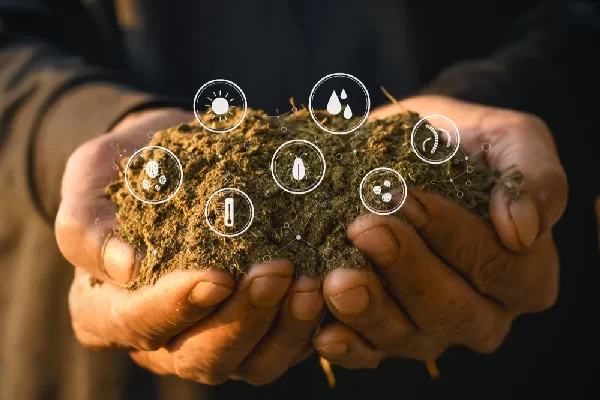
The bio composting process will be completed in 15 to 20 days with the help of fermentation bacteria and bio fertilizer compost turners.
How to determine whether compost can be used for bio fertilizer production?
Ripe bio compost has a dark, crumbly texture and a pleasant earthy smell. This indicates the end of the process of bio compost. To prepare the compost for use as raw material of 5 t/h biofertilizer production line, you should screen it to remove any large particles or contaminants. It can then be made into powdered or granular bio organic fertilizer.
Granular biofertilizers are popular with customers because of their ease of storage and application. Bio fertilizer granulator is an important equipment for making biofertilizer in granule form. For high-quality biofertilizers manufacturing, you can prepare from three aspects: raw material preparation, granulation process selection, and drying and cooling biofertilizer pellets.
Top 3 pelletizer machine used to make biofertilizer in granular form:
To make biofertilizer in granular form, you can choose to use different biofertilizer granulators with unique granulation methods. The following are three hot-selling granulation equipment:
The disk granulator
The disk pelletizer adopts wet granulation, which makes biofertilizer particles through the rotation of the disk and the action of gravity.
The roller extrusion granulator
The roller extrusion granulation equipment adopts dry granulation. Extrusion of two rollers to form uniform size particles.
The drum granulator
In addition, the drum granulator is also the wet granulation of aggregates. It is by means of the rotating movement of the cylinder to produce extrusion pressure between the materials and aggregate into balls.
How to make high-quality bio fertilizer pellets ?
Maintain the moisture content of the raw materials at around 30% to prevent excessive moisture from causing mold sticking and clogging of the biofertilizer granulation equipment.
Select the appropriate biofertilizer granulation method according to the material characteristics. Such as disc granulation, drum granulation, roller extrusion pelleting, etc. In the granulation process, strictly control the process parameters to ensure uniform shape and consistent size.
You need to dry the bio fertilizer pellets after granulation. It is beneficial to reduce the moisture content and prevents excessive microbial growth or granule mildew during storage. The dried granules should be cooled in time for subsequent packaging and storage.
Can I customize the bio fertilizer pellet shape and size?
Of course. Usually, drum granulators and disc pelletizers can produce round bio fertilizer granules. With roller extrusion granulation, you can customize a variety of granule shapes such as cylindrical, spherical, and flake. The principle is to engrave precisely designed grooves on the surface of the roller. The shape, size, and arrangement of these grooves can be customized according to your requirements. You can get the ideal size (2-10 mm) biofertilizer pellets with YUSHUNXIN’s granules making machine.
How to make microbial fertilizer from organic waste compost is something that many start-up bio fertilizer manufacturers want to know. Today, you can learn about the general biofertilizer production process, the precautions in prepare compost and the important equipment commonly used in bio organic fertilizer production. If you are interested, please contact us.
What is the most important equipment in producing microbial fertilizer?
Bio fertilizer composting machine
The production of good biofertiliser compost needs regular monitoring and timely adjustment. First, the use of biofertilizer compost turner to turn the compost regularly. When the temperature exceeds 60℃, the turning machine can start to work. Second, buy a biological fertilizer fermenter. The advantage of fermenters is that they have a small footprint and do not produce odors during fermentation. Moreover, the machine can automatically control factors such as temperature.
Bio fertilizer compost shredder
The role of biological fertilizer crusher has two aspects: First, grinding biological fertilizer raw materials. This increases the area of contact with oxygen and speeds up fermentation. Second, crush the fermented compost. This can be packaged directly or granulated in the next step.
Biofertilizer granulator
To better make microbial fertilizer, the choice of bio fertilizer granulator is also very important. For large yield biological fertilizer production line, drum granulator is a good choice. The disk granulator is suitable for small-scale biological fertilizer plants. YuShunxin has many types of bio fertilizer granulation equipment. You can select it according to your bio organic production line.
Liquid biofertilizer is an organic fertilizer made from microbial cultures and organic materials. It is rich in beneficial microorganisms that can improve soil fertility and promote plant growth. How to make liquid bio fertilizer has become a concern of many people. In general, liquid biofertilizer technology requires special attention to raw material handling and proportioning.
The most common liquid biological fertilizer feedstock is animal manure. For animal waste, you need to set up a sedimentation tank to get a lot of liquid. Next filter the liquid for impurities. This is because liquid bio organic fertilizer requires piped irrigation to prevent impurities from clogging irrigation nozzles.
Sterilization is the most important step in the production of liquid biofertilizers. It kills E. coli and diseased eggs in the liquid by UV overstream sterilization.
Use a liquid fermenter, heat internally and ferment for 3 days. At the same time, you need to parallel one auxiliary adding tank. This is to add liquid fermentation bacteria or molasses to add energy to the fermentation.
The next step is to add cans using ingredients. You can add nitrogen, phosphorus, potassium or biological strains to improve the effectiveness of biofertilisers.
Tips for producing liquid biofertilizer:Precise ratio
It is the common way to make liquid bio fertilizer. If you need related equipment, please contact YUSHUNXIN, we have a complete set of liquid biological fertilizer production line. In addition, we have powdery and granular biofertilizer production line. Welcome to inquire.
The cost of biological fertilizer plant is a problem that most bio fertilizer manufacturers need to consider. The production line of the 5 ton biological fertilizer plant includes biofertilizer composting machine, crusher, screening machine, granulator, dryer, and cooler. Their cost varies according to the production line configuration.
What are the types of production lines of the 5 t/h biological fertilizer plant?
Production line of powdered biofertilizer
The production process of powdered bio fertilizer is simple. If you are on a limited budget, you can choose to purchase a 5 ton powdered bio fertilizer production line. The line costs about $45,000. In addition, you should also take into account other costs such as shipping costs, labor costs, etc. On the other hand, the production line covers an area of about 1500 ㎡.
Granular biofertilizer production line
Groove type composting machine:
You need to establish a fermentation tank in advance. The machine can quickly and evenly turn the bio fertilizer compost. So, with its help, the biological fertilizer compost fermentation cycle can be reduced to 15-20 days.
SXFLF-600 compost shredder:
Pulverize large pieces of material in the compost in order to enter the next process faster.
SXGS-1240 Roller screening machine:
Screen out impurities in compost, such as small rocks. And, screen out the bio fertilizer that meets the requirements of the merchant.
SXYZ-3600 biofertilizer granulator:
Converts powdered bio fertilizer into pellets. At the same time, the particle size is adjustable.
Rotary dryer:
Dry microrganism fertilizer particles to avoid clumping.
The above is only the basic configuration and cost of 5 tons of biological fertilizer factory, for reference only. If you have the idea about setting up the bio organic fertilizer production line, please contact us.
When choosing a suitable bio fertilizer equipment manufacturer, you can consider from five aspects. They are product quality, technical strength, after-sales service, High credibility, and price cost . Here is some information about them.
Product quality
The product quality of biological fertilizer equipment is directly related to the use effect and life of the equipment. Good bio fertilizer equipment manufacturer will use high quality raw materials, in strict accordance with relevant standards and regulations for production and manufacturing, to ensure that the equipment has stable performance, efficient operation and long-term durability.
YUSHUNXIN’s biological fertilizer equipment is made of Q235 carbon steel, which is corrosion-resistant and hard in texture. Moreover, most of the blades are made of manganese steel, which is an excellent material for crushing and mixing parts.
Technical strength
Technical strength is the basis for the production equipment of high quality bio fertilizer equipment manufacture. Manufacturers with strong technical strength have a professional R & D team and a team of engineers. At the same time, they are able to continuously make technological innovations and improvements to introduce more advanced and efficient microbial fertilizer equipment.
YUSHUNXIN has a high-level engineering and technical team, with more than 80 professional engineers around the world. At the same time, we maintain long-term cooperation with a number of research institutes, and employ a number of senior people in the field as consultants. If you choose YUSHUNXIN, we will communicate with you deeply about the construction plan. Professional engineers draw on site to meet differentiated construction needs.
Price factor
You can choose a microorganism fertilizer production equipment manufacturer with a relatively low price according to your budget. This can help you reduce production costs and improve economic efficiency. You can also choose a biological fertilizer manufacturer that regularly offers discounts and promotions, such as bulk purchase discounts, seasonal promotions, etc.
By taking advantage of these offers, you can further reduce the purchase cost of biofertilizers. YUSHUNXIN will have discount activities in a specific period of time, which can help you save costs.
High credibility
You need corporate reputation and credibility to know a bio fertilizer equipment manufacturer. This can help you evaluate their product quality and service level. At the same time, choosing a manufacturer with good reputation can reduce the risk of cooperation. YUSHUNXIN has more than 20 years of experience in production equipment. The equipment exports to more than 100 countries and regions around the world. Customer satisfaction is high. At the same time, our company took the lead in passing the ISO9001-2015 quality system certification, and all indicators reached the national standards.
After-sales service
When choosing a bio fertilizer equipment manufacturer, after-sales service is also worth examining. After-sales service is the performance of biofertilizer manufacturers responsible to customers. Excellent microbial fertilizer equipment manufacturers will provide comprehensive after-sales service, including equipment installation and commissioning, training operators, regular maintenance, technical support, etc.
They will respond to customers’ problems and needs in a timely manner, solve various problems in the use of equipment, and ensure that the equipment can run stably. If you have any questions about the equipment, you can contact the staff of our company, we can reply to you in time to help you answer questions.
According to the different type of biofertilizer, the 10 t/h organic bio fertilizer plant cost is different. It generally is between $60,000 and $70,000 or $350,000 and $380,000. In addition to the basic equipment cost, you also need to consider labor, equipment material depreciation rate and daily maintenance costs for your 10 tons/hour biofertilizer manufacturing factory. The following prices are for reference only, please consult for details.
How much does a 10 t/h powdered organic bio fertilizer plant cost?
The cost of setting up a 10-ton powdered bio organic fertilizer production line typically ranges from $60,000 to $70,000. The basic configuration of the production line includes a forklift feeder, a double wheel type composting machine, an SXFLF-1000 new vertical crusher, an SXGS-1870 rotary drum screener, a single-bucket automatic packing machine, and belt conveyor etc. YUSHUNXIN can customize the 10 t/h powdered biofertilizer making system according to specific requirements.
Contact us today to learn more about how you can establish your own powdered bio organic fertilizer production line at an affordable cost.
how much does granular bio fertilizer producing machinery cost (10 t/h)?
The cost of establishing a 10t/h granular organic biofertilizer production line typically falls between $350,000 and $380,000. Building upon the foundation of a 10t/h powdered line, the production system involves selecting suitable granulating equipment such as the SXZGZ-2080 rotary drum granulator or two SXYZ-3600 disc granulators, along with drying and cooling equipment, coating machines, double bucket packaging machines, and more. Compared with a low-budget powdered biofertilizer factory, investing in a 10 t/h granular organic biofertilizer manufacturing plant is more profitable and more conducive to global export.
Welcome to consult us to explore how you can establish your own bio organic fertilizer granulation line at a competitive cost.
3 key factors affect the 10 tons/hour organic biofertilizer manufacturing plant cost
Labor cost:
The highly automated 10t/h organic bio fertilizer production line requires only 3-5 workers in YUSHUNXIN. The specific labor cost depends on the salary and benefits standards in your area. The central control system coordinates tasks from raw material preparing to packaging final biofertilizer product. It can eliminate the need for frequent manual intervention. This reduces errors and lowers labor costs, making the biological organic fertilizer plant cost-effective.
Raw material cost:
Our high-quality 10t/h organic biofertilizer equipment boasts a low 4% raw material loss rate, saving you substantial organic bio fertilizer plant costs. The 10 tons/hour biological organic fertilizer making line features a precise batching system with minimal ingredient errors due to high-precision measuring devices. The finely processed equipment ensures long-term stable operation, greatly reducing bio organic fertilizer plant cost.
Biofertilizer equipment maintenance cost:
Generally speaking, YUSHUNXIN’s 10t/h organic biofertilizer machine has a lifespan of 10-15 years. To ensure long-term operation, it is necessary for you to daily maintenance and regular replacement of key components. Such as drum sieves, turning machine tines, and bearings etc. These are also part of the 10 t/h organic bio fertilizer plant cost.
Expect for the 10 t/h bio organic biofertilizer production line, YUSHUNXIN can also customize other bio fertilizer production business plans of different capacity and budget. Such as 5 tons/hour manure biofertilizer business plan, bioliquid fertilizer production unit, and more. Feel free to contact us!
Formulation of biofertilizer formula
You should design the nutrient ratio of N, p, k or medium and trace elements and the total nutrient content range (generally in the range of 6%-25%) according to the bio fertilizer characteristics of different crops. Functional microorganisms and organic matter play an important role in nutrient efficiency, promoting growth and yield, enhancing resistance, improving soil and protecting environment. Therefore, under the premise of ensuring increased production, the biofertilizer production project design should consider the functional characteristics and effective viable bacteria number of selected strains according to the needs of fertilizer nutrient formulas.
Strengthen dilution function
From the perspective of production needs, powders and granules are generally used as base fertilizers, and have good slow-release function. In order to play a greater fertilizer effect of biofertilizer, you should adjust functional bacteria, organic materials and fertilizer raw materials and their proportions according to factors such as crop fertilizer requirements, soil characteristics, precipitation. This is conducive to the production of nutrient release and crop nutrient absorption rules in line with the microbial fertilizer. Such ability can effectively improve nutrient utilization.
Optimize the process route
In the biofertilizer production project design, optimizing the production process is the key to ensure the product quality. At present, the production of biofertilizers mainly has three process routes: liquid, powder and granule production. You should optimize the appropriate production process route according to the characteristics of strain fermentation and product dosage form.
Liquid production
Liquid production process is simple and easy, high production efficiency, high degree of automation, controllable quality. The main equipment is: fermenter, air filtration equipment, thermal power equipment and so on. The fermented liquid fermentation tank after the inspection, according to the nutrient formula to add a certain amount of water soluble inorganic nutrients. Then, you will get the liquid biological fertilizer.
Powder production
Powder biofertilizer product process equipment is simple, small investment. Organic waste fermentation can be outdoors or in fermentation tank, request to control temperature and ventilation. This can be achieved by heating units and tipping machines. After solid fermentation, after grinding, low temperature drying, you can mix a certain amount of biological bacteria according to the ratio of nutrients, and then quantitative packaging, you can make powder bio fertilizer.
Granules production
Granules production process is on the basis of the powdery production process, add the granulation process. After the completion of granulation drying cooling, and then by automatic packaging weighing quantitative packaging. The main equipment has an additional granulator, therefore, the cost has also increased.
Adding method of bactericide
Maintaining the activity of functional microorganisms is a noteworthy point in the biofertilizer production project design. Granular biological fertilizer should go through the high temperature granulation process. And there are three ways to add bacteria: adding before granulation, adding during granulation, and spraying after granulation.
The first two kinds of functional bacteria are affected by high temperature, and the mortality rate is higher. The survival rate is less than 70%. Generally, spraying after granulation has a high survival rate. But in order to prevent the loss of bacterial agent nutrients, you can use a coating machine for coating.
Establishing a biological fertilizer production line need to consider many factors, such as biofertilizer plant cost, scales, and required area for a biofertilizer plant. The required area for a biofertilizer plant depends on the output and production line. Generally speaking, the powdered microbial fertilizer plant needs 800-5000 ㎡ of site. However, the granular biological fertilizer site is about 2000-10000 ㎡. If you have limited space, you can adjust the fermentation area and use energy-efficient equipment and other ways to solve. Of course, you can also send us your requirements. YUSHUNXIN can help you plan the production line, more rational use of space.
Main powder biological fertilizer plant covers an area
The production process of powdered biological fertilizer is relatively simple. And there is not much equipment required, only including fermentation composting machines, automatic feeders, vertical shredders, screening machines, packaging machines, and belt machines or bucket elevator. So you can plan a smaller footprint. But you also have to design according to the yiled.
If your output is about 1-5 tons per hour, you need to prepare 800-1500 square meters of space for production. However, if you want to build a medium-sized microorganism fertilizer plant that produces 5-10 tons per hour. The required area for a biofertilizer plant is about 1500-2000㎡.
In general, the large powdered biological fertilizer plant can produce 10-20 tons of powdered bio fertilizer per hour. Its floor area is between 3000-5000 square meters.
Main pellet biological fertilizer plant area
The production steps of granular bio fertilizer are more complicated and require more equipment. As a result, more areas are needed to house the relevant production equipment. Such as fermentation compost equipment, feeder, crusher, screening machine, batching machine, granulation machine, drying and cooling equipment, re-screening machine, rotary coating machine, automatic packaging machine, belt machine.
Under normal circumstances, the production of 1-5 tons of granular biofertilizers per hour requires a small footprint. 2000-4500㎡ is enough. However, with the expansion of capacity, the area occupied by medium sized fertilizer plants of 5-10 tons per hour has also changed. It needs 4500-5000㎡. The large scale pellet microbial fertilizer plant generally needs to two granulation equipment. It usually can produce 10-20 tons of bio fertilizer per hour. You need to prepare 5,500-10,000 square meters for it.
How to save the floor space of biological fertilizer plant ?
Setting of fermentation area:
First, you can use underground fermentation. Underground fermentation can place fermentation equipment, storage equipment and other facilities in the underground space, make full use of the underground space, and reduce the ground occupation area.
And for the transportation of raw materials after fermentation, the use of bucket elevators is a fast and efficient choice. In addition, you can set up the fermentation area and the production area separately.
Moreover, you can stack the fermentation area outdoors to save space in the plant. At the same time, you can also choose a fermenter to ferment raw materials. It occupies a small area, has a good fermentation effect, and is not affected by external temperature.
Using energy-saving and efficient equipment:
The use of energy-saving and efficient equipment is one of the important measures to save the required area for a biofertilizer plant. Select production equipment with high efficiency and energy saving performance, such as high efficiency fermenter, high efficiency mixer, high efficiency granulation equipment, etc. These devices can reduce energy consumption and increase production efficiency during the production process, thus reducing the number of equipment and floor space required.
Merchants will add a certain amount of bacteria agents in the production of biofertilizer. However, there are some requirements for bacterial adding in biofertilizer production technology. You need to conduct harmless treatment of raw materials first and select excellent strains. At the same time to separate functional bacteria and fermentation bacteria, choose suitable functional bacteria dosage forms. Also pay attention to the temperature and time in the drying.
harmless treatment of raw materials
The raw materials of bio organic fertilizer production are mainly livestock manure, crop straw, industrial waste, domestic waste, urban sludge, plant litter and other waste. They contain a large number of toxic and harmful substances and pathogenic bacteria. In order to prevent the application of manufactured products into the food chain, critical food safety or environmental pollution, raw materials must be harmless treatment before they can be used as biological organic fertilizer substrate raw materials. Under normal circumstances, fermented compost is one of the most common ways of harmless treatment of microbial fertilizer raw materials.
Selection of excellent strains
The quality of bio organic fertilizer mainly depends on the number of viable bacteria and the function of beneficial microorganisms in the fertilizer.
Optional with high temperature resistance, salt resistance, low oxygen resistance, drought resistance, acid resistance, alkali resistance and other characteristics. At the same time, it has the functions of nutrition promotion, maturation and transformation, degradation and repair, fertilizer and soil improvement, and to ensure the effective number of viable bacteria of the product. This is the heart of bacterial adding in biofertilizer production technology.
Besides, in the addition of biological bacteria, it is necessary to carefully select the appropriate strain combination. Avoid adding incompatible or competitive strains together to ensure the effect and stability of the addition of biological bacteria.
Separate delivery of functional bacteria and fermentation bacteria:
Functional bacteria are generally not resistant to high temperatures. It is difficult to grow and reproduce at high temperatures above 60℃. However, in the high temperature stage of organic material maturation and fermentation, it will produce a high temperature of more than 60℃ for 5-7 days. If the functional bacteria and fermentation bacteria are mixed for fermentation, most of the functional bacteria will die due to continuous high temperature.
This will affect the effective viable bacteria number of the product and reduce the biological fertilizer efficiency. Therefore, in actual production, you need to put functional bacteria and fermentation bacteria separately. That is, organic materials first add putrefactive agent to promote putrefactive fermentation, and then add functional bacteria after putrefactive. The addition process of functional bacteria has a variety of situations, you can choose according to your needs.
Select the appropriate functional dosage form
The difference of functional bacteria has great influence on its function. In order to ensure the effective number of viable bacteria in the microbial fertilizer, you should choose the appropriate dosage form of bacteria. This is conducive to extending the shelf life of the product. At the same time, it is one of the key measures of biofertilizer production technology. If you want to can directly use of the biological fertilizer production, you can choose the powdery bacterium agent. They can be directly after mixing fertilizer.
Drying process
In the process of granulation drying, in order to reduce the mortality of functional microorganisms, the drying temperature should not be too high. In addition, the drying time should not be too long. Generally, the appropriate drying temperature is 85-90℃. Suitable drying time is 15-20 minutes.
There are more than 150 types of bacteria used in microbial fertilizer production. They can be divided into nitrogen fixing bacteria, potassium solubilizing bacteria, phosphate solubilizing microorganisms, antibiotic functional bacteria and enzyme producing bacteria according to their functions. In the process of bacteria used in microbial fertilizer production, you need to choose the right type of microbial agent according to different soil types and crop needs. Ensure that the selected bioagent is beneficial to the target plant and can adapt to local environmental conditions. This is the best way to get the best results from the addition of biological bacteria and improve the quality of the crop.
Enzyme producing bacteria
Enzyme producing bacteria can secrete various enzymes. It can effectively degrade organic matter, decompose organic matter into nutrients absorbed by plants. At the same time, it also can accelerate the decomposition and transformation process of organic biofertilizers. Common enzyme producing bacteria mainly include the following categories: protease producing bacteria, amylase producing bacteria, cellulase producing bacteria. They all break down organic matter to provide nitrogen, carbon and glucose sources for plant growth, respectively.
Antibiotic functional bacteria
In microbial fertilizer production, people also usualluy use antimicrobial functional bacteria. Streptomyces is an important genus of actinomyces, which can produce many active substances such as antibiotics and plant hormones. It is an antimicrobial functional bacteria that plays an important role in improving the resistance and stress resistance of plants. It mainly includes Bacillus subtilis, trichoderma, rhizobia and so on. The mycelium of Streptomyces has many branches. And this genus has the most species, which can produce a variety of antibiotics.
Phosphate solubilizing microorganisms
The main function of phosphorus solubilizing bacteria in biological fertilizer is to help plants effectively absorb phosphorus in soil. These phosphorus solubilizing bacteria can secrete phosphatase, by degrading insoluble phosphate, convert it into phosphate that can be absorbed and used by plants. Depending on the phosphate solubilizing bacteria to break down the substrate to organophosphorus them into microorganisms and inorganic phosphorus. When adding bio fertilizer agents, you need to consider factors such as soil type, organic matter content and cultivation methods to add different phosphorus solubilizers.
Potassium-solubilizing bacteria
Potassium functional bacteria is a kind of bacteria that can decompose aluminosilicate and apatite minerals. Potassium bacteria can be used as microbial fertilizer to promote the conversion of insoluble potassium, phosphorus, magnesium and other nutrients into soluble nutrients, and increase the content of available nutrients in soil. There are mainly Bacillus siliceous, Bacillus extorquens, Bacillus circulans and so on. The silicate bacteria is a kind of colloid bacillus, is a common biological fertilizer releasing from microorganisms.
Nitrogen-fixing bacteria
Nitrogen-fixing bacteria can provide nitrogen source for plants through nitrogen fixing in biofertilizers. In addition, nitrogen-fixing bacteria can convert nitrogen in the atmosphere into nitrogen compounds, such as ammonia, nitrate. It is easy for plants to absorb. So, It can provide sufficient nitrogen source supply for plants. Common nitrogen-fixing bacteria mainly include rhizobia, non-nodule nitrogen-fixing bacteria, blue-green algae and so on. At the same time, the nitrogen-fixing bacteria species can be according to the way of life, the demand for oxygen, etc into the classification.
Most bioorganic fertilizers are made of decomposed organic materials as the base material, adding microbial agents, and then mixing with chemical fertilizers. Bio organic fertilizer mainly has two dosage forms: powder and granule. Therefore, the biofertilizer production process for microbial adding includes powder functional bacteria and granule functional bacteria. Microbes in the process of biological fertilizer production should pay attention to during the process of adding control of temperature, moisture, organic matter.
Powder functional bacteria addition process
According to certain formula, will crush after fermentation of organic materials mixed with humus powder. Then you add a certain amount of functional bacteria agent distribution, repackaging, after drying can be made into products. You can use equipment such as dynamic feeders and mixers to complete the powder function.
Granular biofunctional inoculant addition process
In the production of biological organic fertilizer granules, add fertilizer functional bacteria technology, according to the functional bacteria added time is divided into the following three:
Add before granulation
Organic materials and functional bacteria agent according to certain formula mixed, and then sent to the granulator granulation. Granulation of the biological fertilizer after drying, cooling, screening, packaging, will be able to become a finished product.
Add in the granulation process
Add a certain amount of humic acid powder into the organic material powder and stir evenly through a horizontal mixer. And then sent to the granulator granulation, in the process of adding microbial agents. Therefore, you’d better choose a granulation equipment with a spray device, such as a drum granulator, a disk granulator. After drying, in order to maintain the activity of the biological bacteria agent, it is necessary to cool down in time to ensure the quality of the microbial fertilizer.
Add after granulation
In granulation and qualified in accordance with the ratio of biological fertilizer spraying function of a certain amount of liquid agent. In order to remove moisture and retain the activity of bacteria agent, it needs to go through low temperature drying and screening. Then use a single or double bucket automatic packing scale to complete the final stage of microorganism fertilizer production.
Temperature control:
Temperature is one of the important factors restricting the growth of microorganisms. Commonly used functional bacteria are generally suitable for growth temperature of 20-40℃, not high temperature. The higher the temperature, the faster the microbial death rate. Therefore, biofertilizer production process for microbial adding requires that the carrier temperature should be below 50 ° C after the addition of functional bacteria.
Organic control:
Organic matter contained in organic materials is the living environment of functional bacteria and the nutrient source required for production. In order to ensure the normal growth and reproduction of functional bacteria, the organic matter content of the total material should be more than 30%, preferably 50%-70%; C/N is (30-35) : 1, which reaches (15-20) : 1 after decomposition.
Composting is the preparation work for bio fertilizer production, and seeking the best way to make compost with organic biofertilizer has become a hot topic. There are aerobic fermentation and anaerobic composting methods for biological fertilizer composting. At the same time, you can choose slot compost or strip compost. In addition, when composting, you should pay attention to choosing the right raw materials and composting methods, so as to turn the pile regularly, and control the temperature and humidity. The best method to make compost with organic biofertilizer is to choose the one that suits you.
Processing methods for making biological compost
Aerobic composting method
Aerobic composting is a composting method that uses oxygen to decompose organic waste. In aerobic composting process, will waste sits inside ventilation good compost heap, through continuous turning and ventilation, keep the stockyard in sufficient supply of oxygen. The heat generated during the aerobic composting process helps kill pathogenic microorganisms and weed seeds. This makes the compost more stable and mature. It also reduces the production of odors and harmful gases. In order to better increase the oxygen content of compost, we recommend that you use relevant composting equipment. Such as wheel type composting machine, groove type compost turner, etc.
Anaerobic composting method
Anaerobic composting is a composting method that uses anoxic environment to decompose organic waste. In the anaerobic composting process, organic wastes are stacked in closed or semi-closed containers or compost piles. So that the lack of oxygen in the pile material. In this environment, organic waste by anaerobic microbes, to produce biogas and organic matter decomposition product. Anaerobic fermenter is a typical representative of anaerobic fermentation.
What are the forms of biofertilizer compost ?
Generally speaking, the best way to make compost for organic biofertilizer is aerobic fermentation. That is, the formation of a good compost pile. There are usually two types of compost piles, one is slot stacking, and the other is strip stacking.
Slot stacking refers to a composting method in which organic waste is stacked in rectangular or square troughs enclosed by walls. Placing organic waste in a tank allows for better control of the temperature of the compost and prevents the effects of too cold or too hot temperatures on the compost. At the same time, you can place the trough turnover machine on both sides of the fermentation tank for regular turnover work. This increases contact with oxygen and speeds up fermentation.
Strip composting is the accumulation of organic waste in long strips. The crib composting by site constraints is small, the required construction cost less. The regular turning of compost is carried out by using the windrow composting machine. This can enhance the ventilation of compost, promote the microbial decomposition activity and shorten the fermentation period. The fermentation usually takes about 20 days to complete.


